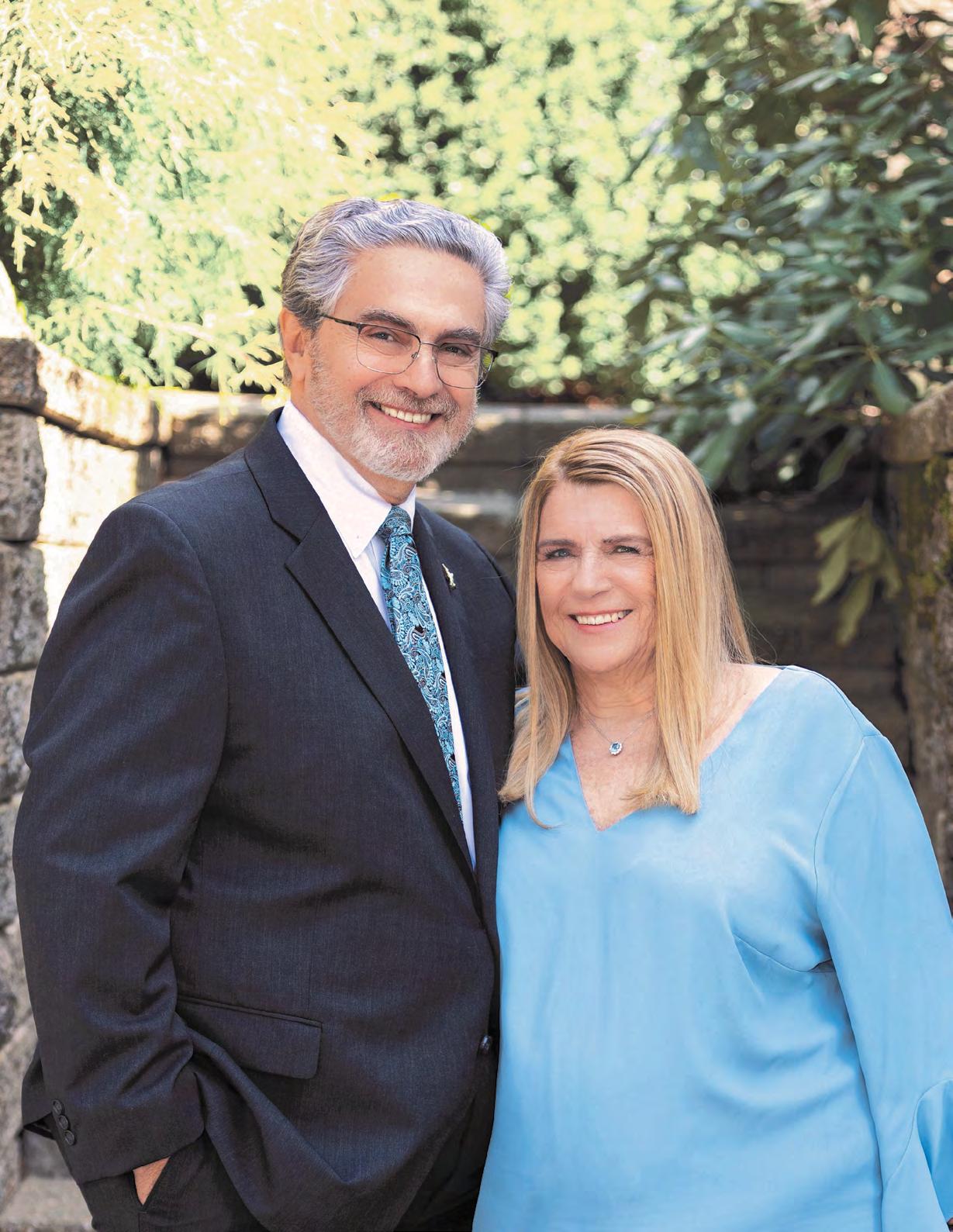
the new york state dental journal JUNE/JULY 2 023 Volume 8 9 Number 4
PRESIDENT Anthony Cuomo
Advocate for Collaboration & Inclusion
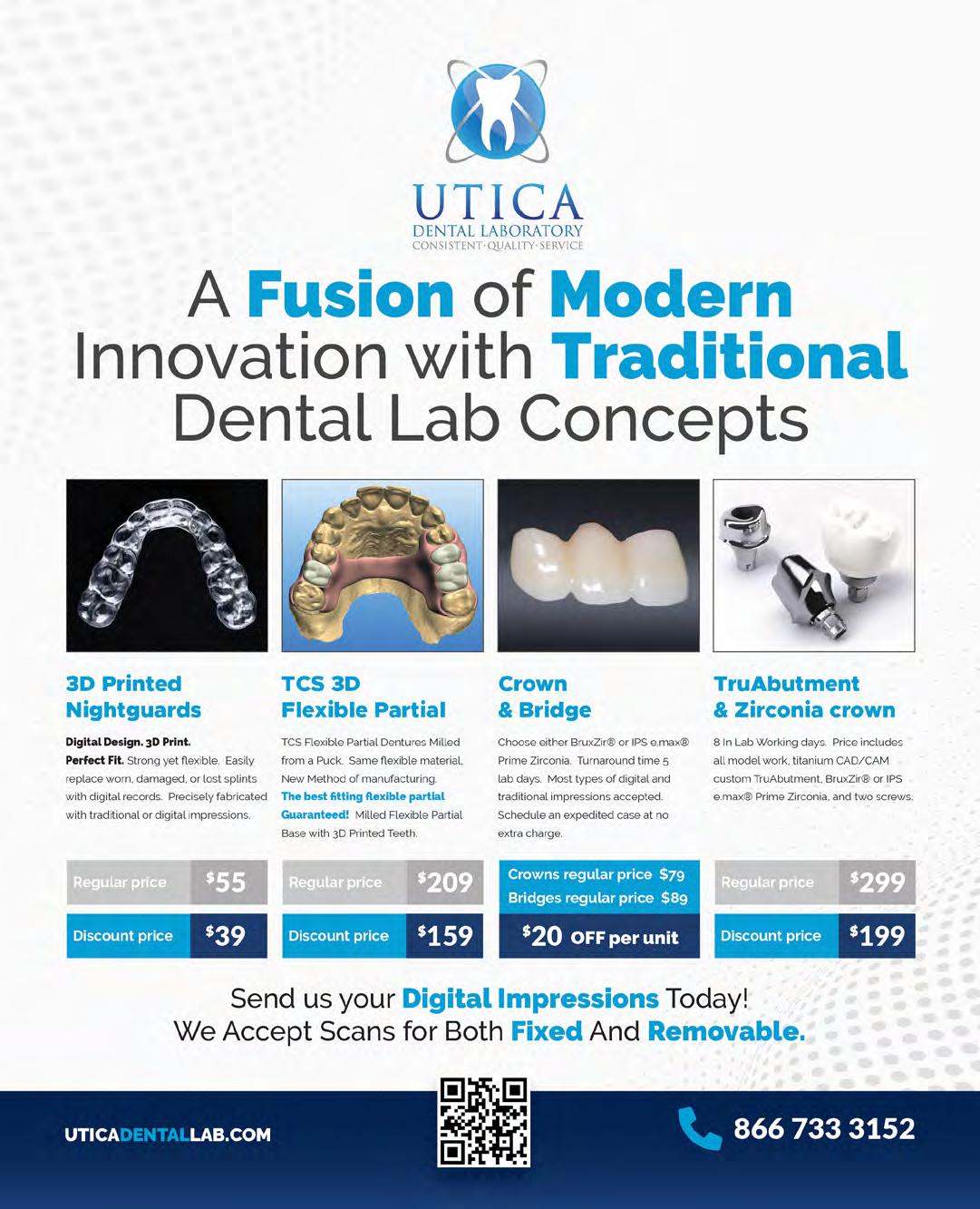
The New York State Dental Journal is a peer reviewed publication. Opinions expressed by the authors of material included in The New York State Dental Journal do not necessarily represent the policies of the New York State Dental Association or The New York State Dental Journal. EZ-Flip version of The NYSDJ is available at www. nysdental.org
12 The Welcome Sign is Out
NYSDA’s newest president vows to lead an organization and profession open to all.
16 Understanding Persistent Bleeding
in Children
Bret Lesavoy, D.M.D.; Christine Wang, D.D.S.; Richard Yoon, D.D.S. Mild bleeding following dental procedures or tooth exfoliation is not an unusual occurrence; however, persistent bleeding is an uncommon event for patients, even more so among pediatric and adolescent patients. Review of literature and report of three cases.
22 Sinus Tract vs. Fistula
There is a Difference
Mea A. Weinberg, D.M.D., M.S.D., R.Ph.; Stuart Segelnick, D.D.S., M.S.; Christine Chu, D.D.S.; Asgeir Sigurdsson, D.D.S., M.S.
The terms sinus and fistula have been used interchangeably in clinical dentistry, but it may be inconsistent with past and current literature. Authors review the clinical and histological features of a sinus and a fistula in dentistry and medicine.
26 What is the Prevalence of Temporomandibular Joint (TMJ) Condylar Osteoarthritis in an Asymptomatic Oral and Maxillofacial Surgery Department Population?
John Vorrasi, D.D.S.; Laura Mendomo Mvomo, B.S.
A retrospective review of cone-beam computed tomography scans of 272 TMJs from 136 consecutive patients was undertaken to detect osteophyte subchondral cyst, sclerosis, cortical erosions and flattening in effort to determine prevalence and demographics of TMJ condylar changes in asymptomatic general population.

Volume 89 Numbe r 4 June/July 2 023 the new york state dental journal 2 Editorial Ensuring mental preparedness 6 Attorney on Law What’s new 10 Association Activities 30 General News 38 Component News 46 Read, Learn, Earn 48 Classifieds 49 Index to Advertisers 52 Addendum Hygiene standouts
Cover: The New York State Dental Association welcomes Anthony M. Cuomo, D.D.S., its 143rd president, and wife, Patricia.
Photo by Kristen Jensen Productions, LLC
and can be downloaded to mobile devices.
Picking up the Pieces of the Dentist Mental Health Puzzle
Dentistry: a dream career only for those willing to accept its professional challenges and able to manage the inherent stress.
“DENTIST ranked top job.” Similar headlines extolling the virtues of a career in dentistry appear periodically on the internet and in newswires. They imply that dentistry’s high median salary, low unemployment and professional autonomy make it a dream profession. Yet, recent studies report dentists suffer from dramatically increasing diagnoses of anxiety disorders and rates of depression, significantly greater than the general population.[1] We can, in part, attribute this enigma to a general misconception of the demands upon dental practitioners, our profession’s failure to prepare dentists for the psychological and stress-related challenges of private practice, and dentists’ unwillingness to timely seek mental health counseling.
Dental educators and organized dentistry must assist predental candidates to determine whether they are cut out for dental practice, teach predoctoral dental students to better recognize and cope with stress and, together, work to eliminate the existing stigma associated with participating in mental health assistance programs.
Fitness for Dental Practice
Dental practice demands the dedication of a calling beyond that of a mere job, and society offers many other better opportunities to make more money faster. No doubt, dentists who embrace their pro-
fessional responsibilities enjoy great personal satisfaction and comfortable financial remuneration. For them, dentistry is a dream profession. However, dentists who use dentistry to pursue wealth as an end in itself and attempt to avoid the unavoidable commitments required of our vocation will face greater work-related stress, financial dissatisfaction and risk of mental health challenges.
Applicants to dental school should understand that practicing dentists espouse to a purpose above wage earning before the prospective dental students make their career choice. Dentists promise to place the best interests of their patients above our self-interests and the best interests of society above those of our profession to meet our ethical and professional responsibilities. We must practice to the standard of care and comply with regulatory mandates to meet our legal duties. These duties require us to dedicate ourselves to helping others above personal gain and often contribute more than we receive. Practitioners who attempt to circumvent these principles in the search for higher income suffer the constant threat of disciplinary, ethical, and legal complaints and investigations and earn the negative reputation of using patients to serve their own interests.
Once dental school applicants understand and accept their professional role, they must recognize the inherently stressful, physical and
editorial
2 JUNE/JULY 2023 The New York State Dental Journal
psychological circumstances under which they will perform. Dentists routinely provide technique-sensitive procedures, with a microscopic margin for error, that can induce pain in a sensitive, inaccessible area of the body of a fearful, worried patient. To accomplish these daunting tasks, the practitioner must think critically, exercise good clinical judgment, humbly recognize and correct their own errors and earn the trust of the human beings we treat. Applicants who honestly self-assess their willingness and ability to undertake these unique responsibilities will better cope with the inevitable mental health challenges.
Dental service organizations claim to offer relief from some of the business stressors of practice ownership. However, no corporate dental practice owner, with their sales pitch to take care of the management side while the employee dentists just do dentistry, can fully eliminate all of the financial pressures on clinical performance or, more importantly, dentists’ inescapable ethical and legal commitments. Incoming dental students must intend to embrace, not evade, professional responsibility as a minimum threshold of fitness for practice.
The dental profession must rebut misportrayals of dentistry as an easy job guaranteed to make you rich. Our profession must better inform the media, public and, specifically, college students that dentistry is a dream profession, not due to the good pay for accepting minimal responsibility, but precisely because of the challenging professional commitments we must accept. The autonomy we enjoy, in return for successfully meeting these commitments, enables us to help our patients and form bonds with them that create the greatest satisfaction of the practice of dentistry. In the end, we accept whatever money comes from acting in the best interests of our patients.
The dental school interview and selection process should reinforce applicants’ understanding of the expectations they must meet. Although everyone should have the opportunity to serve as a dentist, a career in dentistry is not for everyone. Some applicants may prefer not to hear about or think they can avoid dentists’ professional responsibilities, but they are entitled to know all aspects of their potential role.
Stress Management Training for Dental Students
Uncontrolled psychological and physical stress threatens dentists’ general and mental health. Left unchecked, this distress can lead to negative behavioral changes, including, among others, anxiety disorders, depression and substance abuse. This downward spiral ultimately interferes with our ability, as practitioners, to deliver quality care to our patients. As a preventive measure, dental school curricula must incorporate stress management training early in the predoctoral program to help students identify the sources and signs of stress and better manage professional challenges.
Historically, the dental literature has featured extensive information on the sources and effects of stress in dental practice, but minimal and inadequate research on the methodologies and effec-
EDITOR
Chester J. Gary, D.D.S., J.D.
MANAGING EDITOR
Mary Grates Stoll
ADVERTISING/SPONSORSHIP MANAGER
Jeanne DeGuire
ART DIRECTOR
Ed Stevens
EDITORIAL REVIEW BOARD
Frank C. Barnashuk, DDS. Past Clinical Assistant Professor, Department of Restorative Dentistry, School of Dental Medicine, University at Buffalo, The State University of New York, Buffalo, NY.
David A. Behrman, DMD. Chief, Division Dentistry/OMS, Associate Professor of Surgery, New York Presbyterian Hospital, Weill Cornell Medicine, New York City, NY.
Michael R. Breault, DDS. Periodontic/Implantology Private Practice. Schenectady, NY.
David Croglio, DDS. Clinical Assistant Professor, University at Buffalo School of Dental Medicine. Private Practice, Amherst, NY.
Joel M. Friedman, DDS. Associate Clinical Professor of Dental Medicine. Columbia University College of Dental Medicine, New York, NY.
Jennifer Frustino, DDS, PhD. Director, Oral Cancer Screening and Diagnostics, Division Oral Oncology and Maxillofacial Prosthetics, Department of Dentistry, Erie County Medical Center, Buffalo, NY.
Michael F. Gengo, DDS. Board Certified Endodontist, Clinical Assistant Professor, Department of Endodontics, School of Dental Medicine, University at Buffalo, Buffalo, NY. Private Practice, Hamburg, NY.
G. Kirk Gleason, DDS. General Dental Practice (retired), Clifton Park, NY.
Kevin Hanley, DDS. Orthodontic Private Practice, Buffalo, NY.

Violet Haraszthy, DMD, DDS, MS, PhD, Professor, Chair, Department of Restorative Dentistry, School of Dental Medicine, University at Buffalo, The State University of New York, Buffalo, NY.
Stanley M. Kerpel, DDS. Diplomate, American Board of Oral and Maxillofacial Pathology, Associate director, Oral Pathology Laboratory, Inc. Attending, section of Oral Pathology, New York Presbyterian, Queens, NY.
Elliott M. Moskowitz, DDS, MSD. Orthodontic Private Practice. New York City, NY.
Eugene A. Pantera, Jr., DDS. Past Director, Division of Endodontics, Department of Periodontics and Endodontics, School of Dental Medicine, University at Buffalo, Buffalo, NY.
Robert M. Peskin, DDS. Dental Anesthesiology Private Practice. Garden City, NY.
Joseph Rumfola, DDS. Clinical Assistant Professor, AEGD Program Director, University at Buffalo School of Dental Medicine. Private Practice, Springville, NY.
Robert E. Schifferle, DDS, MMSc, PhD. Professor, Periodontics, Endodontics and Oral Biology. School of Dental Medicine, University at Buffalo, Buffalo, NY.
Jay Skolnick, DMD. Board-certified pediatric dentist. Attending dentist, Rochester General Hospital. Private Practice, Webster, NY.
PRINTER
Fort Orange Press, Albany
NYSDJ (ISSN 0028-7571) appears three times a year in print: January, March and June/ July. The April, August/September and November issues are available online only at www.nysdental.org. The Journal is a publication of the New York State Dental Association, 20 Corporate Woods Boulevard, Suite 602, Albany, NY 12211. In February, May, October and December, members have online access to the NYSDA News. Subscription rates $25 per year to the members of the New York State Dental Association; rates for nonmembers: $75 per year or $12 per issue, U.S. and Canada; $135 per year foreign or $22 per issue. Editorial and advertising offices are at Suite 602, 20 Corporate Woods Boulevard, Albany, NY 12211. Telephone (518) 465-0044. Fax (518) 465-3219. E-mail info@ nysdental.org. Website www.nysdental.org. Microform and article copies are available through National Archive Publishing Co., 300 N. Zeebe Rd., Ann Arbor, MI 48106-1346.
THE NEW YORK STATE DENTAL JOURNAL
The New York State Dental Journal ● JUNE/JULY 2023 3
tiveness of stress management programs for dental students.[2] Hence, no gold standard exists for the content of stress management training in the dental school curriculum, and most schools offer minimal formal instruction in this area.
Schools must teach basic principles of patient and practice management to better enable dentists to achieve excellence and coping mechanisms to deal with unavoidable stressors. Patient and practice management skills include time management, dealing with anxious patients and patients in pain, practice operational efficiency, and effective auxiliary utilization. Stress management techniques include behavior modification, such as relaxation mechanisms, activity scheduling, changing destructive ways of thinking, and better managing diet, exercise and interpersonal relationships.
Dentistry must take great care, however, to protect the high ethical, clinical and didactic standards currently demanded from our students and practitioners from erosion in the name of stress reduction. Stress, when appropriately directed, can serve as a positive force in a dentist’s professional development. Especially in the face of the increasing commercialization of dental practice, we cannot afford to reduce clinical and didactic requirements in schools and professional responsibilities in practice to make life
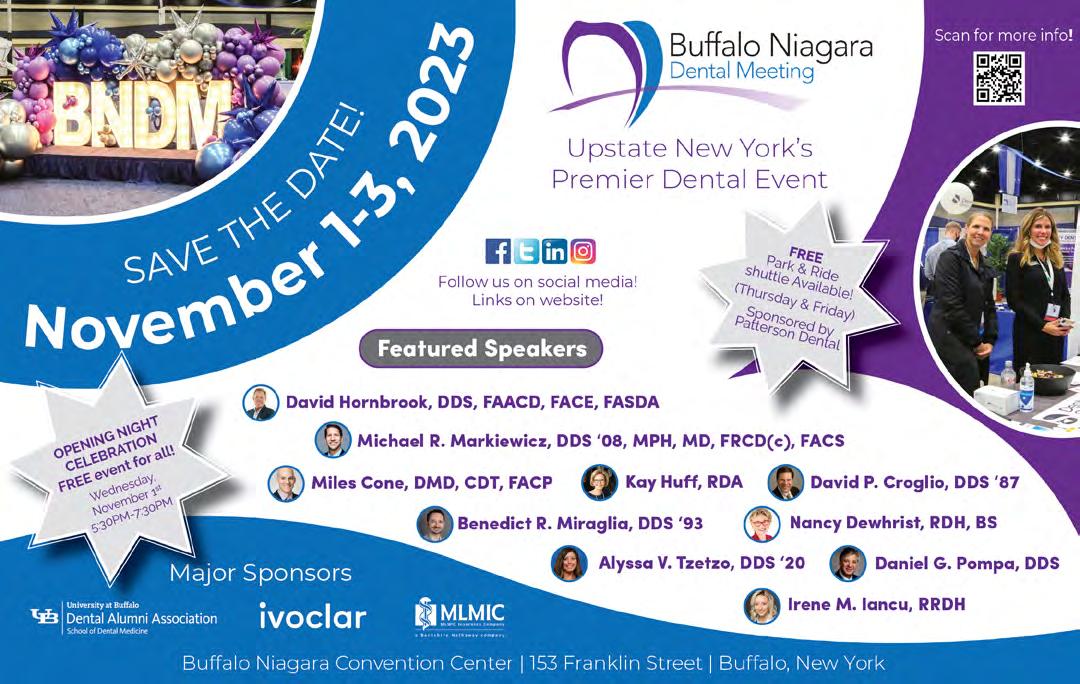
easier for those individuals possibly not cut out for a career in dentistry in the first place.
Reduce the Stigma of Mental Health Assistance
Inevitably, even individuals fit for the practice of dentistry and armed with stress management training can succumb to professional pressures to the point that they need mental health assistance. However, too many in this position avoid seeking help. A 2019 poll from the American Psychiatric Association found mental health stigma caused over half of all employees to fear discussing mental health issues, and over one-third to fear retaliation, which allowed most mental health services to go unused.[3]
A 2016 study concluded that most societies and cultures maintain a negative attitude toward people with mental illness.[4] This stigma primarily stems from a lack of understanding and fear of mental illness as a disease due to inaccurate or misleading representations of individuals suffering from mental disorders. Researchers define three forms of stigma: public, self and institutional, all of which discriminate against this already marginalized group.
Public and institutional stigmas describe the general attitudes of the public that the mentally ill are dangerous and some-
4 JUNE/JULY 2023 The New York State Dental Journal
how responsible for their disease. Publicly, this leads employers, landlords and the healthcare system to discriminate by, respectively, not hiring or not renting to these individuals and, in some instances, offering them a lesser standard of healthcare. Institutionally, these prejudices find their way into laws and policies that can cause lost opportunities.
Self-stigma refers to the internalized shame individuals with a mental illness hold regarding their own condition because of the public stereotypes. In addition, dentists charged with taking care of others often view their mental illness as a professional failure and personal weakness. Ultimately, these stigmas threaten dentists’ employment, reputation and careers, deter those in need from seeking mental health assistance and allow their symptoms to worsen.
In 2021, the ADA House of Delegates passed Resolution 95H-2021, “Prioritizing the Mental Health of Dentists.” The resolution required the ADA to analyze the availability of resources to support dentists’ mental health and gather information regarding existing health and wellness programs across the tripartite, among other initiatives.[5] Currently, the ADA offers numerous programs available to its members, and the results of this formal analysis will expand their effectiveness. We must engage in expanded open dialogue regarding dentist mental health to raise understanding and empathy and, ultimately, reduce mental health stigmas.
Fit the Correct Pieces to Solve the Dentist Mental Health Puzzle
Dental education must ensure that applicants to our profession are willing to embrace professional responsibility and provide them with stress management training to deal with the challenges involved. Organized dentistry must continue to support practitioners’ overall well-being and fight to reduce the stigmas that cause dentists in need to avoid that support. Together, we can eliminate the nightmares from our dream profession.
EDITORIAL POSITION
THE NEW YORK STATE DENTAL JOURNAL is inviting applications from members of the New York State Dental Association interested in filling the position of Journal Associate Editor. The position is for one year, commencing January 2024. At the end of the year, the Associate Editor is expected to begin a two-year term as Editor, with the possibility of that term being extended by another three years.
The Associate Editor will be asked to assist the Editor in performing the following duties:
• Contribute relevant and cogent editorials.
• Solicit manuscripts from prospective authors/researchers.
• Find appropriate manuscript reviewers and manage the peer review process.
• Review manuscripts for clarity and accuracy and make final editorial decisions about manuscripts.
• Act as an ambassador for The Journal, with a vision to advance its standing and increase its impact. Candidates for this position must possess and demonstrate the following skills:
• Strong writer.
• Organized; able to meet deadlines.
• Open to new concepts and methodologies.
REFERENCES
D.D.S., J.D.

1. Burger D. Dentist Health and Well-Being Survey Report finds dentists struggle with anxiety, discomfort at work. ADA News, February 23, 2022. https://www.ada.org/publications/ada-news/2022/ february/dentist-health-and-well-being-survey-report-finds-dentists-struggle-with-anxiety.
2. Alzahem A, Van der Molen H, Alaujan A, DeBoer B. Stress management in dental students: a systematic review. Advances in Medical Education and Practice 2014:5,170.
3. American Psychiatric Association Public Opinion Poll. Released May 2019. APA Annual Meeting, San Francisco, CA.
4. Rossler W. Stigma of Mental Disorders. Published online 2016 Jul 28. doi:10.15252/ embr.201643041.
5. Burger D. Dentist Health and Well-Being Survey Report finds dentists struggle with anxiety, discomfort at work. ADA News, February 23, 2022. https://www.ada.org/publications/adanews/2022/february/dentist-health-and-well-being-survey-report-finds-dentists-strugglewith-anxiety.
• Understand or be willing to learn digital publishing and platforms, such as Digital Commons and Google Scholar.
Interested candidates are asked to email a letter of introduction, CV and writing samples to the Managing Editor by August 18. Address submissions to Ms. Mary Stoll mstoll@nysdental.org.
The New York State Dental Journal ● JUNE/JULY 2023 5
Three New Actions Enter Legal Landscape
Latest legal maneuvers cover a variety of fronts with potential impact on dental practices.
Lance Plunkett, J.D., LL.M.
The latest legal developments come from the New York State Legislature, as part of the State Budget; from New York City, on the antidiscrimination front; and from the National Labor Relations Board (NLRB) weighing in on employment law.
As part of the State Budget signed into law by Gov. Hochul on May 3, the Legislature created a new process for reporting “material transactions” entered into by healthcare entities to the New York State Department of Health. The provisions of the law are contained in a new Article 45-A of the New York State Public Health Law. The law takes effect Aug. 1. Whether the law will apply to dental practice entities is ambiguous. Section 4550(2) of the Public Health Law provides:
2. “Health care entity” shall include but not be limited to a physician practice, group, or management services organization or similar entity providing all or substantially all of the administrative or management services under contract with one or more physician practices, provider-sponsored organization, health insurance plan, or any other kind of health care facility, organization or plan providing health care services in this state; provided, however, that a “health care entity” shall not include an insurer authorized to do business in this state, or a pharmacy
benefit manager registered or licensed in this state. An “insurer” shall not include non-insurance subsidiaries and affiliated entities of insurance companies regulated under the insurance law or this chapter. While the law specifically mentions only physician practices (and other entities that clearly are not dental practices), the stem of the law uses the term “shall include but not be limited to.” This opens the door to the Department of Health bringing in other private professional healthcare practices through implementing regulations. However, the law also creates an exception to the reporting requirement for “de minimis” transactions, which are defined to be “a transaction or a series of related transactions which result in a health care entity increasing its total gross in-state revenues by less than twenty-five million dollars.” That exception would probably exclude many private dental practice transactions even if they were included as an entity required to report.
A “material transaction” required to be reported is defined to be any of the following:
1. A merger with a healthcare entity.
2. An acquisition of one or more healthcare entities, including but not limited to the assignment, sale or other conveyance of assets, voting securities, membership, or partnership interest or the transfer of control.
ATTORNEY ON LAW
6 JUNE/JULY 2023 The New York State Dental Journal
3. An affiliation agreement or contract formed between a healthcare entity and another person.
4. The formation of a partnership, joint venture, accountable care organization, parent organization, or management services organization for the purpose of administering contracts with health plans, third-party administrators, pharmacy benefit managers or healthcare providers, as prescribed by the commissioner by regulation.
What will be required if dental practice transactions are required to be reported? All the following items would need to be reported to the Department of Health by written notice at least 30 days before the closing of the transaction:
1. Names and addresses of the parties.
2. Copies of any definitive agreements governing the transaction, including pre- and post-closing conditions.
3. Identification of all locations where healthcare services are currently provided by each party and the revenue generated in New York State from such locations.
4. Any plans to reduce or eliminate services and/or participation in specific plan networks.
5. The closing date of the transaction.
6. A brief description of the nature and purpose of the proposed transaction, including the anticipated impact of the transaction on cost, quality, access, health equity and competition in the impacted markets, which impact may be supported by data and a formal market impact analysis, and any commitments by the healthcare entity to address such anticipated impacts.
The law is only a reporting requirement. The governor’s original idea of requiring Department of Health approval for all such transactions was rejected by the Legislature. Nevertheless, there are penalties for failing to report. Entities that fail to provide written notice of a material transaction are subject to a daily civil penalty of up to $2,000 for each day the entity has failed to comply. This penalty increases to a maximum of $5,000 per day for subsequent violations that represent a “serious threat to the health and safety” of individuals. There is no cap on the total penalty that may be incurred for failure to provide required written notice, so it does not pay to engage in endless delay.
The new law is odd in that the Department of Health will make the information reported public by both providing any filings submitted to the New York State Attorney General and by publishing information about the transaction on the Department of Health website asking for comment by the public. This type of law is becoming a trend in other states. While not the first to adopt such a law, New York is still an early adopter among the states.
NYSDA Directory
OFFICERS
Anthony M. Cuomo, President 667 Stoneleigh Ave., Ste 301, Carmel, NY 10512
Prabha Krishnan, President- Elect 11045 Queens Blvd., Ste 108, Forest Hills, NY 11375
Maurice Edwards, Vice President 30 E. 60th ST, #1401, New York, NY 10022
Paul Leary, Secretary-Treasurer 80 Maple Ave., Ste 206, Smithtown, NY 11787
William Karp, Speaker of the House 4500 Pewter Ln., Bldg 6, Manlius, NY 13104
BOARD OF TRUSTEES
James E. Galati, Immediate Past President 1758 Route 9, Halfmoon, NY 12065
Brendan Dowd, ADA Trustee 3435 Main St., Squire Hall, Room 235G, Buffalo, NY 14214 NY – Lois Jackson 505 Laguardia Pl., Apt L4, New York, NY 10012
2 – John P. Demas 8814 Fort Hamilton Pkwy, Brooklyn, NY 11209
3 – Steven L. Essig Emblem Health, 1873 Western Ave., Albany, NY 12203
4 – Adrienne L. Korkosz 1309 Union St., Schenectady, NY 12308
5 – Lynn A. Stacy 7504 E State St., Lowville, NY 13367
6 – Luis T. Mauleon 501 N. Cayuga St., Ithaca, NY 14850
7 – Theresa A. Casper-Klock 33 William St., Ste 1, Auburn, NY 13021
8 – Raymond G. Miller 1965 Como Park Blvd., Lancaster, NY 14086
9 – Gary M. Scharoff 1255 North Ave., Ste A1H, New Rochelle, NY 10804
N – Donald R. Hills 136 Woodbury Rd., Ste L3, Woodbury, NY 11797
Q – Mitchell S. Greenberg 11966 80th Rd., #1A, Kew Gardens, NY 11415
S – Guenter J. Jonke 2500 Nesconset Hwy., Bldg 24A, Stony Brook, NY 11790
B – Amarilis Jacobo 824 E. 181st St., Bronx, NY 10460
New Dentist—Megan Cloidt 1400 Pelham Pkwy. S., Ste. 3NE1, Bronx, NY 10461
COUNCIL CHAIRPERSONS
Council on Awards
Dental Benefit Programs
Dental Education & Licensure
Dental Health Planning & Hospital Dentistry
Dental Practice
Ethics
Governmental Affairs
Membership & Communications
Nominations
Peer Review & Quality Assurance
Professional Liability Insurance
OFFICE
Suite 602, 20 Corporate Woods Blvd., Albany, NY 12211 (518) 465-0044 | (800) 255-2100
Gregory D. Hill
Lance R. Plunkett
Michael J. Herrmann
Grazia A. Yaeger
Mary Grates Stoll
Jenna Bell
Betsy Bray
Briana McNamee
Stacy McIlduff
Lawrence J. Busino
2 Executive Park Dr., Albany, NY 12203-3700
Patricia M. Hanlon
4 Lyme St., Wading River, NY 11792
Joseph Gambacorta
4911 Anfield RD., Williamsville, NY 14221
Raquel Rozdolski
52 Shingle House Rd., Millwood, NY 10546
Mario Silverstri
501 Plaza Dr., Vestal, NY 13850
Paul W. Teplitsky
1 Hanson Pl., # 705, Brooklyn, NY 11243
Robert F. Schaefer
110A W. Utica St., Oswego, NY 13126
Kendra J. Zappia
1 Pine West Plaza, #106, Albany, NY 12205
James E. Galati 1758 Route 9, Halfmoon, NY 12065
Barry Sporer 80 Park Ave., Ste 1C, New York, NY 10016
Roland Emmanuele 4 Hinchcliffe Dr., Newburgh, NY 12550
Executive Director
General Counsel
Assistant Executive Director Finance and Administration
Assistant Executive Director Marketing and Communications
Managing Editor
Director of Meeting Planning
Director of Health Affairs
Director of Governmental Affairs
Executive Director NYS Dental Foundation
The New York State Dental Journal ● JUNE/JULY 2023 7
Tear Down those Fences
Also in the State Budget is a new law—Section 394-g of the New York State General Business Law—that prohibits a practice known as healthcare “geofencing.”
Geofencing in healthcare is an advertising mechanism that allows someone to create a digital boundary around a specific healthcare facility and then deliver location-based advertising to healthcare providers or patients who enter the facility by using their location data. The new law prohibits setting up a geofence around a healthcare facility except if it is your own facility. The law takes effect on July 2.
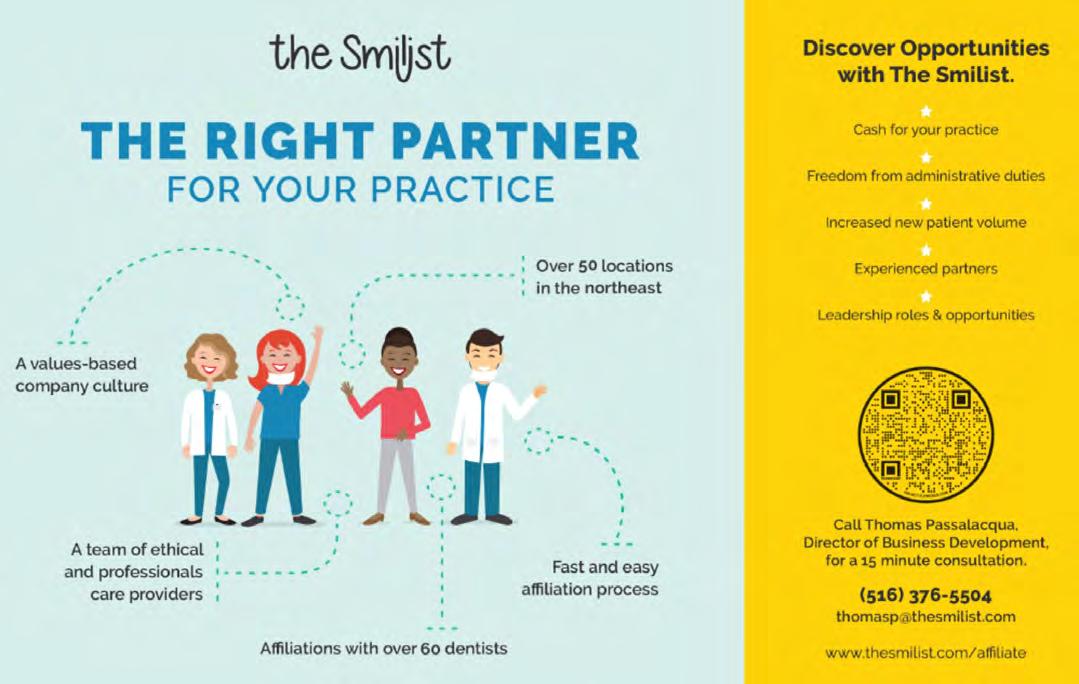
Fit for the Job
On May 26, New York City Mayor Eric Adams signed into law— Intro. #209-A—prohibitions on employers discriminating against persons based on weight or height. The law will take effect on Nov. 22. The new law makes it illegal to take the following actions against any persons based on their height, weight or perceived height or weight:
1. Representing that any employment or position is not available when, in fact, it is available.
2. Refusing to hire or employ or barring or discharging from employment such person.
3. Discriminating against such person in compensation or in term, conditions or privileges of employment.
This type of law, too, is becoming a trend nationally and New York State is considering a statewide law, although New York City has acted first. It should be noted that the city of Binghamton was the first place to enact such a law in New York, in 2008. It has taken a long time for another locality to act.
The New York City law allows exceptions where persons’ height or weight would prevent them from performing the essential functions of a particular job with or without an accommodation, or where the employer’s consideration of height or weight criteria is reasonably necessary for the normal operation of the business. These exceptions will likely be construed narrowly because the New York City Commission on Human Rights is going to define specific jobs and/or job categories that are exempt from the new law. Beyond those listed exemptions, others are going to be difficult to justify and obtain.
NLRB Not Waiting Around
Finally, the National Labor Relations Board (NLRB) has jumped headfirst into the issue of non-compete agreements. Without waiting for any regulations of the Federal Trade Commission (FTC) to be adopted (those are still under review by the FTC), on May 30, the general counsel for the NLRB issued Memorandum
8 JUNE/JULY 2023 The New York State Dental Journal
GC 23-08 stating that non-compete agreements violate the National Labor Relations Act (which applies to nearly all employers).
Specifically, the general counsel found that non-compete agreements interfere with employees’ exercise of rights under Section 7 of the National Labor Relations Act (NLRA) and that, except in limited circumstances, the proffer, maintenance and enforcement of such agreements violate Section 8(a)(1) of the NLRA. Section 7 of the NLRA protects employees’ “right to selforganization, to form, join, or assist labor organizations, to bargain collectively through representatives of their own choosing, and to engage in other concerted activities for the purpose of collective bargaining or other mutual aid or protection.”
It is an unfair labor practice in violation of Section 8(a)(1) of the NLRA for an employer “to interfere with, restrain, or coerce employees in the exercise of the rights guaranteed in section 7.” Noncompete provisions are overbroad, that is, they reasonably tend to chill employees in the exercise of NLRA Section 7 rights, when the provisions could reasonably be construed by employees to deny them the ability to quit or change jobs by cutting off their access to other employment opportunities that they are qualified for based on their experience, aptitudes and preferences as to type and location of work.
Generally speaking, this denial of access to employment opportunities chills employees from engaging in NLRA Section 7 activity because:
1. Employees know that they will have greater difficulty replacing their lost income if they are discharged for exercising their statutory rights to organize and act together to improve working conditions.
2. Employees’ bargaining power is undermined in the context of lockouts, strikes and other labor disputes.
3. An employer’s former employees are unlikely to reunite at a local competitor’s workplace and, thus, be unable to leverage their prior relationships—and the communication and solidarity engendered thereby—to encourage each other to exercise their rights to improve working conditions in their new workplace. While the NLRB general counsel memorandum does not have the force of law in the way a statute or regulation has, it is a good guide to how the NLRB intends to act on complaints about non-compete agreements that they may receive.
The federal assault on non-compete agreements is in full swing and New York State also has pending legislation to accomplish the same basic goal, but there has been no result on its fate as of the writing of this article.
Watch for more employment law developments in the coming months at all levels of government. p

The New York State Dental Journal ● JUNE/JULY 2023 9
The material contained in this column is informational only and does not constitute legal advice. For specific questions, dentists should contact their own attorney.
Association Activities
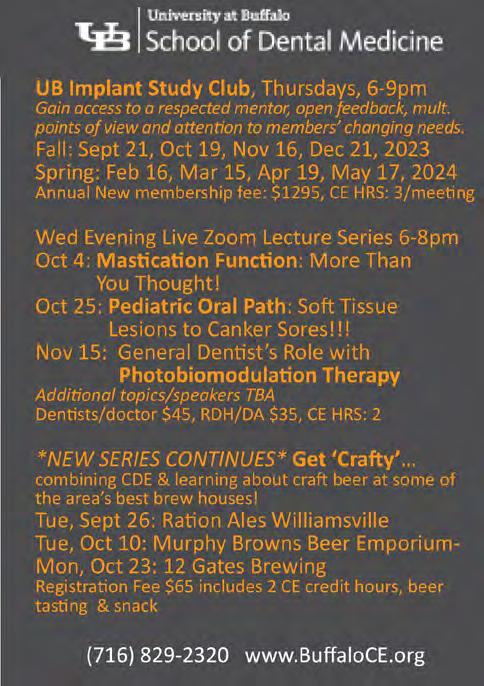
David Miller Receives Kamen Award

NYSDA PAST PRESIDENT DAVID J. MILLER, D.D.S., whose work with special needs patients has attracted positive attention over the years, collected further recognition in April when he received the Saul Kamen Distinguished Service Award. Presented by the Special Care Dentistry Association at its Annual Meeting and Expo in Dallas, TX, the award commends Miller “For exemplary behavior and commitment to treating patients with special needs.”
Dr. Miller, who has been treating special needs patients for nearly 40 years, is past president of the Special Care Dentistry Association, a trustee of the New York State Dental Foundation and assistant clinical professor of dentistry at Columbia University School of Dental Medicine. He is on the Board of Advisors, Project Accessible Oral Health, and Board of Directors, Nassau County Dental Society. He was NYSDA President in 2015-2016.
Chu Reappointed to Dental Board
PAUL CHU, D.D.S., a pediatric dentist from Rye, Westchester County, has been reappointed to the State Board for Dentistry. Dr. Chu will be serving his second and final five-year term on the Board.
Dr. Chu received his dental degree from the University of the Pacific Dugoni School of Dentistry in San Francisco. He also holds a bachelor’s degree in environmental toxicology from the University of California, Davis.
 David Miller
David Miller
10 JUNE/JULY 2023 The New York State Dental Journal
Paul Chu
Association Activities
A Beautiful Night for a Run
NYSDA assembled its largest team ever to tackle the 3.5-mile run/walk through downtown Albany. The CDPHP Workforce Team Challenge May 18 is the largest running event in the Capital Region. It’s a major fundraiser for Hudson-Mohawk Road Runners Club. Representing the Dental Association are, from left, Peter Lacijan, John Murray, Christa Murray, Dr. Lauren Heisinger, Patty Marcucia, Maureen O’Brien, Heather Relation, Betsy Bray, Executive Director Greg Hill, Isabella Ayala.

In Memoriam
NEW YORK COUNTY
Jerome Schweitzer
Indiana University ‘51
PO Box 908
Westhampton Beach, NY 11978
March 14 2023
SEVENTH DISTRICT
Ronald Peterson
University at Buffalo ‘60
3207 St. Paul Boulevard
Rochester, NY 14617
April 2, 2023
NINTH DISTRICT
Francis Panno
Marquette University ‘56
PO Box 479
Waccabuc NY 10597
April 1, 2023
NASSAU COUNTY
Thomas Riordan
Fairleigh Dickinson University ‘68
2305 Coventry Road
Baldwin, NY 11510
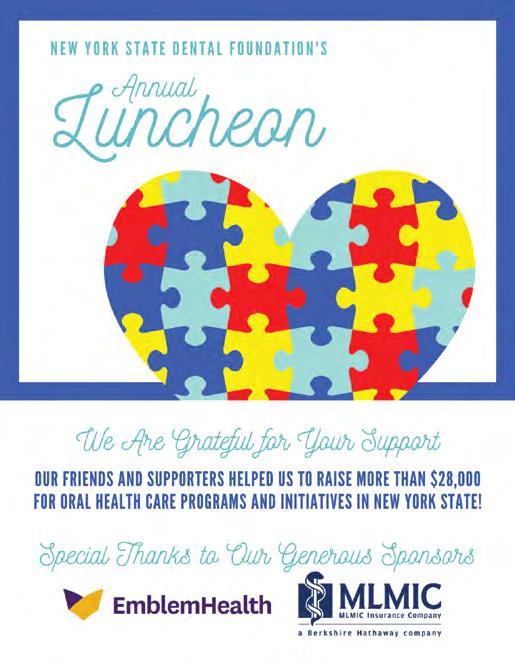
January 19, 2023
SUFFOLK COUNTY
Raymond Dennison
New York University ‘62
1061 Stratford Place
Melbourne, FL 32940
March 21, 2023
The New York State Dental Journal ● JUNE/JULY 2023 11
The Welcome Sign is Out
ANTHONY CUOMO comes into office with his priorities set. Installed June 3 as the 143rd president of the New York State Dental Association, Cuomo made it clear from the outset that he plans to focus his attention on five issues that he believes will shape the direction of the dental profession. They are:
• Innovation—keeping current with the latest advancements in dentistry and encouraging members to integrate cuttingedge practices into their daily routines.
• Collaboration—building strength by working together; tapping into the collective expertise to develop new ideas, protocols and solutions that will benefit patients and the profession.
• Continuing education—fulfilling a responsibility to stay informed about the latest research, techniques and best practices to provide the highest quality patient care, and expanding programs to ensure members have access to the knowledge and skills they need to excel in their careers.
• Advocacy—championing policies that support access to dental care for all New Yorkers and strengthening efforts to en-
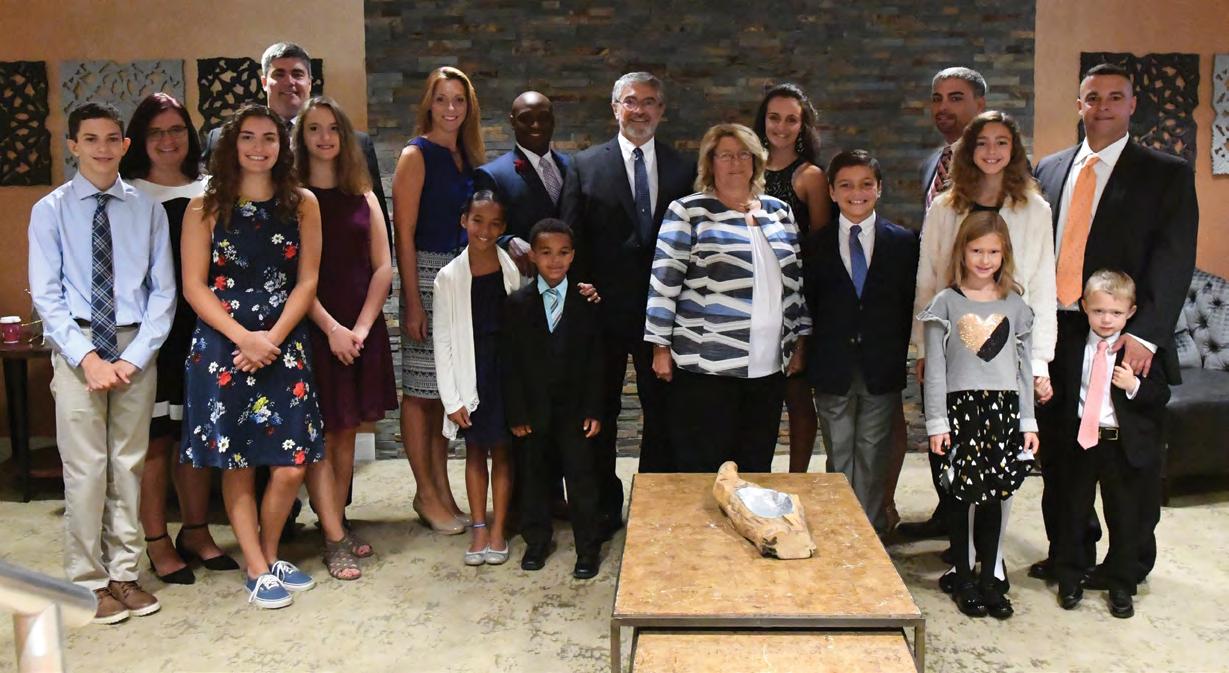
sure that the concerns of dental professionals are heard and addressed by policymakers.
• Membership growth—expanding membership but also enhancing the diversity of the Association and fostering a more inclusive and supportive community.
Cuomo is adamant about this last point, pledging that as NYSDA President, he will be “committed to promoting diversity, equity and inclusion within our profession.”
“We must strive to create a profession that is welcoming and inclusive to all regardless of race, ethnicity, gender identity, sexual orientation or other characteristics,” he said.
Seize the Moment
Anthony M. Cuomo, D.D.S., brings nearly 50 years of experience as both a dentist and member of organized dentistry to his position as the chief elected officer of NYSDA. He already held a degree in pharmacy from Fordham University when, in 1974, he graduated from NYU College of Dentistry. By 1977, he had completed an internship and residency at Lincoln Hospital in the
NYSDA’s newest president vows to lead an organization and profession open to all.
The New York State Dental Association welcomes Anthony M. Cuomo, D.D.S., its 143rd president.
12 JUNE/JULY 2023 The New York State Dental Journal
The Cuomo family. From left: Anthony Jr. and wife, Shelley, and children Nicholas, Kaylee, Ashley; daughter, Nicole, and husband, Andrew, and children Olivia, Lincoln; Anthony and wife, Patricia; son Christopher and children McKenna, Caden; son Matthew and children Kylie, Kiera, Carson.
Bronx and established a practice limited to oral and maxillofacial surgery, with offices in Carmel, NY, and Danbury, CT. He later rebranded his practice Northeast Implant & Oral Surgery when he was joined by son Christopher, D.D.S., M.D.
Though now retired, Cuomo remains attuned to the dental profession’s evolution. He believes dentistry is on the threshold of a new era of growth and innovation, which, he said, presents an “opportunity to build a stronger, more resilient and more patient-centered profession that is better equipped to meet the changing needs of our patients and our communities.”
Seizing on that opportunity means continuing to engage in effective governmental advocacy at the local, state and national levels, the NYSDA President said, adding that he is fully committed to working with the Association’s legislative partners and governmental affairs team “to advance policies that promote oral health and expand access to care for all New Yorkers, especially those who are underserved or disadvantaged.”
Dedicated Servant
Anthony Cuomo’s commitment to his profession, his patients and to organized dentistry is unequivocal. Prior to his retirement, he was chairman of the dental department at Danbury Hospital and section chief of the hospital’s oral and maxillofacial section. He was also affiliated with Putnam Hospital in Carmel.
He is past president of the Ninth District Dental Association, Putnam County Dental Society and Greater Danbury Dental So-



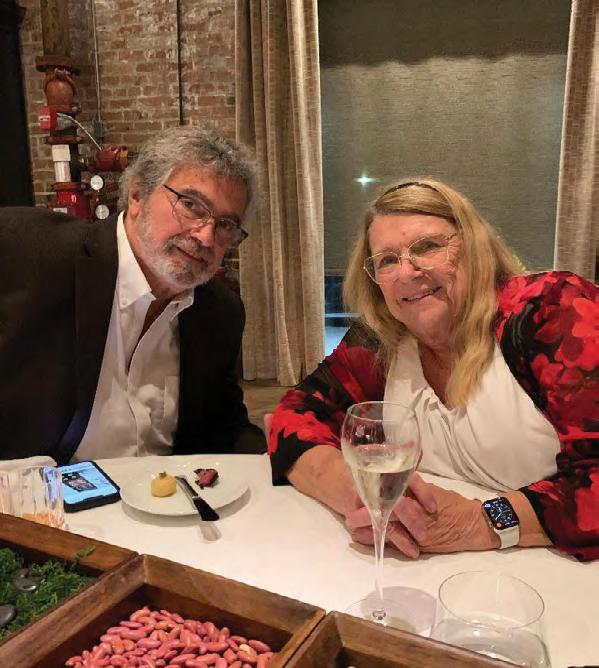 Cuomo children. From left, Anthony Jr., Nicole, Matthew, Christopher.
Anthony Cuomo and wife, Patricia. Married when he was in dental school, the couple has been together for over 50 years.
In New Orleans for meeting of ADA House, Cuomo visited famed creole restaurant Commander’s Palace with Daniel Doyle, current president of Ninth District.
Cuomo children. From left, Anthony Jr., Nicole, Matthew, Christopher.
Anthony Cuomo and wife, Patricia. Married when he was in dental school, the couple has been together for over 50 years.
In New Orleans for meeting of ADA House, Cuomo visited famed creole restaurant Commander’s Palace with Daniel Doyle, current president of Ninth District.
The New York State Dental Journal ● JUNE/JULY 2023 13
Cuomo shares his passion for cooking over pans of seafood with Ninth District colleague Thomas Puma.
ciety. A delegate or alternate delegate to the American Dental Association House for over a decade, he also chaired the ADA Committee on Credentials, Rules and Order.
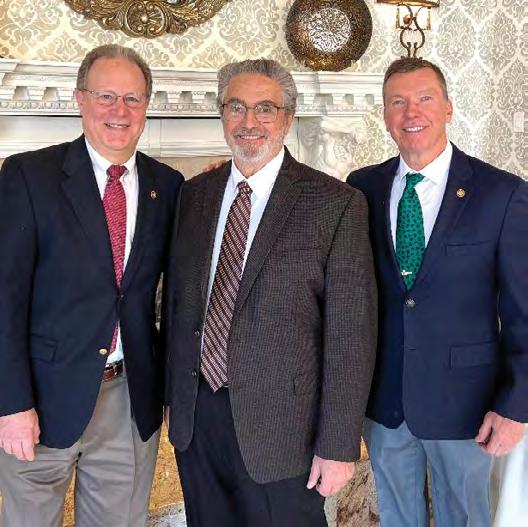
On the state level, in addition to representing the Ninth District in the NYSDA House and on the Association Board of Governors and Board of Trustees, Cuomo served three years as a member and one year as the chair of the NYSDA Strategic Planning Committee.
What follows is more information about Dr. Cuomo, gleaned from a recent conversation.
Where did you grow up?
I spent my premarital years in Yonkers. Then I lived in Uniondale, Long Island, with my wife, Patricia, while attending dental school.
Who are the members of your immediate family?
Patricia Ann Cuomo, RN, is my wife.
My brother, John Cuomo.
My four children and grandchildren. They are:
Anthony Michael Cuomo Jr, married to Shelley, and their three children—Kaylee, Ashley and Nicholas;
Christopher Cuomo and his four children—McKenna, Christopher Jr, Macey and Caden;
Matthew and his three children—Kylie, Keira and Carson;
Nicole (Cuomo) Ferdinand and her husband, Andrew, and their two children—Olivia and Lincoln.
Where did you go to school?
Fordham Preparatory School, Fordham University College of Pharmacy, NYU College of Dentistry.
What are the greatest challenges facing dentistry today and how should the profession respond?
Workforce issues are plaguing all professions and dentistry is no exception. Solving this issue is not as easy as one would think, and correction is not going to occur overnight. First, as in any business, we need to find ways to maximize efficiency and minimize the workload. My four-point plan for turning things around includes the following initiatives.
• Encourage career interest by increasing awareness of dentistry as a profession and promoting it as an attractive career choice.
• Expand training programs by establishing or expanding dental assistant and dental hygienist training programs to meet the growing demand for these roles. And provide financial incentives, scholarships or loan forgiveness programs to attract individuals to these careers.
• Enhance working conditions and job satisfaction for dental professionals. This might include providing competitive salaries, offering comprehensive benefits packages, ensuring reasonable work hours, and promoting a healthy work-life balance. This is difficult to achieve if production is less.
• Advocate for insurance reform for patients so that the cost of proper dental care is not a financial burden on the household. Achieving this will make it easier for offices be more competitive and attractive workplaces. This is accomplished through advocacy, which can only be effective through a strong political action committee, or PAC. This is why it is important for all dentists to belong to organized dentistry, so these changes can occur.
What convinced you that you needed to join organized dentistry? How do we persuade more dentists to join?
For my generation, joining organized dentistry, particularly the ADA, was an obvious choice and a badge of honor. However, perspectives have evolved, especially among younger dentists, who face different challenges and greater expenses compared to when I started practicing. If these dentists don’t already have the inherent desire to become ADA members, it’s crucial that we educate them about the value that membership brings to their practices and professional lives.
To effectively engage and recruit more dentists, it is essential that we convey the message of the tangible benefits that organized dentistry offers. Dentists should be made aware of the resources, support and opportunities available through membership, emphasizing how it can enhance dentists’ practices and elevate the quality of care they provide to their patients.
It is equally important that we actively seek input from younger dentists and understand their specific needs and con-
Portrait of Ninth District leaders. From left, Gary Scharoff, NYSDA Trustee; Cuomo; President Daniel Doyle.
14 JUNE/JULY 2023 The New York State Dental Journal
cerns. By listening to their perspectives, we can better address their business challenges, improve profitability and cater to their evolving professional aspirations. This two-way communication allows organized dentistry to adapt and offer relevant programs, services and advocacy initiatives that resonate with the younger generation of dentists.
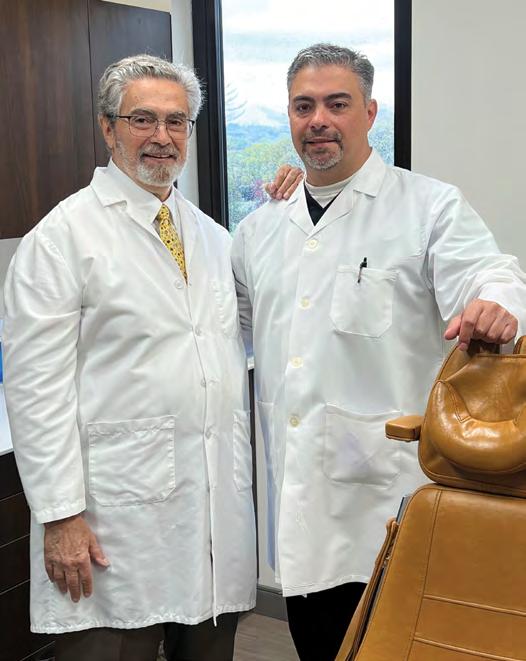
Overall, the key to persuading more dentists to join organized dentistry lies in effectively communicating the value proposition of membership, showcasing the benefits and support available, and actively involving younger dentists in shaping the organization to meet their needs. By demonstrating how organized dentistry can contribute to their success, both professionally and personally, we can inspire more dentists to become active participants and advocates for the profession.
You have expressed interest in working collaboratively with members and stakeholders. How do you propose to do that? Listening and understanding. Actively listening to the perspectives and needs of members and stakeholders. Seeking their input through surveys, focus groups or one-on-one conversations. By understanding their expectations and challenges, you can better tailor initiatives and programs to address their specific needs.
Regular engagement. Maintain regular and meaningful engagement with members and stakeholders. This can include hosting workshops, seminars or conferences where they can network, share experiences, and contribute to the direction and goals of the organization. Encourage collaboration and the exchange of ideas among members.
Collaboration on decision-making. Involve members and stakeholders in the decision-making process. Establish committees or task forces comprising diverse representation to ensure that different perspectives are considered. Allow members to contribute to policy development, program planning and strategic initiatives.
The list goes on. It will take time and for some, not work fast enough; however, if you do nothing you get nothing.
Do you come to this position with an overarching philosophy and, if so, what is it?
My opinion is based on years of seeing the problem and listening to the younger dentists. Change in the way an organization works
takes time, especially if the leadership in place has run out of options and things to try. The mentality is changing, and I expect with the right group of young leaders, we can accomplish great things.
Can you be specific about the NYSDA initiatives/activities you would like to continue or begin when president?
I have already spoken with my future officers on this very topic. This year’s mentoring programs will continue to be developed and addressed by Dr. Galati. It was a priority of his, and I want this program to continue and grow. Our officers are committed to staying with this valuable initiative and paying it forward. I will be focusing on ways to cut costs where I see waste and improving opportunities for non-dues income so that we begin to depend less on member dues for the programs we support. I will be tasking our membership committee with some “out-of-the-box” suggestions to consider. I want to plant a seed that will flourish for years to come.
What is your number one priority? Supporting and growing membership.
Cuomo and son Christopher, his practice partner at Northeast Implant & Oral Surgery, Danbury, CT.
The New York State Dental Journal ● JUNE/JULY 2023 15
“To effectively engage and recruit more dentists, it is essential that we convey the message of the tangible benefits that organized dentistry offers.”
Understanding Persistent Bleeding in Children
A Review of the Literature and Report of Three Cases
Bret Lesavoy, D.M.D.; Christine Wang, D.D.S.; Richard Yoon, D.D.S.
ABSTRACT
This article addresses a rare postoperative complication of persistent bleeding and “liver clot” coagulum following placement of a permanent tooth preformed metal crown, an extraction of a carious permanent molar and an accelerated exfoliating primary molar in young patient who was medically compromised. Mild bleeding following dental procedures or tooth exfoliation is not an unusual occurrence; however, persistent bleeding is an uncommon event for patients. A review of literature revealed 15 reports of liver clots following adult dental procedures, but no documented cases of liver clot formation in young patients. The purpose of this article was to document its presence in the pediatric and adolescent population.
The “liver clot” is a rare occurrence that stems from abnormal coagulation and prolonged bleeding. Venous hemorrhage, characterized by slow-oozing and darkly pigmented red blood, can lead to a hemoglobin-rich currant jelly-like clot in areas where there may be difficulty controlling bleeding with pressure alone.[1] Mild bleeding following dental procedures or during tooth exfoliation is not an unusual occurrence; however, persistent bleeding and
oozing is an uncommon event for patients without any known risk factors.
Hemorrhage is typically limited in blood vessel injury by a hemostatic response, which includes vasoconstriction, primary hemostasis from platelet activation, secondary hemostasis by deposition of insoluble fibrin by the proteolytic coagulation cascade and, lastly, by fibrinolysis and anti-thrombotic events.[2,3] A disruption in this process—specifically with regards to secondary hemostasis—leads to incomplete fibrin clotting, which has been shown to be associated with formation of a liver clot.[3]
Bleeding that occurs within 24 hours of insult is known as intermediate hemorrhage and can be due to intrinsic trauma from enamel or bone spicules, infection or presence of a foreign body, such as dental material preventing normal coagulation pathways.[4] Other risk factors for liver clot formation or prolonged bleeding include a lack of constricting vasculature, liver disease, antiplatelet agents and/or anticoagulants.
Previous literature documents cases of liver clots in the dental setting; however, no reports have been found to date in the pediatric and adolescent population. The purpose of the following report is to present three dissimilar cases of liver clot formation and to analyze potential contributing factors unique to its occurrence in young patients. The first case describes a liver clot that developed following placement of a permanent tooth preformed metal crown (PMC); the second, following the extraction of a nonrestorable permanent molar; the third, in conjunction with
pediatricosteonecrosisdentistry
16 JUNE/JULY 2022 The New York State Dental Journal
a mobile primary molar for a medically complex patient taking enoxaparin.
Case One
A 7-year-old female presented to the Children’s Hospital emergency department (ED) in the evening hours with a chief complaint of persistent bleeding from a crown placed the day prior. Bleeding had not subsided since early that morning, and the child reported pain in the lower right quadrant of her mouth. The child had not taken in any food or fluids since the previous night due to discomfort. A dose of over-the-counter ibuprofen was given to the patient the night before presenting to the ED. Past medical history review revealed no significant findings with no known drug or other allergies.
A large liver-like clot was removed in order to perform a clinical examination and ice water-soaked gauze was placed on the site with gentle pressure without improvement. Extraoral evaluation was not significant. Removal of the gauze revealed continuous oozing of heme localized to the gingival sulcus of the mandibular right permanent first molar (Figure 1A), which had a PMC placed one day prior. The radiograph (Figure 1B) revealed normal dental development for chronological age, multiple restorations on the permanent and primary dentition, and no radiographic radiolucency indicating signs of pathology. Proximity was noted on the distal margin of the PMC on the mandibular right permanent first molar to the adjacent tooth follicle.

Local anesthetic infiltration in the form of 2% lidocaine with 1:100,000 epinephrine was administered surrounding the affected area, and the gingival sulcus was curetted and irrigated with saline solution to remove any local irritants. The gingival sulcus was packed with a gelatin matrix and the gingival tissues cauterized. Hemostasis was achieved, and the patient was instructed to provide continuous biting pressure (Figure 1C). The patient was discharged and received follow-up care in the outpatient dental clinic the next day, at which time she was exhibiting absence of bleeding complications and normal healing gingival tissues.
Case Two
An 11-year-old female presented to the Children’s Hospital ED in the evening hours with a chief complaint of constant bleeding and upper left quadrant pain after routine extraction of the permanent maxillary left first molar seven hours prior that day. Since the procedure, the patient had been unable to take in any food, fluids or analgesic medication due to bleeding and discomfort. A review of the patient’s medical history revealed well-controlled asthma and no other reported medical conditions or allergies.
Initial presentation of the patient showed the child sitting comfortably, lightly holding gauze with her anterior teeth. Extraoral evaluation was not significant. Intraoral evaluation revealed generalized dental caries, heme pooling and accumulation in the oral cavity, and a large jelly-like clot protruding from the maxil-
 lary left permanent first molar region (Figure 2A).
Figure 1: (A) Bleeding localized to lower right quadrant, from distal segment (black arrow) of gingival sulcus of lower right permanent first molar, post-removal of currant jelly-like clot. (B) Imaging revealed intact restorations and no radiolucencies or pathology. Close proximity of distal margin of preformed metal crown on lower right permanent first molar to dental follicle of lower right permanent second molar was noted (white arrow). (C) Area surrounding lower right permanent first molar with hemostasis achieved using local hemostatic measures.
lary left permanent first molar region (Figure 2A).
Figure 1: (A) Bleeding localized to lower right quadrant, from distal segment (black arrow) of gingival sulcus of lower right permanent first molar, post-removal of currant jelly-like clot. (B) Imaging revealed intact restorations and no radiolucencies or pathology. Close proximity of distal margin of preformed metal crown on lower right permanent first molar to dental follicle of lower right permanent second molar was noted (white arrow). (C) Area surrounding lower right permanent first molar with hemostasis achieved using local hemostatic measures.
The New York State Dental Journal ● JUNE/JULY 2023 17
Figure 2: (A) Currant jelly-like clot by extraction site in upper right quadrant. (B) Removal of currant jelly-like clot. (C) Extraction site with hemostasis achieved using socket curettage and local hemostatic measures.
Supraperiosteal infiltration local anesthesia in the form of 2% lidocaine with 1:100,000 epinephrine was administered at the extraction site. The clot was removed, and the socket was curetted and irrigated with saline solution (Figure 2B). Examination of the socket revealed visualization of the unerupted crown of the permanent maxillary left second molar serving as the distal wall of the socket. After 30 minutes of finger pressure, small loose clots formed but were not adhering, and bleeding continued. The socket was curetted and irrigated, and an absorbable gelatin dental sponge was gently placed in the extraction site. Hemostasis was achieved with finger gauze pressure. The patient was discharged and followed up at the outpatient dental clinic the next day with no residual pain or persistent bleeding issues (Figure 2C).
Case Three
A 6-year-old female with short gut syndrome, cholestatic liver disease, dependent on chronic total parenteral nutrition and later found to suffer from liver cirrhosis presented with a chief complaint of constant gingival bleeding without pain in the upper right quadrant. The patient was being managed at the Children’s Hospital as an inpatient and was taking enoxaparin to manage portal vein thrombosis. Her mother reported no history of dental restorations or extractions in the area. Initial presentation of the patient showed the child jaundiced but lying comfortably bedside.
Intraoral examination revealed moderate plaque and calculus accumulation, no signs of dental caries, a Grade II mobile primary maxillary left first molar, and a Grade III mobile primary maxillary right first molar, which was encompassed by coagulum (Figure 3A). The patient’s last dose of enoxaparin had been administered roughly 12 hours prior. At this time, the clot was removed with gauze, the tooth was irrigated with saline, and firm gauze pressure was intermittently applied (due to acute stress reaction) for 10 minutes until hemostasis was achieved.
Gingival bleeding returned within 24 hours of the patient resuming enoxaparin, resulting in a jelly-like clot coagulum that was again visualized encompassing the primary maxillary right first molar. Enoxaparin was again temporarily halted. Due to the

patient’s medical complexities and acute stress reaction, definitive treatment was postponed until the following day when the patient was scheduled for a liver biopsy.
Hemostasis was again achieved bedside with sterile saline irrigation and gauze pressure. Under anesthesia, a periapical radiograph of the primary maxillary right first molar was obtained and revealed an advanced eruption pattern (Figure 3B). Supraperiosteal infiltration local anesthesia in the form of 2% lidocaine with 1:100,000 epinephrine was administered and the mobile tooth delivered. Exuberant granulation tissue was excised, absorbable gelatin dental sponge was placed, and hemostasis achieved (Figure 3C). On follow-up, examination showed the extraction site was hemostatic and healing well.
Discussion
Bleeding is a common sequela of dental procedures that is generally self-limiting. Extensive bleeding may lead to formation of a liver clot, as described in these cases. Treatment of a liver clot includes removal with high-volume suction and curettage, irrigation and direct pressure, which allows a healthy organized blood coagulum to form in order to stop hemorrhagic or persistent bleeding.[4]
While the conservative approach to treatment is, often, all that is required in management of liver clots, additional hemostatic treatment modalities could be considered. The formation of a natural blood clot is dependent on the presence of platelets and the interaction with coagulation factors to form a fibrin matrix.[5] In the event of inadequate hemostasis, from irrigation and direct pressure alone, adjunctive procedures and topical hemostatic agents can be considered to facilitate proper care for the patient. Adjunctive procedures include sutures, passive and active hemostatic agents, and lasers, to name a few. Sutures act as a mechanical method to seal off blood vessels and manage bleeding, which in the right circumstance can be a relatively easy and conservative supplemental approach to treatment. Topical hemostatic agents, including collagen, cellulose, gelatins and polysaccharide spheres, alternatively, act passively by forming a physical
18 JUNE/JULY 2023 The New York State Dental Journal
Figure 3: (A) Currant jelly-like clot encompassing exfoliating tooth #B. (B) Intraoperative radiograph revealing erupting tooth #4 and exfoliating tooth #B. (C) Extraction site with hemostasis achieved using curettage and local hemostatic measures.
platform, which coheres to the site of injury, activates the extrinsic clotting pathway and provides a matrix where platelets can collect to form a clot.[6]
Because passive hemostasis relies on fibrin production to achieve hemostasis, topical hemostatic agents are only appropriate for use in patients who have an intact coagulation cascade.[6] Topical thrombin products, instead, act as active hemostatic agents to form the basis of a fibrin clot by influencing the coagulation cascade, promoting the conversion of fibrinogen to fibrin.[7] Overall hemostasis may be improved by simultaneous use of these passive and active hemostatic agents.
Further, as wide use of lasers in dentistry has become commonplace, diode lasers, in particular, have become known as a heat-generating device that can be utilized to provide hemostasis of soft tissues, among other uses. Diode lasers, which produce laser wavelengths ranging between 810 nm and 980 nm, have been used in dentistry since the mid-1990s and have advanced significantly since their implementation in the field.[8] Diode laser wavelengths differ from erbium lasers, which have an approximate wavelength of 3,000 nm, and CO2 lasers which have an approximate wavelength of 10,000 nm. Photo-thermal coagulation with lasers primarily occurs from denaturation of soft-tissue proteins and constriction of blood and lymphatic vessels at increased temperatures. Diode lasers have been shown to be significantly more effective with coagulation over extended volumes compared to erbium or CO2 laser wavelengths.[9]
In the first case described, a unique formation of a liver clot developed following placement of a PMC; in the second, following an extraction; and in the third, the result of repeated irritation from an exfoliating tooth on a medically complex patient taking enoxaparin. Although the preceding events of liver clot formations in these cases were different, similarities are noted. In all three cases, the children were in the mixed dentition phase, and there were dental follicles or unerupted teeth directly adjacent to the sites of uncontrolled bleeding. As a tooth develops, the dental follicle surrounds the enamel organ and dental papilla. It provides nutrition to the developing tooth and has a
rich blood supply in order to do so. This rich blood supply may have been a contributing factor to the formation of the liver clot in these cases.[10]
Hemorrhage following seating of a PMC is uncommon due to closure of the soft tissue at the gingival sulcus. However, a sharp edge of a crown may act as constant irritation, preventing normal clotting and healing. The radiograph of the first case reveals the PMC was also near the dental follicle of the permanent right mandibular second molar and may have impinged on the vasculature, causing persistent bleeding. In the second case, lack of pressure may have been the main contributing factor for the abnormal clotting. However, during extraction of the first permanent molar, there may have been possible traumatic impingement of the adjacent dental follicle, causing persistent bleeding. The unerupted crown also may have been an inadequate surface for clots to adhere. In the third case, the repeated trauma of an exfoliating tooth crown meant constant reinjury to the surrounding tissue and, possibly, the erupting tooth follicle.
It is also important to understand and note any possible underlying conditions in patients that may lead to uncontrolled bleeding. A complete blood count (CBC) and coagulation study were ordered to rule out blood dyscrasias in all three cases. The patient in Case Three had increased risk factors for bleeding due to the enoxaparin the patient required to manage portal vein thrombosis, as well as the impact of the patient’s liver dysfunction on her coagulation cascade. Enoxaparin is a low-molecular weight heparin that disrupts the coagulation cascade and has been shown to cause elevated partial thromboplastin time (PTT). Prolongation of PTT, prothrombin time (PT), international normalized ratio (INR), as well as mild thrombocytopenia, is also common in individuals with liver disease.[11]
Although they had uncomplicated medical histories, the patients in the first and second cases also showed slightly elevated PT and INR levels, which may have predisposed them to prolonged bleeding (Table 1).
Adverse events after dental procedures are uncommon; however, it is important to recognize and address postoperative prob-

The New York State Dental Journal ● JUNE/JULY 2023 19
lems that may arise. Young patients in the mixed dentition may have an added risk of forming a liver clot if dental follicles are in close proximity to the area being manipulated. Identifying these cases and taking caution around these sites may minimize the risk of persistent bleeding and liver clot formation. While most liver clots can be treated by conventional curettage, irrigation and controlled pressure, adjunctive hemostatic agents and matrices may also be effective in management. p
The authors thank Drs. Liza Idelchik and Annie Zhao for providing clinical photos for cases One and Three. They report no conflict of interest in the preparation of this paper. Queries about this article can be sent to Dr. Lesavoy at drbret@lesavoydental.com.
REFERENCES

1. Druckman RF, Fowler EB, Breault LG. Post-surgical hemorrhage: Formation of a “liver clot” secondary to periodontal plastic surgery. J Contemp Dent Pract 2001;2(2): 62-71.
2. Bakutra G, Vishnoi S, Chandran S, Barot V. Liver Clot: A reactionary haemorrhage - Case report. Natl J Integr Res Med 2015;6(1):116-8.

3. Nair MB, Shashikumar P. “Liver Clot” after periodontal plastic surgery. J Int Clin Dent Res Organ 2019;11(2):106-09.
4. Pandya D, Manohar B, Mathur LK, Shankarapillai R. “Liver clot” - A rare periodontal postsurgical complication. Indian J Dent Res 2012;23(3):419-22.
5. Hadjipanayi E, Kuhn PH, Moog P, Bauer AT, Kuekrek H, et al. The Fibrin Matrix Regulates Angiogenic Responses within the Hemostatic Microenvironment through Biochemical Control. PLOS ONE 2015;10(8).
6. Samudrala S. Topical hemostatic agents in surgery: a surgeon’s perspective. AORN J 2008;88(3):S2-S11.
7. Achneck HE, Sileshi B, Jamiolkowski RM, Albala DM, Shapiro ML, Lawson JH. A comprehensive review of topical hemostatic agents: efficacy and recommendations for use. Ann Surg 2010;251(2):217-228.

8. Desiate A, Cantore S, Tullo D, Profetta G, Grassi FR, Ballini A. 980 nm diode lasers in oral and facial practice: current state of the science and art. Int J Med Sci 2009;6(6):358-64.

9. Willems PWA, Vanderton WP, Verdaasdonk RM, van Swol CFP, Jansen GH. Contact laserassisted neuroendoscopy can be performed safely by using pretreated ‘black’ fibre tips: Experimental data. Lasers in Surgery and Medicine 2001:28(4):324-9.

10. Kuyama K, Iwai S, Ogura N, Eda T, Kondoh T, Yamamoto H. Histopathological and immunohistochemical study of the characteristics of dental follicle. J Hard Tissue Biol 2012;21(3):237-44.
11. Intagliata NM. Concepts and controversies in haemostasis and thrombosis associated with liver disease: Proceedings of the 7th international coagulation in liver disease conference. Thromb Haemost 2018;118(8):1491-506.

Bret Lesavoy, D.M.D., is a private practitioner in Pennsylvania and New Jersey. He is a former postdoctoral residency fellow in pediatric dentistry at Columbia University Medical Center, New York, NY.



Christine Wang, D.D.S., is a private practitioner in Connecticut. She is a former postdoctoral residency fellow in pediatric dentistry at Columbia University Medical Center, New York, NY.


Richard Yoon, D.D.S., is an associate professor of dental medicine, Section of Growth and Development, College of Dental Medicine, at Columbia University Medical Center, New York, NY.

For more information about this and other Endorsed Programs call: 800-255-2100









 Dr. Wang Dr. Yoon
Dr. Lesavoy
Dr. Wang Dr. Yoon
Dr. Lesavoy
• 20 JUNE/JULY 2023 The New York State Dental Journal

Sinus Tract vs. Fistula
There is a Difference
ABSTRACT
The terms sinus and fistula have been used interchangeably in clinical dentistry, but it may be inconsistent with past and current literature. The primary difference between the two is the number of anatomic spaces or openings involved. There is often confusion regarding the lining of a sinus tract and of a fistula. This article will review the clinical and histological features of a sinus and a fistula in both dentistry and medicine.
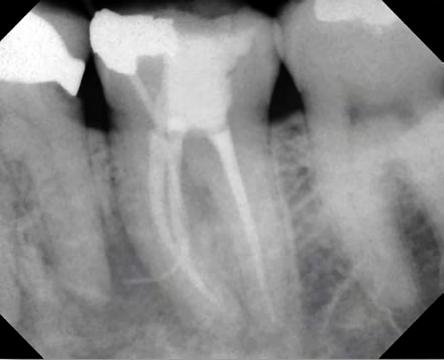
The Latin meaning of the word sinus is a “curve or bend or deepest part inside something.”[1] A sinus is a draining tract (hence, sinus tract) that has one abnormal narrow opening, or stoma, that is often referred to as a “blind-ended tract.” In dentistry, a sinus tract originates from other locations, including the apex of a tooth (not considered an opening) to another structure or tissue, such as the oral cavity, skin or anatomic space (which are openings) for drainage of the infection.[2]
The pathway of a sinus tract that develops from a necrotic pulp is through the alveolar bone and emptying purulent exudate into the oral cavity. The stoma can be on the attached gingiva, alveolar mucosa or gingival sulcus. It can also empty on the buccal or lingual surface (Figures 1A, B). This is determined by the proximity of the apex to either the cortical plate and/or the density of the bone. Finally, it can also drain extraorally (cutaneous sinus tract) (Figures 2A, B).[3-5]
Extraoral sinus tracts may result in a small scar on the skin and are usually misdiagnosed in the medical community before it is

dental terminology
Figure 1B: Sinus tract was traced with size 35 gutta-percha. Periapical radiograph revealed origin of sinus tract was periapical lesion associated with distal root of first molar not second molar, indicating possibly wrong tooth had been treated.
Figure 1A: Patient was referred to endodontist for evaluation because sinus opening had not healed after endodontic therapy on lower left second molar. Patient was asymptomatic and had been so prior to initiation of therapy; however treatment was initiated because of diagnosis of sinus tract opening facial to second molar
22 JUNE/JULY 2023 The New York State Dental Journal
Mea A. Weinberg, D.M.D., M.S.D., R.Ph.; Stuart L. Segelnick, D.D.S., M.S.; Christine Chu, D.D.S.; Asgeir Sigurdsson, D.D.S., M.S.
realized it is a sign of dental infection.[6] Essentially, a sinus tract develops as a mechanism of drainage of exudate from an infected root canal system. While bacteria are usually confined within the root canal system,[7] Ricucci et al., found that a majority of teeth with associated sinus tracts have extraradicular biofilm with bacteria present on the outer surface of the root.[8] Sinus tracts have been shown to develop in fractured teeth and rare cases of vertical fractures presenting with multiple sinus tracts.[9] Sinus tracts of odontogenic origin can also drain into the nasal opening.[10] Differential diagnosis of cutaneous sinus tracts includes carcinomas, osteomyelitis of the jaw, salivary gland lesions and actinomycosis.[11,12]
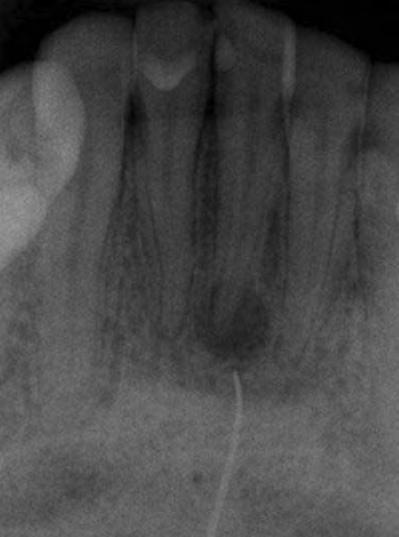
It is the same concept in medicine, where a sinus tract or tunneling wound originates from the surface of an organ (if it’s a hollow organ, it is called a fistula) or a wound underneath the skin (not an opening) and travels in one direction through soft tissue or to an underlying area or abscess cavity (an opening). Other medical examples include pressure ulcers and a skin condition called hidradenitis suppurativa.[13-15]
Histologically, the majority of studies report that the sinus tract is lined with granulomatous tissue. Harrison and Larson concluded that some sinus tracts extending from the apex of the tooth to the oral mucosa may be lined with epithelium; however, more are likely to be lined with chronic inflammatory cells (granulomatous tissue).[16,17] Baumgartner found two-thirds of sinus tracts had epithelium with only granulation tissue past the rete ridges and one-third had epithelium the entire length.[18] In longstanding, chronic untreated sinuses and fistulae, there may be a downgrowth of epithelium from the mucosal surface.[3,16,19]
Healing of sinus tracts from lesions of endodontic origin occur when the root canal system is disinfected enough to reduce the bacterial load to a level that is compatible with tissue healing. Granulomatous tissue in a periapical lesion cannot be removed directly by root canal treatment unless an apicoectomy is done.
Fistula
The Latin meaning of the word fistula is “pipe” or “tube.”[20] A fistula, in contrast to a sinus tract, is an abnormal narrow pathway or communicating channel between two anatomic spaces or openings, such as from the maxillary sinus (mucous surface) to the oral cavity (mucous surface) or from the oral cavity to and through the alveolar bone. For example, during an extraction, the lingual root of a maxillary first premolar is pushed into the sinus, resulting in an infection and drainage into the oral cavity. If this is not repaired, a fistula will develop between the maxillary sinus (one space) and the oral cavity (the other space), creating what is known as an oroantral fistula.[21]
In medicine, a fistula is an abnormal tract communicating between a hollow organ (e.g., small intestine, large intestine, stomach) and the surface of the skin. Some examples of a medical fistula are recto-vesical fistula, perianal fistula (seen in Crohn’s disease) and gastro-colic fistula.[13] Histologically, a
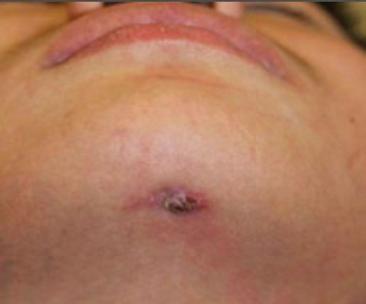
Discussion
Considering the clinical and histological articles reviewing sinus tracts and fistulas, there is a difference between these two terms. The differences between the two terms are based on anatomical features and histology. A sinus is a tract or an abnormal narrow channel that originates or ends in one opening or stoma. An example is a necrotic pulp where the infection starts from the apex of the tooth, which is the closed space, and travels through the alveolar bone to end in the oral cavity (gingiva), which is the one opening.
In contrast, a fistula is a tract or abnormal narrow channel between two anatomic openings or spaces. An example is an oroantral fistula that starts in the maxillary sinus (first opening)
Figure 2B: By gently removing existing scab, sinus opening was evident. It was traced with size #25 gutta-percha cone to lower right central incisor that was unresponsive to cold and EPT.
Figure 2A: Patient reported to clinic with history of persistent “pimple” on her chin. Plastic surgeon had excised pimple, but it reappeared within few weeks.
fistula is lined with epithelium that may or may not be filled by granulomatous tissue.[22-26]
The New York State Dental Journal ● JUNE/JULY 2023 23
and ends in the oral cavity or skin (second opening). Histologically, a preponderance of literature shows that the majority of the lining or walls and periapical area of sinus tracts are composed of chronic inflammatory granulomatous tissue. Healing occurs when bacteria are removed from the canal and the process of osteoclastogenesis stops. Since the two terms have frequently been used interchangeably, histologic reports may not be accurate, since many articles use the term sinus tract to include a fistula tract and the histologist may be using these terms substitutable.
The American Academy of Endodontists Glossary of Endodontic terms distinguishes between the two terms and states that “A sinus tract is a pathway from an enclosed area of infection to an epithelial surface. The term fistula is often inappropriately used.” A fistula is defined as “an abnormal communication pathway between two internal organs or from one epithelial lined surface to another epithelial-lined surface; it is not a sinus tract.”[27] Additionally, a fistula only pertains to a medical or oral, not tooth, condition.
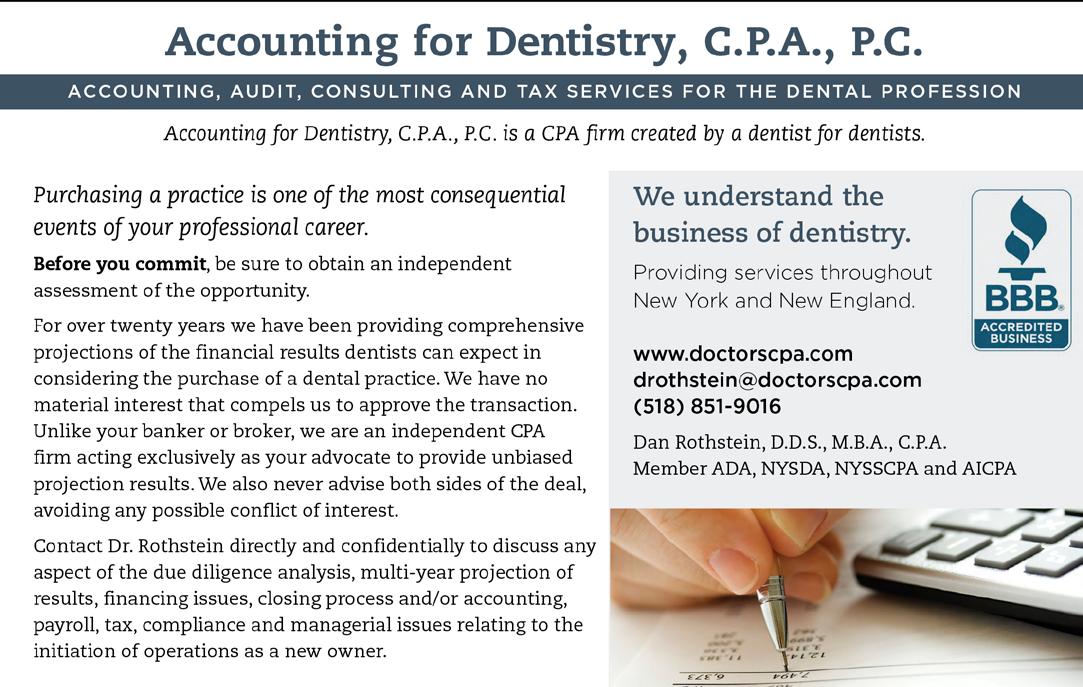
Sinus tracts can also originate from any surface of a dental implant. Tracing the exact site with gutta-percha or a CBCT may be necessary to determine exactly where the infection is coming from. In this paper, they interchanged fistula and sinus tract.[28] Additionally, purulent exudate from a chronic lateral periodontal abscess, or any periodontal abscess, can communicate with
the oral cavity through the periodontal pocket or a sinus tract. In conclusion, a draining infection from the apex of a tooth into the oral cavity should be correctly referred to as a sinus tract and not a fistula. Any draining infection from the maxillary sinus into the oral cavity or skin should be correctly referred to as a fistula or fistula tract. These two terms should not be used interchangeably, since they are two separate entities. p
Queries about this article can be sent to Dr. Segelnick at eperiodr@aol.com.
REFERENCES
1. Mavrodi A, Paraskevas G. Evolution of the paranasal sinuses’ anatomy through the ages. Anat Cell Biol 2013;46(4):235-238.
2. Giménez-García R, Martinez-Vera F, MSIV, Fuentes-Vera L. Cutaneous sinus tracts of odontogenic origin: Two case reports. J Am Board Fam Med 2015; 28:838-840.
3. Gao Z, Mackenzie IC, Pan S, Shi J. Epithelial lining of sinus tracts associated with periapical disease. J Oral Pathol Med 1991;20:228-233.
4. Spear KL, Sheridan PJ, Perry HO. Sinus tracts to the chin and jaw of dental origin. J Am Acad Dermatol 1983;8(4)486-492.
5. Kumar KS, Subbiya A, Vivekanandhan P, Prakash V, Tamilselvi R. Management of an endodontic infection with an extra oral sinus tract in a single visit: A case report. J Clin Diagn Res 2013 Jun;7(6):1247–1249.
6. Pasternak-Júnior B, Teixeira CS, Silva-Sousa YT, Sousa-Neto MD. Diagnosis and treatment of odontogenic cutaneous sinus tracts of endodontic origin: three case studies. Int Endod J 2009 Mar;42(3):271-276.
7. Walton RE, Ardjmand K.J. Histological evaluation of the presence of bacteria in induced periapical lesions in monkeys. Endod 1992 May;18(5):216-227.
8. Ricucci D, Loghin S, Gonçalves LS, Rôças IN, Siqueira JF Jr. Histobacteriologic conditions of the apical root canal system and periapical tissues in teeth associated with sinus tracts. J Endod 2018 Mar;44(3):405-413.
24 JUNE/JULY 2023 The New York State Dental Journal
9. Keinan D, Heling I, Slutzky-Goldberg I. Multiple sinus tracts as a result of root fracture: a case report. Quintessence Int 2008 Mar;39(3):227-9.
10. Sagar Sareen, Anjani Kumar Pathak, Parth Purwar, Jaya Dixit, Divya Singhal, Isha Sajjanhar, Kopal Goel, Vaibhav Sheel Gupta, Nasal Sinus Tract of Odontogenic Origin: Report of a Case, Case Reports in Dentistry, vol. 2015, Article ID 813478, 5 pages, 2015.
11. Gupta M, Das D, Kapur R, Sibal N. A clinical predicament—-diagnosis and differential diagnosis of cutaneous facial sinus tracts of dental origin: a series of case reports. Oral Surg Oral Med Oral Pathol Oral Radiol Endod 2011.
12. Cade JE. Oral cutaneous fistulas. eMedicine 2017. https://emedicine.medscape.com/ article/1077808-overview (Accessed December 14, 2021).
13. Newton H. Ten top facts about managing sinus wounds. Wound Essential 2016;11(1):8-1.
14. Gill L, Williams M, Hamzavi I. Update on hidradenitis suppurative: connecting the tracts. F1000Prime Rep 2014; 6:112-123.
15. Everett WG. Wound sinus or fistula? In: Wound Care. William Heinemann Medical Books, London. 1985;84–90. Eds. Westaby S.
16. Harrison JW, Larson WJ. The epithelized oral sinus tract. Oral Surg 1976; 42(4):511-517.
17. Bender IB, Seltzer S. The oral fistula: its diagnosis and treatment. Oral Surg 1961;14:1367-1376.
18. Baumgartner JC, Picket AB, Muller JT. Microscopic examination of oral sinus tracts and their associated periapical lesions. US Army Institute of Dental Research, Walter Reed Army Medical Center. Washington DC. May 1983:1-20.
19. Gage HC, Williams ER. The radiological exploration of sinus tracts, fistulae, and infected cavities. Radiology 1943;41(3):233-248.
20. Lundy JB, Fischer JE. Historical perspectives in the care of patients with enterocutaneous fistula. Clin Colon Rectal Surg 2010;23(3):133-141.
21. Kwon M-S, Lee B-S, Choi B-J, Lee J-w, Ohe J-Y, et al. Closure of oroantral fistula: a review of local flap techniques. J Korean Assoc Oral Maxillofac Surg 2020; 46:8-65.18.
22. Enrico A, Borgonovo AE, Berardinelli FV, Favale M, Maiorana C. Surgical options in oroantral fistula treatment. Open Dent J 2012; 6:94-98.
23. Bataille F, Klebl F, Rümmele P, Schroeder J, Karkas S, et al. Morphological characterization of Crohn’s disease fistulae. GUT 2004;53:1314-1321.
24. Chadha R, Agarwal K, Choudhury R, Debnath PR. The colovesical fistula in congenital pouch colon: a histologic study. J Pediatr Surg 2008; 43:2048-2052.
25. Al-Salem AH, Laing W, Talwalker V. Fistula-in-Ano in infancy and childhood. J Pediatr Surg 1994;29(3):436-438.
26. Józwik M, Józwik M, Kozłowski R, Sulkowski S, Semczuk A. Structural arrangement of vesicouterine fistula revisited: An immunohistochemical study documenting the presence of the endometrium. J Obstet Gynaecol Res February 2018; 44(2): 341-346.
27. American Association of Endodontists. Endodontic Glossary of Terms. Tenth Edition Chicago. 2020.
28. Nkenke E, Amann K, Reich S, Neukam FW, Frankenberger R. Submental cutaneous sinus tract as a result of progressive peri-implantitis: A case report. J Periodontol 2004; 75:1417-142.
Mea A. Weinberg, D.M.D., M.S.D., R.Ph., is clinical professor, Department of Periodontology and Implant Dentistry, New York University College of Dentistry, New York, NY.

Stuart L. Segelnick, D.D.S., M.S., is adjunct clinical professor, Department of Periodontology and Implant Dentistry, New York University College of Dentistry, New York, NY.

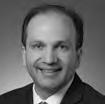
Christine Chu, D.D.S., FACP, is clinical assistant professor, Texas A & M College of Dentistry, Dallas, TX.
Asgeir Sigurdsson, D.D.S., M.S., is Presley Elmer Ellsworth Associate Professor and chair, Endodontics, New York University College of Dentistry, New York, NY.

The New York State Dental Journal ● JUNE/JULY 2023 25
Dr. Segelnick Dr. Chu Dr. Sigurdsson
What is the Prevalence of Temporomandibular Joint (TMJ) Condylar Osteoarthrosis in an Asymptomatic Oral and Maxillofacial Surgery Department Population?
John Vorrasi, D.D.S.; Laura Mendomo Mvomo, B.S.
ABSTRACT
The aim of the present study is to determine the prevalence and demographics of temporomandibular joint (TMJ) condylar changes in the asymptomatic general population of a hospital-based oral and maxillofacial surgery (OMFS) practice. We retrospectively reviewed cone-beam computed tomography (CBCT) scans of 272 TMJs from 136 consecutive patients to detect osteophyte, subchondral cyst, sclerosis, cortical erosions and flattening. While gender did not appear to play a significant role in TMJ pathology, age was positively correlated with prevalence of condylar changes. Patients 78 years and older were significantly more likely to have osteophyte, cyst, sclerosis and breakdown than were their younger counterparts. Flattening was the most common osseous change in our patient cohort.
Temporomandibular joint disorders (TMD) are common musculoskeletal disease processes that affect roughly 5% of the population, according to the National Health Survey.[1] Up to 12% of individuals report at least one clinical symptom of TMD.[2] The
development of these clinical signs is multifactorial, and has been associated with hormonal influence.[3,4] It has been suggested that upregulation of estrogen receptors may be associated with TMJ degeneration, though nothing has definitely been proven. Also, there is no evidence osseous changes occur more frequently in females compared to male counterparts.
Signs and symptoms of TMDs can vary, ranging from musculature disorders and pain to osteoarthritis. Literature supports that anatomic variations can lead to dysfunction, but there is little evidence that the most common age for TMD correlates to the time point of the most notable osseous changes. Osseous changes in bone architecture may accompany symptoms. In theory, more bone changes, degeneration or breakdown should be reflected in a similar age and gender category as the most common symptoms.
TMJ osteoarthritis may be present in up to 40% of older adults, but may only be detectable on roughly 10% of plain radiographs or panoramic films.[5] Previous investigations have highlighted osseous changes in patients with symptomatic TMD using in-office cone-beam computed tomography (CBCT).[6] The evolution and accessibility of CBCT technology in the past 10 to15 years have met or surpassed medical-grade CT imaging and can accurately display TMJ changes.
The primary aim of this study was to identify the prevalence of TMJ condylar changes in asymptomatic consecutive patients in an oral and maxillofacial population and examine how this correlates to the demographics for TMD. To date, this is the only study
tmj pathology
26 JUNE/JULY 2023 The New York State Dental Journal
reviewing CBCT of asymptomatic patients for TMJ bony changes to approximate prevalence of changes in a population.
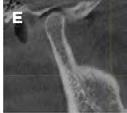
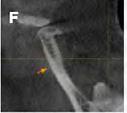
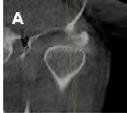
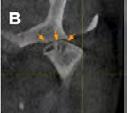
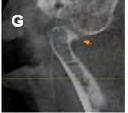

Methods
This retrospective cohort study was approved by the University of Rochester Research Subjects Review Board. We reviewed the Sirona CBCT scans (Dentsply, North Carolina) of 272 TMJs from 136 patients at the University of Rochester Department of OMFS. Clinic visits spanned from August 2016 to January 2017. We included patients between 18 and 95 years old, and excluded any patient who previously had a TMJ or orthognathic surgery, any craniofacial anomalies, TMJ or condylar trauma, any autoimmune, systemic, metabolic or infectious process involving the TMJ. The scans were anonymized, then stratified by gender (male, female) and by age (18-37 years old; 38-57 years old; 58-77 years old; 78-99 years old).
We screened CBCT imaging for TMJ osteophyte, subchondral cyst, sclerosis, surface erosion and flattening, as outlined by Cömert Kiliç et al., using Sidexis software (Dentsply, North Carolina) (Figure 1).[7] Presence of changes was labelled as “1.” Absence was “0.” Severity was not graded, rather just as presence or absence. All TMJs were reviewed by a single source (LM). Data were then analyzed using PRISM linear regression software (GraphPad, California). All comparisons in this study were analyzed by unpaired t-tests for prevalence of TMDs for age considerations over the different age groups and Anova for subgroup analysis. A p value of 95% or .05 was considered significant, as the observations would not be due to chance and correlated. The statistical measurements were used to validate correlations between CBCT findings and several categories, including age and gender. Areas of significance where p values are <0.05 are denoted in Figure 2. This is considered statistically significant.
Results
Of the 272 TMJs reviewed, the most prevalent TMJ change observed was flattening (141 TMJs, 52%), followed by surface erosion (60 TMJs, 22%), osteophyte (19 TMJs, 7%), sclerosis (9 TMJs, 3%) and subcortical cysts (2 TMJs, 1%) (Figure 1).
While age was not associated with TMJ flattening (p=0.07), older patients had a higher incidence of osteophyte (p<0.001), subcortical cysts (p< 0.001), surface erosions (p<0.01) and sclerosis (p<0.05) than did younger patients (Figure 2). These findings are statistically significant and are not due to chance. This difference was most significant between patients above 78 years of age and patients younger than 57 years old. Of the patients over 78, all exhibited osteophyte and joint breakdown, whereas only 10% of patients under 57 years of age exhibited osteophyte formation, and about 30% exhibited surface erosion. Approximately 30% of patients over 78 years of age had TMJ cysts and sclerosis, while nearly no patient under 57 exhibited these conditions. Gender was not associated with TMJ flattening, sclerosis, erosions, osteophyte or cysts (p=0.42, p=0.99, p=0.73, p=0.23,
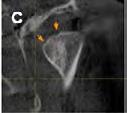
male and female patients (n = 133).
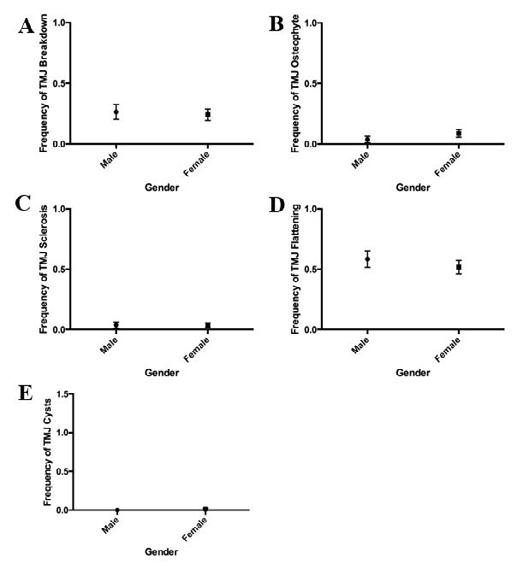
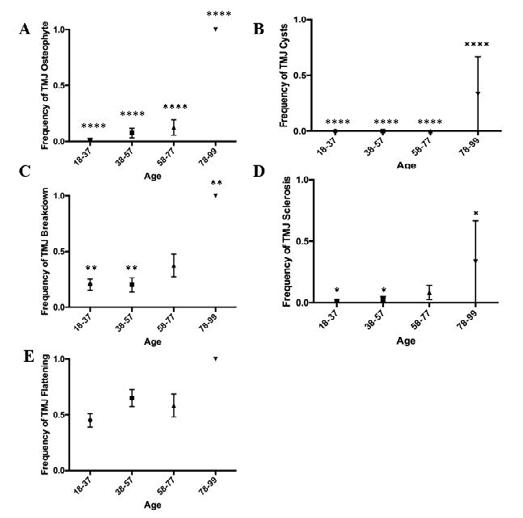 Figure 3. Prevalence of TMJ disorders by gender. Incidence of breakdown (A) osteophyte (B) sclerosis (C) flattening (D) and cysts (E) did not significantly differ between
Figure 1. CBCT scans of patients with TMJ disorders. (A) Normal (41/F, coronal view). (B) Possible subchondral cyst (84/F, coronal view). (C) Breakdown (40/M, coronal view). (D) Flattening (58/F, coronal view). (E) Normal (41/F, sagittal view). (F) Sclerosis (68/F, sagittal view). (G) Osteophyte (69/F, sagittal view).
Figure 3. Prevalence of TMJ disorders by gender. Incidence of breakdown (A) osteophyte (B) sclerosis (C) flattening (D) and cysts (E) did not significantly differ between
Figure 1. CBCT scans of patients with TMJ disorders. (A) Normal (41/F, coronal view). (B) Possible subchondral cyst (84/F, coronal view). (C) Breakdown (40/M, coronal view). (D) Flattening (58/F, coronal view). (E) Normal (41/F, sagittal view). (F) Sclerosis (68/F, sagittal view). (G) Osteophyte (69/F, sagittal view).
The New York State Dental Journal ● JUNE/JULY 2023 27
Figure 2. Prevalence of TMJ disorders by age group. Older patients are more likely to experience osteophyte (A) cysts (B) breakdown (C) sclerosis (D) and flattening (E) than are younger patients. ****p<0.0001, **p<0.01, *p<0.05, (n=136).
p=0.32) (Figure 3). Range distribution of condylar changes and demographics are also presented graphically.
Discussion
Although osseous changes do not correlate with symptomatic degenerative joint disease, TMDs have been shown to incorporate articular disease processes. Our retrospective study shows that condylar changes—breakdown, osteophyte, cysts and sclerosis—are more prevalent in older adults than they are in younger adults, but do not seem to have a gender predilection. Figure 2 reveals that frequency of bony changes in the condyle increases with age, and the most common finding is condylar flattening. Interestingly, there is no correlation between gender and condylar changes at all age groupings. Figure 3 is a graphical representation of gender comparison at all age groups. Since there was no statistically significant category of condylar change frequency at all ages, we did not further study specific age groups individually. These findings are consistent with other studies that have found that as patients get older, they are more at risk for TMD.[8,9] We did not, however, find any sexual dimorphism in bone changes between males and females. This may be due to our sample size (n=136) and the fact that our subjects came from our OMFS clinic, which may already reflect a high-risk population. To confirm prevalence, we would need a larger sample population.


Considering the previously mentioned exclusion factors for skeletal abnormalities and TMJ surgery, our OMFS clinic receives roughly 5,000 outpatient visits over six months. Our overall consecutive subject number of 136 represents 2.7% of our extrapolated clinic population. With about 80 patients of the 136 (58.8%) showing some osseous irregularity, roughly 2,900 patients may show some irregularity of bony changes in the TMJ without symptoms.

Knee and hip osteoarthritis present a global burden, with prevalence measured to be 3.8% and 0.85%, respectively.[10] These conditions have considerable financial and healthcare implications. Utilizing in-office CBCT to examine TMJ changes could potentially provide more insight as a screening component for patients to correlate changes in other joints throughout the body. Further investigations would be required to correlate TMJ radiographic findings with other joint changes and the chronology. Age has been shown to be strongly correlated with increased knee and hip osteoarthritis, similar to our study. Our study reveals a high prevalence of osseous changes with age and not with gender.


Given the high-risk potential of menopausal and post-menopausal osteoporosis, we were anticipating a higher female gender prevalence of osseous changes, erosions and osteophytes. Future investigations may help in assessing TMJ osteoarthritis in comparison to other joint and systemic osteoarthritis. Office CBCT of
Make HIPAA Compliance the Easiest Part of Running Your Practice


For more information about this and other Endorsed Programs call: 800-255-2100



Trying to maintain HIPAA compliance on your own, typically requires more than 80+ hours a year, and can be daunting. Using a software solution that automates your HIPAA program can help practices generate & document mandatory HIPAA items such as the Security Risk Analyses, HIPAA training for doctors and staff, Business Associate Agreements, and other required policies & procedures.


Abyde is the NYSDA-endorsed software solution to help members with HIPAA compliance without the associated stress. They can help you adhere to all the requirements of each part of the HIPAA rules and regulations to make sure your organization is ready to pass a HIPAA audit.





Wondering how your practice stacks up against the latest HIPAA requirements? Find out more about Abyde by calling 800.594.0883 x1 or visit the NYSDA website at www.nysdental.org
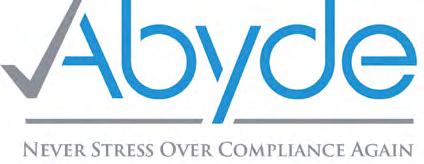
•
28 JUNE/JULY 2023 The New York State Dental Journal
the maxillofacial skeleton may show initial stages of osteoarthritis or bone degeneration.
Nah in 2012 highlighted the prevalence of bony changes in symptomatic TMD patients using CBCT.[6] Two hundred and twenty patients were reviewed, and the most common finding of bony changes was sclerosis, in 30% of patients reviewed, followed by surface erosion (29.3%). There was no gender correlation with TMJ changes or demographics reviewed for TMD patients in the review; however, they did note that 65.9% of patients with surface erosion had pain as a chief complaint.
A similar study by Cevidanes in 2010 reviewed TMJ changes in a symptomatic group with osteophyte formation and surface erosions at 40% of their sample.[11] Additional shape and deformation were examined by both of these studies; however, our review could be expanded in future studies. Our investigation revealed considerable bony changes, specifically, erosions (22%) in a general review questioning the ability to definitely associate “symptomatic” TMD surface erosions.
Talaat et al., reviewed patients[12] with TMD and non-TMD via CBCT in office and found significantly more joint space in non-TMD patients. Joint flattening was documented to be prevalent in TMD joints; however, according to our study, flattening is a common finding with asymptomatic TMJs as well. We typically obtain MRI imaging for symptomatic TMD patients and disc derangement, therefore, additional CBCT imaging may be unnecessary and only for academic purposes. Future studies will need to review larger populations of TMD and non-TMD patients, potentially using CBCT imaging to further assess clinical correlations and demographics.
The increased prevalence of TMD in older adults may have some implications for treatment of neck pain and conditions such as depression and anxiety. Neck pain, a prevalent comorbid condition of TMD, has been studied in rehabilitation-induced motor activity changes (Fougeront et al, 2018).[13] Understanding which populations are more at risk for TMDs can, thus, improve diagnosis and treatment outcomes in musculoskeletal therapeutics for neck pain.
Depression and anxiety are often associated with TMD. [14] Studies have shown that selective serotonin reuptake inhibitors (SSRIs) can induce bruxism or teeth-grinding, which further exacerbates some TMD symptoms. This could be a factor in force-based osseous changes in symptomatic TMD patients, similar to osteoarthritis in knees and hips. This is outside the scope of this article, and is a topic for a future investigation. The prevalence of TMD in certain demographics can help physicians better gauge appropriate treatment for patients suffering from anxiety and depression. SSRIs may have more undesired TMJ side effects in older adults compared to younger adults. Additional studies can be used to identify severity of condylar disease within patient populations or compare asymptomatic to symptomatic cohorts.
Conclusion
Changes within the TMJ in asymptomatic individuals appear to have a high prevalence and are strongly associated with age more so than gender. These changes do not appear to reflect the longterm effects of TMD derangements as compared with age and gender of patients with TMJ osteoarthrosis, although previous studies have shown higher bone erosions and reduced joint space with symptomatic patients. Future investigations may be used to incorporate TMJ changes as a systemic health indicator. p
Queries about this article can be sent to Dr. Vorrasi at john_vorrasi@urmc.rochester.edu.
REFERENCES
1. Ghali GE, Miloro M, Waite PD et al. Peterson’s Principles of Oral and Maxillofacial Surgery. 3rd Edition. Shelton (CT) Pmph USA. 2012.
2. Lipton JA, Ship JA, Larach-Robinson D. Estimated prevalence and distribution of reported orofacial pain in the United States. J Am Dent Assoc 1993; 124:115-21.
3. Abubaker AO, Raslan WF, Sotereanos GC. Estrogen and progesterone receptors in the temporomandibular joint discs of symptomatic and asymptomatic persons: a preliminary study. J Oral and Maxillofac Surg 1993; 51:1096-100.
4. Aufdemorte TB, Van Sickels JE, Dolwick MF, et al. Estrogen receptors in the temporomandibular joint of the baboon (Papio cynocephalus): an autoradiographic study. Oral Surg Oral Med Oral Path 1986; 61: 307-14.
5. Neville BW, Damm DD, Allen CM, Bouquot JE. Oral and Maxillofacial Pathology. 2nd ed. Philadelphia: Saunders, 2002.
6. Nah K. Condylar bony changes in patients with temporomandibular disorders: a CBCT study. Imaging Science in Dentistry 2012; 42:249-53.
7. Cömert Kiliç S, Kiliç N, Sümbüllü MA. Temporomandibular joint osteoarthritis: cone beam computed tomography findings, clinical features, and correlations. Int J Oral Maxillofac Surg 2015 Oct;44(10):1268-74.
8. Yadav S, Yang Y, Dutra EH, Robinson JL, Wadhwa S. Temporomandibular joint disorders in older adults. J Am Geriatr Soc 2018;66(6):1213–1217.
9. Johansson A, et al. Gender difference in symptoms related to temporomandibular disorders in a population of 50-year-old subjects. J Orofac Pain 2003;17:29-35.
10. Cross M, Smith E, Hoy D, Nolte S, Ackerman I, Fransen M, Bridgett L, Williams S, Guillemin F, Hill CL, Laslett L, Jones G, Cicuttini F, Osborne R, Vos T, Buchbinder R, Woolf A, March L. The global burden of hip and knee osteoarthritis: estimates from the global burden of disease 2010 study. Ann Rheum Dis. 2014 Jul;73(7):1323-30.
11. Cevidanes LH, Hajati AK, Paniagua B, Lim PF, Walker DG, et al. Qualification of condylar resorption in temporomandibular joint osteoarthritis. Oral Surg Oral Med Oral Pathol Oral Radiol Endod 2010;110:110-117.
12. Talaat W, Al Bayatti S, Al Kawas S. CBCT analysis of bony changes associated with temporomandibular disorders. Cranio 2016 Mar;34(2):88-94.
13. Fougeront N, Fleiter B. Temporomandibular disorder and comorbid neck pain: facts and hypotheses regarding pain-induced and rehabilitation-induced motor activity changes. Can J Physiol Pharmacol 2018 Nov;96(11):1051-1059.
14. Rajan R, Sun YM. Reevaluating antidepressant selection in patients with bruxism and temporomandibular joint disorder. J Psychiatr Pract 2017 May;23(3):173-179.
John Vorrasi, D.D.S., is program director, associate professor, Department of Oral and Maxillofacial Surgery, University of Rochester Medical Center, Eastman Institute for Oral Health, Rochester, NY.
Laura Mendomo Mvomo, B.S., is a nueroscience graduate of the University of Rochester, NY.
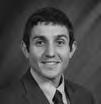
The New York State Dental Journal ● JUNE/JULY 2023 29
You, Your Teeth and Type 2 Diabetes
THE ABILITY TO CHEW PROPERLY may improve blood sugar levels in patients with Type 2 diabetes.
If you’re a healthcare provider treating people with Type 2 diabetes (T2D), University at Buffalo researcher Mehmet A. Eskan has this suggestion for you: check your patients’ teeth.
In a study published in PLOS ONE on April 14, Eskan demonstrates that patients with T2D who have full chewing function have a blood glucose level that is significantly lower than patients whose ability to chew effectively is impaired. Eskan is a clinical assistant professor in the Department of Periodontics and Endodontics at the School of Dental Medicine at UB.
The retrospective study looked at data gathered from 94 patients with T2D who had been seen at an outpatient clinic in a hospital in Istanbul, Turkey. The patients were divided into two groups: the first group included patients who had good “occlusal function”—enough teeth placed properly and making contact in such a way that a person can chew their food well. That group’s blood glucose level was 7.48. The second group couldn’t chew well, if at all, because they were lacking some or all of those teeth; their blood glucose level was almost 2% higher, at 9.42.
Mastication Matters
Digestion, the process by which your body extracts nutrients from food, begins as chewing stimulates the production of saliva. Nutrients that are important to reduce blood glucose levels include fiber, which is obtained in large part through chewing appropriate foods.
Chewing also has been reported to stimulate reactions in the intestine that lead to increased insulin secretion, and the hypothalamus that promote a feeling of satiety, resulting in less food intake. Eating less decreases the likelihood of becoming overweight, which is a major risk factor for developing T2D.
Dental Care and the Big Picture
Addressing oral health has become part of the approach to managing diabetes, along with encouraging patients to maintain a healthy weight, eat a healthy diet and quit smoking.
“Our findings show there is a strong association between mastication and controlling blood glucose levels among T2D patients,” said Eskan. This study did not find any independent variables that could affect blood glucose levels among the subjects because there were no statistical differences among subjects regarding body mass index (BMI), sex, smoking status, medications or infection, as indicated by white blood cell count (WBC) at the baseline.
The dramatic improvement in one patient’s case described in a 2020 study coled by Eskan illustrates the potential benefit of improving occlusal function through dental implants and appropriate fixed restoration. A T2D patient whose chewing function was severely impaired by missing teeth presented initially with a blood glucose level of 9.1. The patient obtained nutrition by using a bottle and eating baby food. Four months after treatment with a full-mouth, implant-supported fixed restoration, the patient’s glucose level dropped to 7.8. After 18 months, it decreased to 6.2.
Complications Kill
Research has shown that an increase of just 1% in blood glucose level is associated with a 40% increase in cardiovascular or ischemic heart disease mortality among people with diabetes, according to Eskan. Other complications can include kidney disease, eye damage, neuropathy and slow healing of simple wounds like cuts and blisters.
Eskan received his D.D.S. at Hacettepe University, a leading medical research center in Turkey, and earned his Ph.D. at the University of Louisville, where he also completed a residency in periodontology. “My special clinical interest is to treat dental patients who are systemically compromised,” he said. His research goal is to contribute to the big picture of improving public health. This research notes that, as of 2019, almost half a billion people worldwide had diabetes, and at least 90% of those patients with diabetes have T2D.
NEWS
General
30 JUNE/JULY 2023 The New York State Dental Journal
Lots to Smile About

TOURO COLLEGE of Dental Medicine students were all in for TCDM’s 6th annual Give Kids A Smile event in April, helping to provide free dental screenings, oral health education and assorted fun activities for hundreds of elementary students and families from Yonkers in TCDM Dental Health clinic. Students, Touro faculty and staff, working with volunteer dentists from Ninth District Dental Association, screened 275 children. Student participants included, from left, Andrew Polito, Tatum McGann, Diana Passariello, Frank DiNatale, Tiffany Smith.
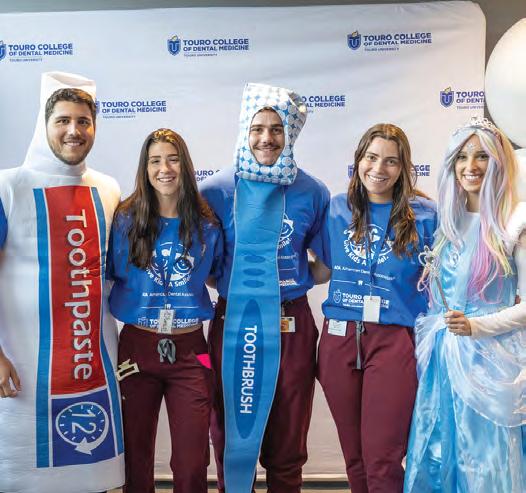
The New York State Dental Journal ● JUNE/JULY 2023 31
NEWS General
Dr. Habib Benzian and Dr. Richard Niederman Honored by IADR

THE INTERNATIONAL ASSOCIATION for Dental Research (IADR) honored Habib Benzian, D.D.S., M.Sc.D.P.H., Ph.D., and Richard Niederman, D.M.D., with awards for their achievements in global oral health, presented during the opening ceremonies of the 101st General Session of the IADR that took place on June 21 in Bogotá, Colombia.
Dr. Benzian, research professor of epidemiology and health promotion at NYU Dentistry and co-director of the NYU Dentistry World Health Organization (WHO) Collaborating Center for Quality Improvement and Evidence-based Dentistry, is the recipient of the IADR Distinguished Scientist John Greenspan Global Oral Health Research Award. The award, one of 17 IADR distinguished scientist awards, is among the highest honors bestowed by the association and is named for the late IADR and AADOCR Past President John Greenspan.
Dr. Benzian is a leader in global health, policy and advocacy who focuses on translating science into policy and actionable interventions to improve global oral health. He is currently a senior adviser to the WHO Global Oral Health Program and collaborates in several areas on global and regional levels. He is an invited expert member of the WHO/UNESCO Technical Advisory Group on COVID-19 and Education, a member of the Technical Expert Group developing global standards for health promotion in schools, a member of the WHO informal working group on health promotion and a member of the oral health research group of the Global Burden of Disease project. Dr. Benzian was a coauthor of the Lancet Series on Oral Health, a two-part series published in The Lancet in 2019, and a coeditor of the WHO’s first-ever Global Oral Health Status Report, launched in November 2022. He is also a member and working group lead of the Lancet Commission on Oral Health.
Dr. Niederman, professor of epidemiology and health promotion at NYU Dentistry, is the recipient of the 2023 IADR
E.W. Borrow Memorial Award, which recognizes research in oral health prevention for children, with a priority for caries prevention where fluoride in different formats is utilized. Dr. Niederman’s research focuses on generating evidence for interventions to prevent oral diseases, promote oral health and reduce disparities, particularly in children and underserved communities. He has pioneered some of the largest school-
and community-based oral health programs in the U.S., focusing on simple, evidence-based and cost-effective fluoride applications.
Dr. Niederman founded NYU Dentistry’s WHO Collaborating Center for Quality Improvement and Evidence-based Dentistry in 2016. The WHO designation recognizes NYU Dentistry’s expertise and commitment to evidence-based dentistry and provides the framework for developing, monitoring and disseminating novel approaches to oral health education, prevention and disease control in the Americas and globally.
Habib Benzian
32 JUNE/JULY 2023 The New York State Dental Journal
Richard Niederman
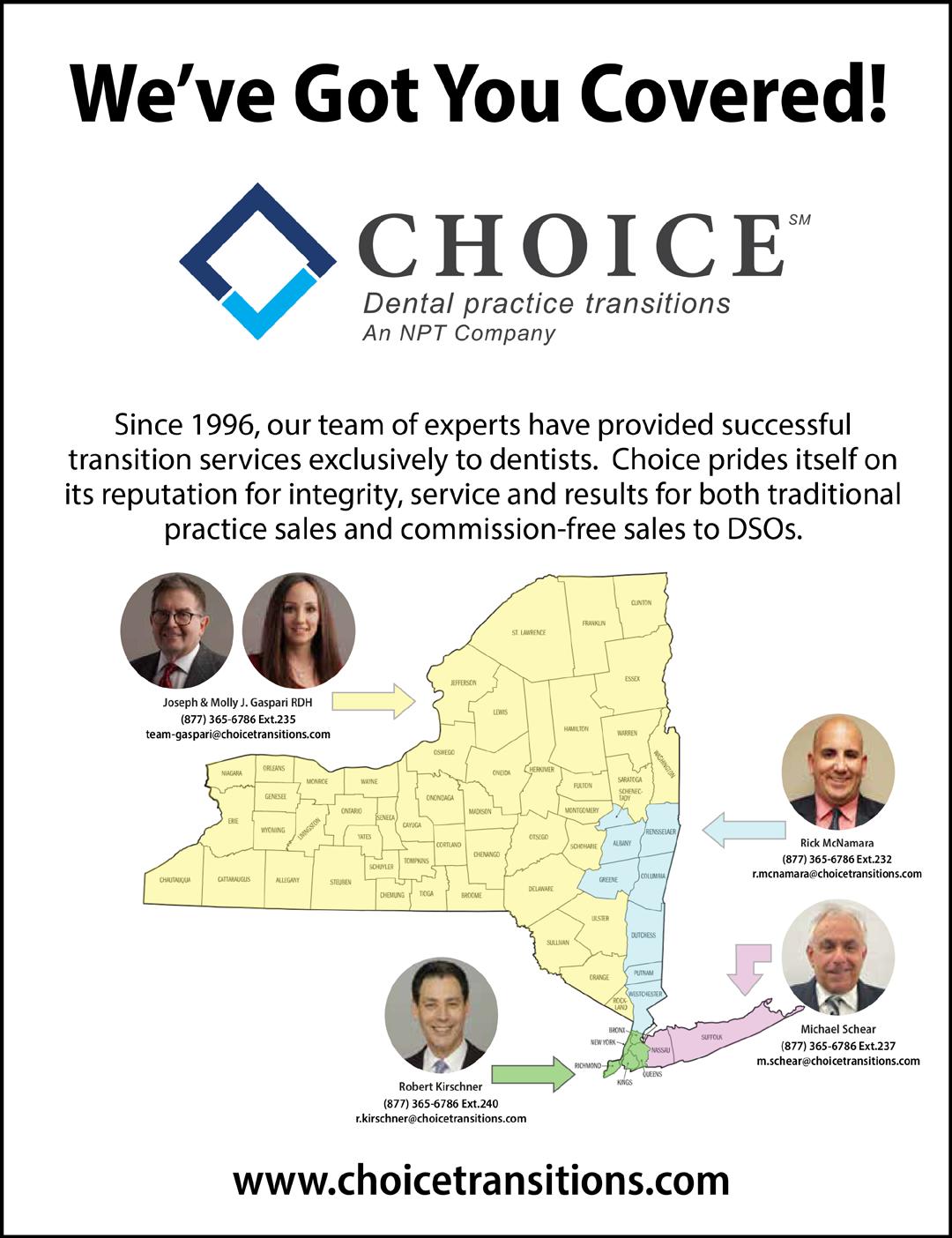
NASSAU COUNTY Spring Recollections
Eugene Porcelli, D.D.S., Executive Director
Spring has ended its run and now we’re diving into summer. But looking back, we note that our Greater Long Island Dental Meeting, held April 25-26, was a great success. With over 85 exhibitors, 40 courses and more than 1,200 registered attendees, in-person regional meetings may not be dead yet!

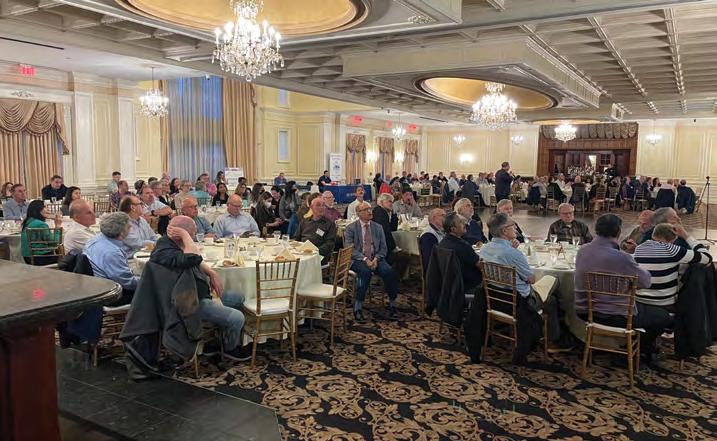
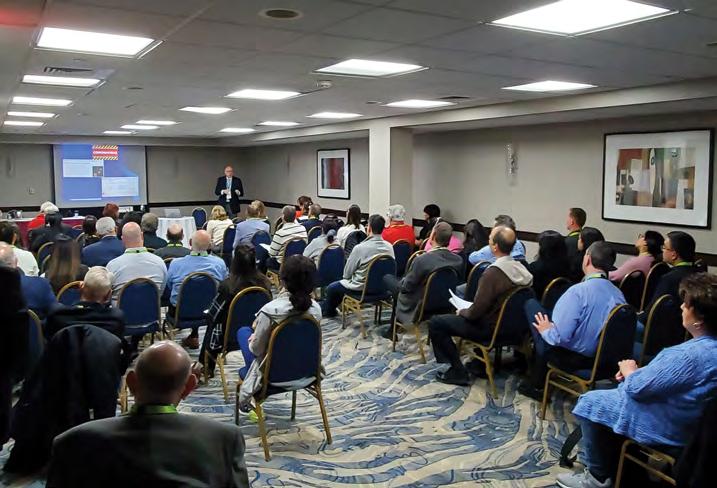
That was closely followed by our spring General Membership Meeting on May 1. It was well-attended, and the vast majority seemed to be pleased with our new venue at the Inn at New Hyde Park and the upgraded menu. The course on “Transforming Dentistry Through Lasers,” by Dr. Howard Golan, was also well-received.
The following week, President-Elect Dr. Doug Schildhaus was the team leader of a Flying Doctors of America Medical/Dental Mission to the Andes Mountains of Peru. The trip spanned a week, from May 6-12. His team of physicians, dentists, nurses and healthcare personnel treated over 1,000 patients in need of care in the mountain communities of Huaro and Sullumayo, Peru. In addition, they provided much needed medications, vitamins and healthcare education. After the mission, Dr. Schildhaus took the team sightseeing, a tour that included the famed Wonder of the World Machu Picchu. It was a true life-changing experience for all.
Back home, we held a two-pronged resident event for those finishing their residencies in 2023. On May 18, we had a dinner, followed by two lectures: “I’m Done with My Residency—What Do I Do Now?” and “Employment Contracts—What to Look For, What to Watch Out For.”
Then, on June 11, we had a brunch with a lecture, “Managing Debt While Still
Component
NASSAU COUNTY
Attendees on break from educational offerings at Greater Long Island Dental Meeting were treated to live music and Ferrari display in exhibit area.
Dr. Peter Mychajliw, infection control officer, Northwell Health, was among presenters at GLIDM.
34 JUNE/JULY 2023 The New York State Dental Journal
May General Membership Meeting was well-attended.
Planning for Your Future,” followed by a Job Fair, where the residents, as well as hygienists and dental assistants, could interview with prospective employers.
Come September
On September 10, we are partnering with the Oral Cancer Foundation for a “Walk to Fight Oral Cancer” at Bethpage State Park. Besides raising awareness and funds
to fight oral cancer, we will have a large tent set up to perform free oral cancer screenings for the public and where we will be providing books, pamphlets and T-Shirts.

This will be followed by our Third Annual Shredding and Recycling Event on Saturday, Sept. 23. Nassau members can have their old charts and documents shredded and their old X-ray films and electronics destroyed and recycled free of charge.
NASSAU COUNTY
There is a nominal fee for members of other components and a more significant fee for nonmembers.
Our CE course schedule for 2023 has turned out to be one of our biggest ever, with 37 courses scheduled providing a total of 98.5 CEUs. This includes an all-day course on Sept. 29 by nationally renowned speaker Dr. Richard Madow entitled “Ten Ways to Create a Memorable Patient Experience in YOUR Practice!” This unique, fun and informative lecture includes both breakfast and lunch and was designed for the entire staff to attend.

On top of this, in partnership with the Suffolk County Dental Society, we are in the midst of planning our 14th annual Long Island Women’s Dental Symposium, “Scrubs and Stilettos,” to be held on Friday, Nov. 3, at the Heritage Club at the Bethpage Golf Course. We are expecting a dozen women speakers to present on topics of interest to women dentists.
Enjoy the summer and like the song said, “See you in September!”
SEVENTH DISTRICT Save Money on Repairs
Becky Herman, Executive Director
NASSAU COUNTY
The Seventh District partnered with J&L Dental to offer a new program to members, “Learn How to DIY Your Small Equipment Repairs.” Dr. Mark DiMartino, a member dentist in Farmington, graciously offered his office space to host this special event, held on May 3.
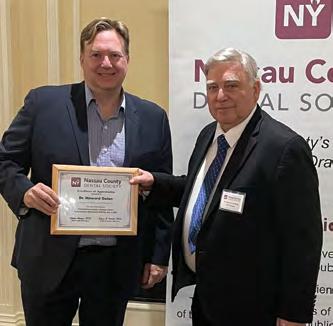 President Stephen Akseizer, right, presents certificate of appreciation to Dr. Howard Golan, presenter of lecture on lasers at General Membership Meeting.
President-Elect Doug Schildhaus with young patients he encountered on medical/dental mission to Peru.
Dr. Schildhaus with his team of medical/dental volunteers on mission to Andes Mountains of Peru.
President Stephen Akseizer, right, presents certificate of appreciation to Dr. Howard Golan, presenter of lecture on lasers at General Membership Meeting.
President-Elect Doug Schildhaus with young patients he encountered on medical/dental mission to Peru.
Dr. Schildhaus with his team of medical/dental volunteers on mission to Andes Mountains of Peru.
The New York State Dental Journal ● JUNE/JULY 2023 35
Seventh District cont.
Experts from J&L presented to participants, who rotated through four stations: IT & high technology, sterilization, the utility room and the operatory. Attendees were treated to a light dinner and tour of the office.
District Participates in NYSDA Advocacy Day
Dr. William Hurtt, Seventh District President-Elect and Governmental Affairs representative; Dr. Theresa Casper-Klock, NYSDA Trustee and District Board member; and Ms. Becky Herman, Executive Director, participated in NYSDA’s Advocacy Day events held April 17-18 in Albany.

It was an opportunity to meet with legislators and their staffs to lobby for issues impacting dentists across the state.
Monroe County Hosts Dr. Alireza Sadr
The Monroe County Dental Society held its Semi-Annual Meeting on Friday, April 28, at the RIT Inn & Conference Center. Dr. Alireza Sadr, director of operative dentistry at the University of Washington, spoke on “Structural Adhesive Dental Restorations.”
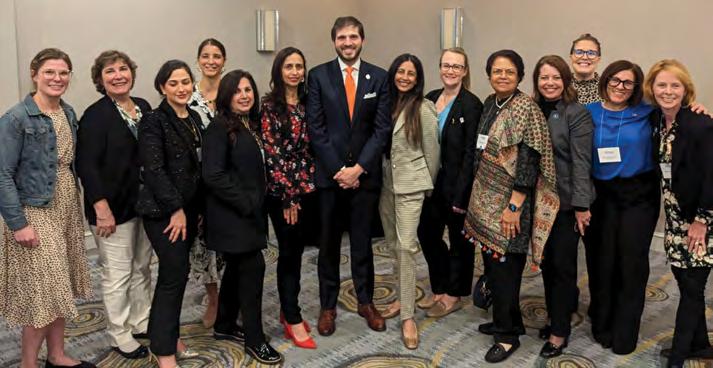
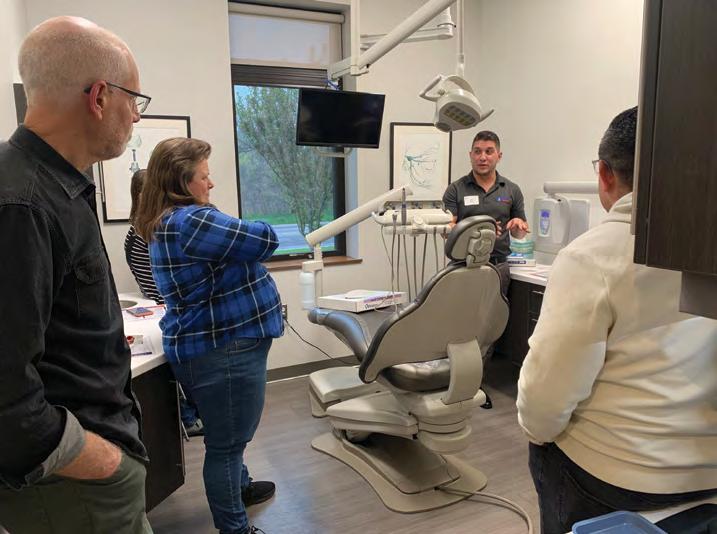
A special thank you to our event sponsors: DDSMatch, ERC Applications, GentleWave, J&L Dental, M&T Bank, Straumann, Urgent Dental Care, Walsh Duffield and ZimVie.
Dr. Richard Rubin Hosts District Board Meeting
A special thank you to Dr. Richard Rubin, Empire Dental Administrators, Inc., treasurer and past president of the Seventh District Dental Society, who hosted the District Board at his renovated barn in Canandaigua on May 15 for the Board’s last meeting before a summer break.
Members were also treated to a sheep herding demonstration.
Component
NYSDA fielded contingent of members and staff on Advocacy Day to meet with legislators, including Sen. Andrew Gounardes, at center, of Brooklyn.
J&L Dental representative provides instruction on making repairs to small equipment in dental office.
36 JUNE/JULY 2023 The New York State Dental Journal
In Albany for NYSDA Advocacy Day. From left, Theresa Casper-Clock, NYSDA Trustee and district Board member; President-Elect and Governmental Affairs representative William Hurtt; Executive Director Becky Herman.
SEVENTH DISTRICT
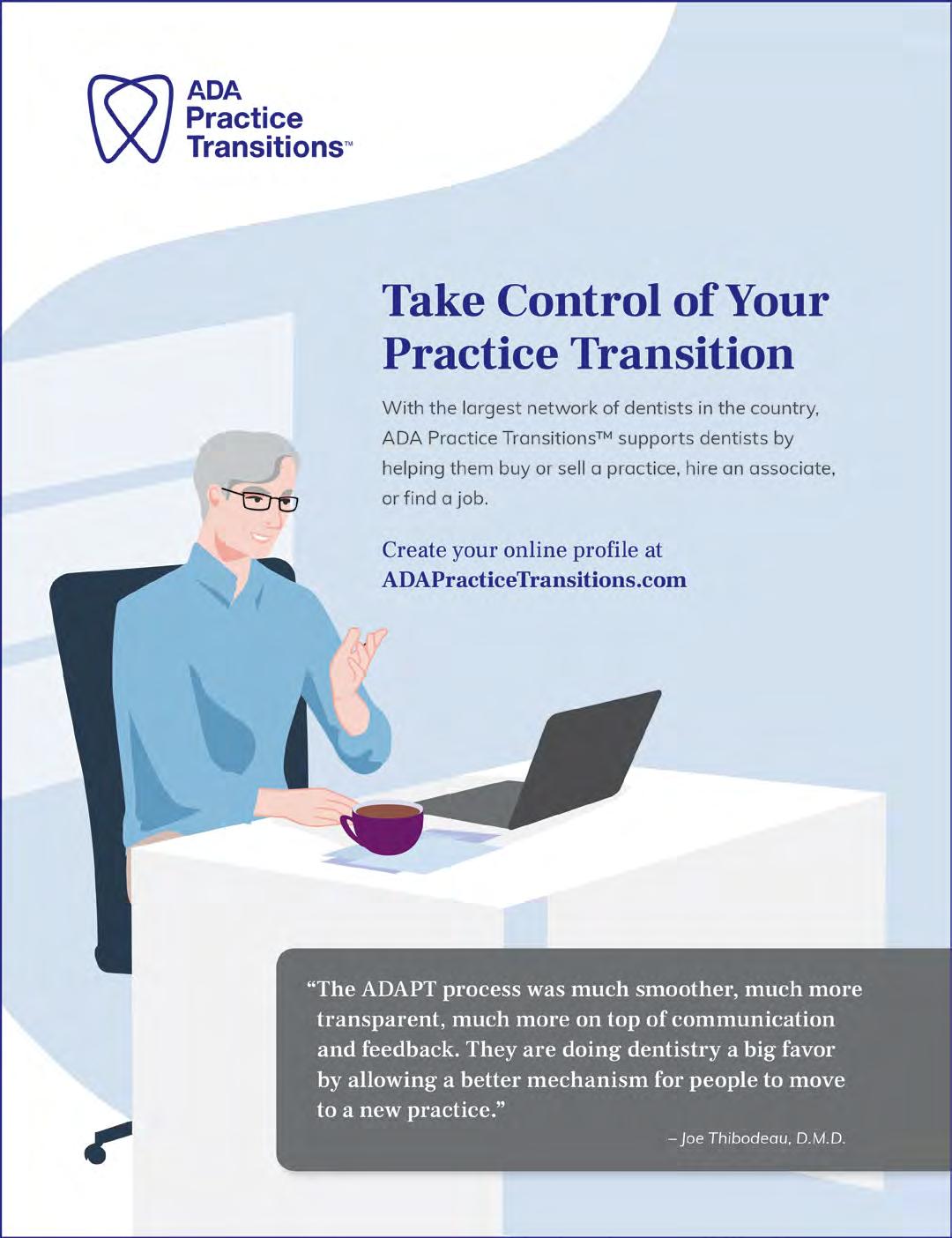
Component
Seventh District cont.
Semi-Annual Meeting a Success
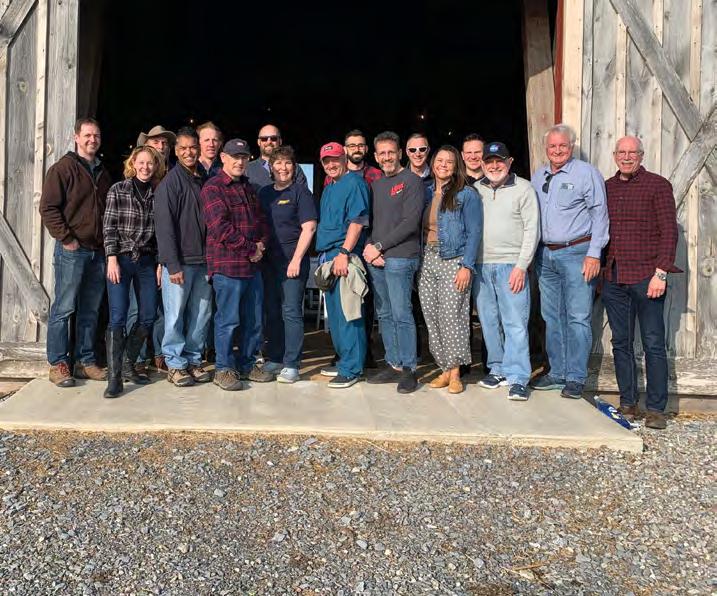
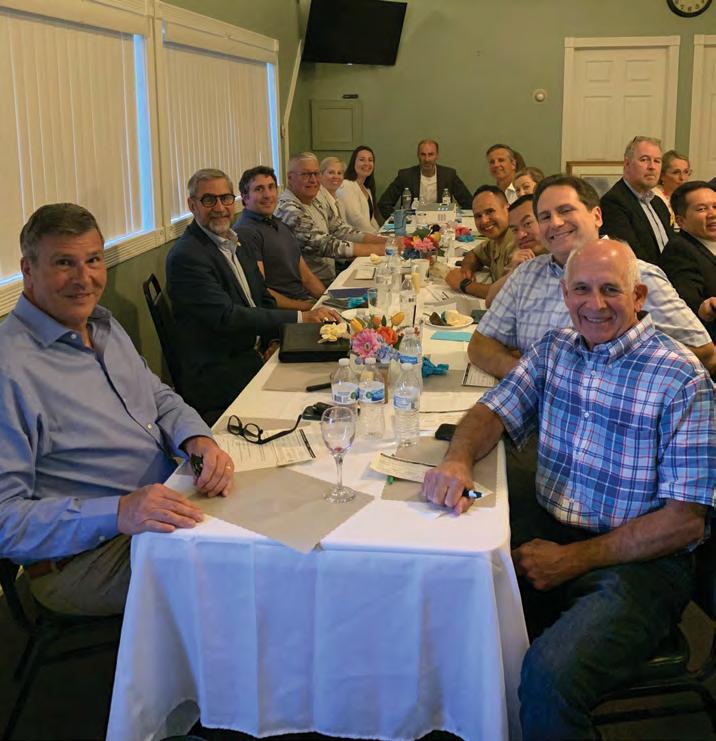
Dr. M.K. (Bobby) Baig presented during the Seventh District Dental Society’s Semi-Annual Meeting May 19 at Locust Hill Country Club in Pittsford. He spoke on “Dental Implant Restorations: Prevention Through Planning—The Fine Line Between Success and Failure” to an audience of over 85 attendees, including 23 residents and faculty from the Eastman Institute for Oral Health (EIOH).
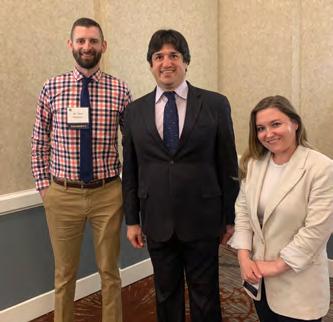
Thank you to our event sponsors: Crane Dental Laboratory, DDSMatch, DePlaque, Gentlewave, Henry Schein, J&L Dental, M&T Bank, RTG, TD Bank, Vision Financial Group and Walsh Duffield.
Dr. Isaac Kuyunov Joins MCDS Board of Directors
Dr. Isaac Kuyunov was sworn in as a new member of the Monroe County Dental Society (MCDS) Board by Dr. Todd Pedersen, MCDS President, on May 22. He is filling a vacant seat until December 2023 and is then eligible to run for a new three-year term. Welcome, Dr. Kuyunov!
SEVENTH DISTRICT
SEVENTH DISTRICT
Seventh District Board went country for its May meeting, held in renovated barn on Canandaigua farm of past president Richard Rubin.
Members Steuben County Dental Society meet for lecture and election of officers.
Monroe County President Todd Pedersen, left, and Business Chair Shyenne Pougher welcome presenter, Alireza Sadr, University of Washington, to MCDS Semi-Annual Meeting.
38 JUNE/JULY 2023 The New York State Dental Journal
Steuben County Presents “Management for Endodontic Emergencies”
Steuben County members met in person May 23 at Fran’s Landing in Painted Post to hear from Dr. Maksim Serebro, an endodontist at Finger Lakes Endo, on “Management for Endodontic Emergencies.” Several members from Chemung County in the Sixth District were also in attendance. A business meeting was held prior to the presentation to vote in new officers. Congratulations to Drs. Melissa Brown, president; Sarah Franklin, vice president; and Fanrui (Ray) Zeng, treasurer.
SEVENTH DISTRICT
New Member Spotlight
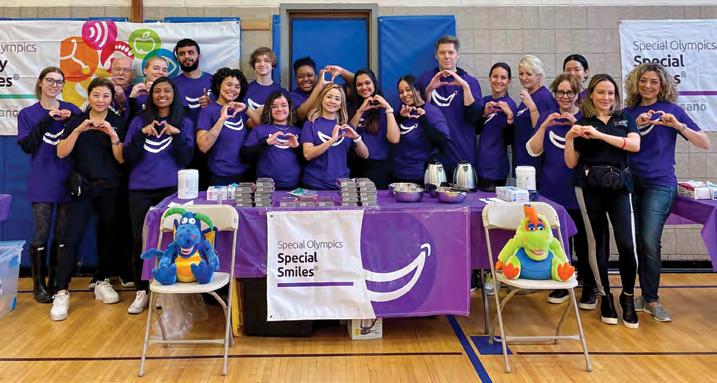
We’ve highlighted Dr. Rosemeire SantosTeachout in our member spotlight, https:// www.7dds.org/membership/member-spotlight. Dr. Teachout is a humanitarian at heart—kind, compassionate and dedicated to serving others. She has participated in five mission trips in the last 15 years, sharing her dental knowledge and skills with those less fortunate around the globe.

When asked for her advice for new dentists, she said, “Dentistry is a servant profession. There is great satisfaction in taking care of people. Use the skills you have learned and make time to help others.”
NEW YORK COUNTY Bravo, Columbia Grads!
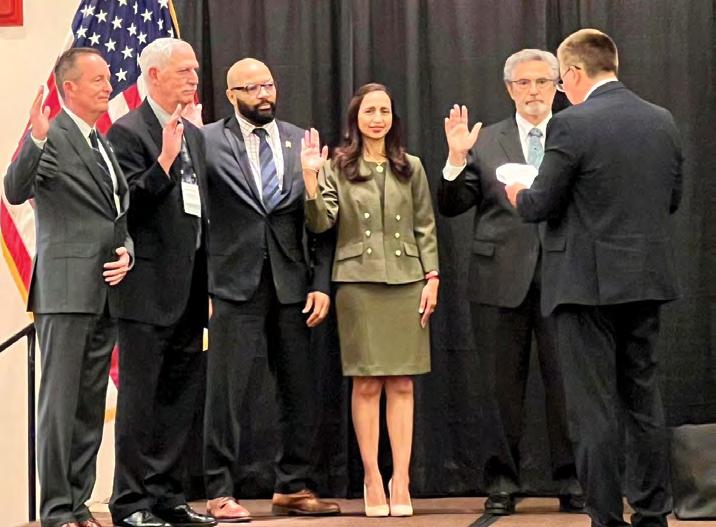 Vera W.L. Tang, D.D.S.
Vera W.L. Tang, D.D.S.
A graduation celebration for the 2023 graduates of Columbia University College of Dental Medicine was held on April 20 at NYCDS.
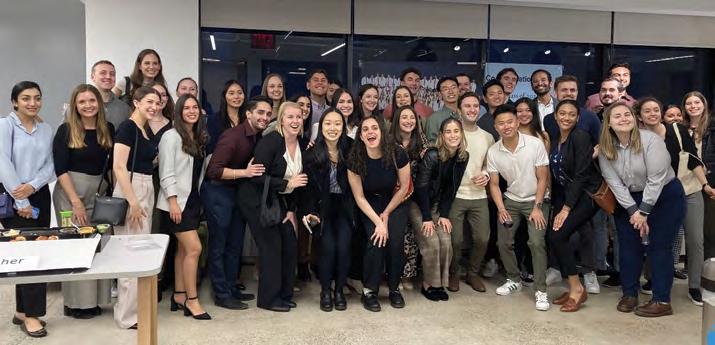 Rosemeire Santos-Teachout.
Special Smiles volunteers at New York Metro Games Special Olympics May 20.
Columbia College of Dental Medicine Class of 2023 gather at NYCDS to celebrate their success.
Rosemeire Santos-Teachout.
Special Smiles volunteers at New York Metro Games Special Olympics May 20.
Columbia College of Dental Medicine Class of 2023 gather at NYCDS to celebrate their success.
NEW YORK
The New York State Dental Journal ● JUNE/JULY 2023 39
NYCDS member Maurice Edwards, third from left, is sworn in as NYSDA Vice President during House of Delegates meeting in June. Also taking oath of office, administered by Immediate Past President James Galati, are from left, Secretary-Treasurer Paul Leary, Speaker William Karp, Dr. Edwards, President-Elect Prabha Krishnan, President Anthony Cuomo.
COUNTY
Component
New York County cont.
Over 50 graduates attended the festive event, which was organized by the mentor for the class, Dr. Lois Jackson, in conjunction with Columbia University School of Dentistry Alumni Association and Columbia University School of Dentistry.
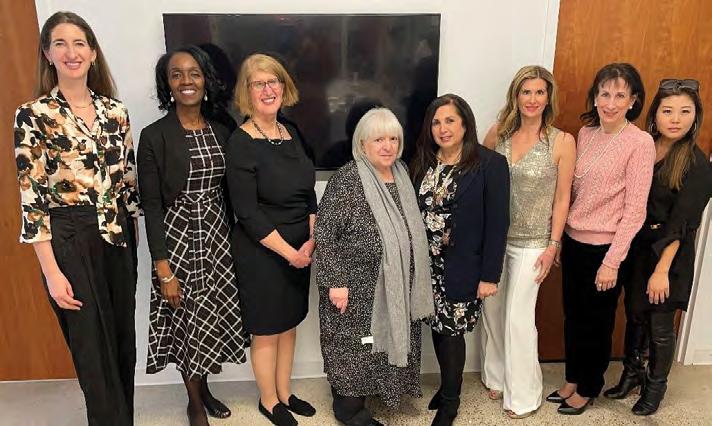
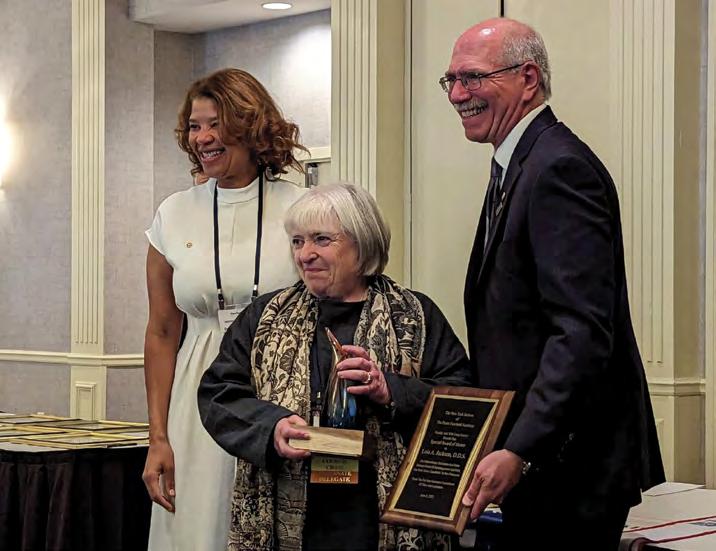
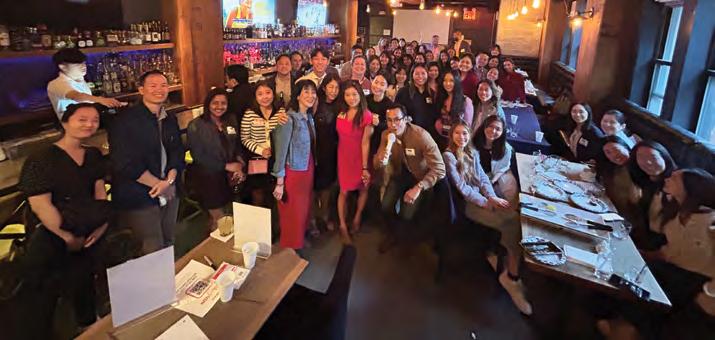
In her comments to the graduating class, Dr. Jackson applauded the students for completing dental school while navigating the challenges of COVID restrictions.
Special thanks to Bank of America Practice Solutions and PKF O’Connor Davies for making this event possible.
NYU Signing Day a Great Success!
Thanks to the efforts of NYSDA, several volunteers, and NYU College of Dentistry’s Clinical Assistant Professor of Periodontology and Implant Dentistry and NYCDS Vice President Vera Tang, a record number of students (315!) from NYU signed up to become ADA members. Bravo!
AAPI Month Celebration
NYCDS and corporate friend Bank of American Practice Solutions were proud sponsors of the newly formed Asian American Dental Society’s karaoke party on May 10. The party was a fun kickoff event for the organization and a celebration of Asian American Pacific Islander Heritage Month. Kudos for a great first event!
Special Olympics Special Smiles
NYCDS volunteers participated in the Special Smiles program at the Special Olympics New York Metro Games on May 20. The volunteers provided comprehensive oral healthcare information, free dental screenings and instruction on proper brushing and flossing techniques to 43 athletes. Special Olympics athletes also received important supplies, like toothpaste, toothbrushes and fluoride varnish. This was all possible thanks to the leadership of Community Outreach Com-
Speed learning lecturers are from left, Drs. Lauren Feldman, Lorna Flamer-Caldera, Gail Schupak, program organizer Lois Jackson, Maria Maranga, Stacy Spizuocco, Amy Dukoff, NYCDS President Mina Kim.
Attendees at Karaoke City celebrating AAPI month May 10.
NEW YORK COUNTY
NYSDA Trustee and NYCDS past president Lois Jackson, center, receives Pierre Fauchard Academy Honor Award from New York Section during NYSDA HOD meeting. Presenting award are Amarilis Jacobo and Jay Skolnick, co-section chairs.
40 JUNE/JULY 2023 The New York State Dental Journal
mittee Chair Anna Viron and NYCDS President and longtime Special Olympics Special Smiles leader Mina Kim.
Mentee/Mentor Meetup
The NYCDS Mentorship Committee hosted another terrific mentoring program on the evening of May 8. The program was sponsored by our corporate friend Straumann. The company provided refreshments and two of their representatives, Lindsay McCarthy and Tom Corcoran, gave an extremely informative presentation on digital dentistry, with a focus on implants. Following the presentation, an open forum began, during which the 25 mentees and mentors in attendance discussed several topics, such as the pros and cons of DSOs, associateships, compensation (production vs. collections) and interviewing for a position.
The next mentorship program will be held in the early fall. You can register as a mentee or a mentor at nycdentalsociety. org/mentorship.
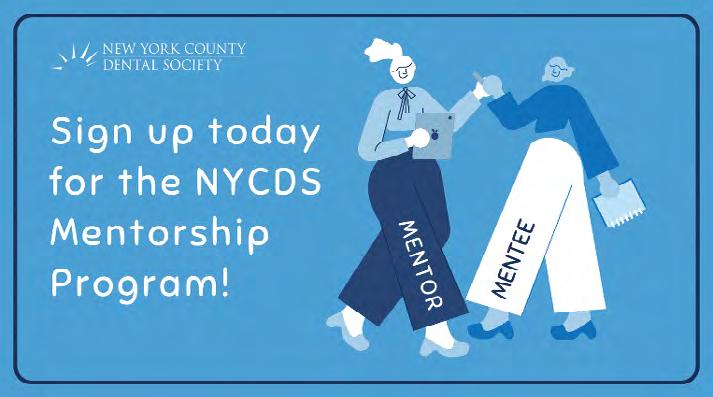
A Speed Learning First!
NYCDS was pleased to host its first women-led speed learning program on April 26. The fast-paced learning experience featured a diverse group of women and cutting-edge topics. Special thanks to our lecturers—Drs. Lauren Feldman, Lorna Flamer-Caldera, Gail Schupak, Maria Maranga, Stacy Spizuocco and Amy Dukoff.
The next speed learning program will be held on Oct. 27, with new speakers and topics.

GNYDM Coming to Town
The Greater New York Dental Meeting, sponsored by New York County and Second District Dental societies, is set to take place Nov. 24-29 at the Jacob K. Javits Convention Center on 11th Avenue, between 34th and 39th Street, New York City. Exhibit dates are Nov. 26-29.
Registration is now open for the largest dental meeting in the U.S. Visit GNYDM.COM.
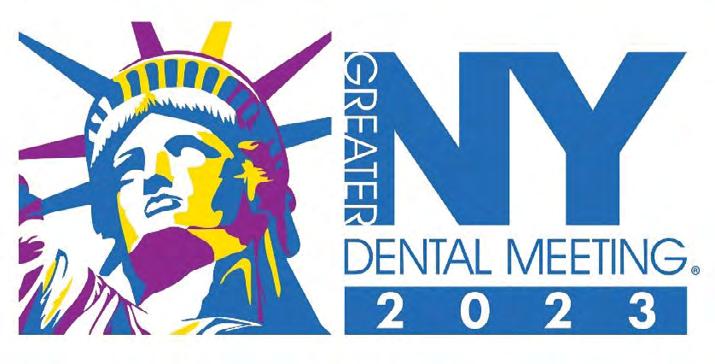
Ethics & Social Media Use
The NYCDS Ethics Committee, chaired by Dr. Steven Cho, held a program on “Ethical Considerations Regarding the Use of Social Media by Healthcare Professionals” on
Registration is now open for NYCDS Charity Golf Outing Sept. 27.
The New York State Dental Journal ● JUNE/JULY 2023 41
NEW YORK COUNTY
May 15. The program was led by Dr. Eric A. Wachs, director of the oral & maxillofacial surgery curriculum and clinic at the Touro College of Dental Medicine.


The lecture gave attendees the opportunity to view their own social media presence (and that of other healthcare professionals) in light of the ethical principles of patient autonomy, beneficence, justice, non-maleficence and veracity. It was an interactive lecture, with attendees sharing their feedback on a variety of social media scenarios.
Registration Open for NYCDS Golf Outing
You can now register for the 7th annual NYCDS Charity Golf Outing, which will be held at a new venue, the Metropolis Country Club (www.metropoliscc.org) in White Plains, Sept. 27. It is sure to be a fantastic time, with the added bonus of raising funds for Special Olympics.
Non-golfers can enjoy the beautiful grounds and a cocktail reception and dinner. Don’t delay. Go to charitygolftoday. com/nycds to reserve your spot!
Continuing Education
The 2023 Summer/Fall CE program brings new courses and returning favorites. Highlights include a highly anticipated course on “Innovations in Aesthetic Dentistry: Everything You Need to Know About Veneers,” led by K. Michael M. Ghalili, D.M.D., M.S.D. Day 1 is a lecture, and Day 2 is hands-on—attendees will learn on ivorine teeth to prep four anterior veneers, independently and with supervision.
We are also pleased to have a full-day lecture, “Actions and Algorithms for Medical Emergencies: How to Save a Life, Including Your Own,” on Wednesday, Oct. 4, led by Dr. Daniel Pompa. This course will cover three simple chairside, noninvasive tests to help avoid an emergency, how to recognize the most frequent life-threaten-
ing emergencies and review a systematic approach to treat the most common lifethreatening scenarios, and much more.
Upcoming CE Schedule
• Wed. Sept. 20: “Innovations in Aesthetic Dentistry: Everything You Need to Know About Veneers.”
• Thurs. Sept 21: “Innovations in Aesthetic Dentistry: Everything You Need to Know About Veneers.”
• Thurs. Sept. 21: OSHA-Mandated Update for Dentists and Staff—”What You Need to Know to Comply with the Law.”
• Wed. Sept. 27: Basic Life Support/CPR Certification Course. (In person)
• Wed. Oct. 4: “Actions and Algorithms for Medical Emergencies: How to Save a Life, Including Your Own.”
• Wed. Oct 25: Infection Control for the Dental Practice. (In person)
• Fri. Oct. 27: Save the Date! Speed Learning: 6 Speakers, 6 Topics, 6 Credits. Visit www.nycdentalsociety.org for our latest course and registration information.
NINTH DISTRICT
Continuing with the Old and Adding the New Olga
Lombo-Sguerra, D.D.S.
This year, we not only continue existing traditions with our Give Kids A Smile programs at Head Start locations and at Touro College of Dental Medicine, we have forged new relationships as well, expanding in scope and into new areas and facilities.
Dr. Rosa Martinez, Dr. Renuka Bijoor and Executive Director Stephan Cancian have made great strides implementing these programs and are always looking for volunteers to help. Reach out to the 9th District staff if you’d like to be a part of this worthwhile annual endeavor.
We’re looking forward to a number of upcoming events. Over the summer, the New Dentist Committee is sponsoring “Ask Me Anything” for D3 and D4 Touro students. This unique speed-dating-styled event will allow students to ask anything they want to know of a panel of general practitioners and specialists. Follow that up

with our September 7th New Dentist Ice Cream Social—always a big hit and open to all new dentists in and around the Ninth. September is also when the Ninth will host our third General Meeting of the year. Members are looking forward to Dr. Miriam Robbins’s presentation of “Management of Medically Compromised and Special Needs Patients” at the Sleepy Hollow Hotel & Conference Center in Tarrytown. This freeto-Ninth members event earns attendees 7 MCE credits toward relicensure.
Moments to Remember
Our annual Signing Day tradition continued at Touro in March. And a new tradition began, as well—the 9th District hosted its first-ever Shredding Day. This HIPAA-compliant event, a benefit for our members, was a big hit and will become an annual tradition.
NINTH DISTRICT
Celebrants at social May 17 at Briarcliff Manor marking another successful Frills & Drills.
Organizers, volunteers at Touro College of Dental Medicine April 20 for Give Kids A Smile. Seated, from left: Cyrus Shojai, assistant principal, Gorton High School; Drs. Ruba Rizqalla, Bharat Joshi; Ms. Navneet Kaur. Standing, from left, Drs. Anita Agarwal, Gemini Patel, Alexander Hall, Olivia Masry, Joseph Manzi, Duraid Sahawneh, Jennifer Kim, Heather Fugazy.
Touro Dental students volunteer to assist at Give Kids A Smile.
Component New York County cont. 42 JUNE/JULY 2023 The New York State Dental Journal
And, speaking of annual traditions, this year’s social celebrating Frills & Drills was one of the best attended to date. The Manor in Briarcliff Manor has become a favorite venue for 9th members, as well. The warm inviting staff and the beauty of the Manor make going there a real treat.
Our committees, Board and executives have been busy addressing the needs and concerns of our members, and our study groups are nearly back to pre-pandemic activity—a real boost for members who enjoy in-person CE closer to home or office.
SECOND DISTRICT Credit where Credit is Due
Alyson Buchalter, D.M.D.
By all measures, the 2023 NYSDA House of Delegates meeting was a resounding success. This was in no small part due to the leadership and actions of Speaker of the House, SDDS’s own, Dr. Steven Gounardes.
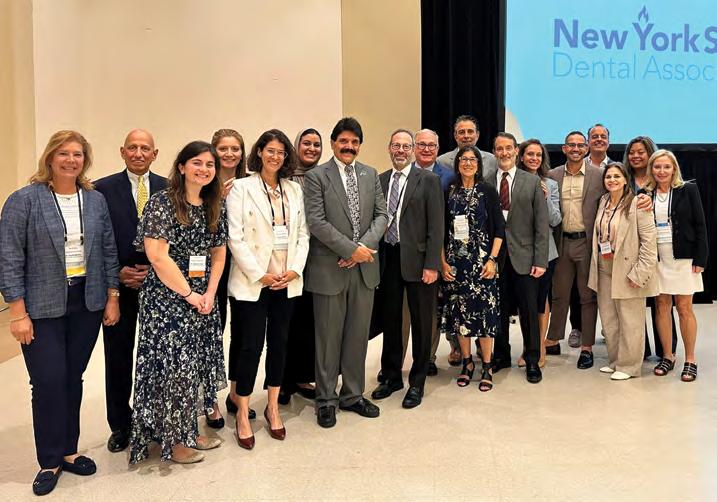
For the past eight years, Dr. Gounardes has run the NYSDA HOD like a well-oiled machine. He instituted reforms, established norms and educated House members. He made himself available for in-service tutorials at all components, preparing caucus members for the annual meeting, and was available to answer any question that arose during the meetings. Every meeting during his time in office ran remarkably smoothly. And each time, all the business of the House was concluded by the end of the Saturday session, a feat previously unknown.
Dr. Gounardes’s even-keeled temperament and vast knowledge gave all House members the confidence needed to move through many difficult deliberations. For all he has done for NYSDA, Dr. Gounardes received a Speaker’s Golden Gavel, emblazoned with his signature mustache. From all of us at SDDS: Thank you, Steve, for serving so well.

All Hands on Deck
Saratoga Springs was a wonderful backdrop for the 2023 NYSDA House of Delegates meeting. SDDS wants to acknowledge all the members of our caucus for their ex-
SECOND DISTRICT
Members SDDS caucus gather for group photo on floor of NYSDA House, meeting in June in Saratoga Springs.
Speaker Steven Gounardes, left, accepts golden gavel, presented by NYSDA Immediate Past President James Galati at conclusion of HOD meeting, the last one over which Gounardes presided.
The New York State Dental Journal ● JUNE/JULY 2023 43
Component
Second District cont.
emplary service and thank them for giving their time and energy.
Both seasoned and new members jumped in and engaged with all of the topics being discussed. The SDDS caucus, chaired by President Dr. Raymond Flagiello, included delegates Drs. Alyson Buchalter, Cherry Libramonte, Phyllis Merlino, Joseph Merola, Vice Chair Tricia Quartey, Sandra Scibetta, Paul Teplitsky, Valerie Venterina and Kristin Wolf, and alternate delegates Drs. Christen Carute, Michael Donato, Theresa Eliscar, Mitchell Mindlin, Stephanie Sager and Aia Shalan. They were joined by our NYSDA Trustee Dr. John Demas and Executive Director Mr. Bernard Hackett, both of whom made sure the caucus had all the information needed to efficiently consider all the resolutions.
A special thank you to Ms. Christine Terio for all her help. Also present was SDDS member Dr. Sean Shekib, current president of the New York State Academy of General Dentistry. SDDS was once again proud to sponsor two tables at the New York State Dental Foundation Luncheon. And a shout-out to caucus members who made their way to the microphones during the reference and HOD sessions. It can be daunting, but our members were not intimidated.
Greater New York Dental Meeting
It’s that time of year again! Registration for the 2023 Greater New York Dental Meeting is now open. And, as usual, registration is free. There is a great lineup of world-renowned speakers scheduled. This year we are bringing back perennial favorites, including Drs. Gordon Christensen, David Hornbrook, Joyce Bassett, Tim Hempton and Thomas Viola, as well as a host of amazing rising stars. There will be workshops and seminars on any topic you can imagine, including es-
thetics, oral surgery, practice management, Botox, veneers, endodontics, and so much more. The GNYDM is again offering popular bundles for the CE programs—the more courses you take, the more you save!
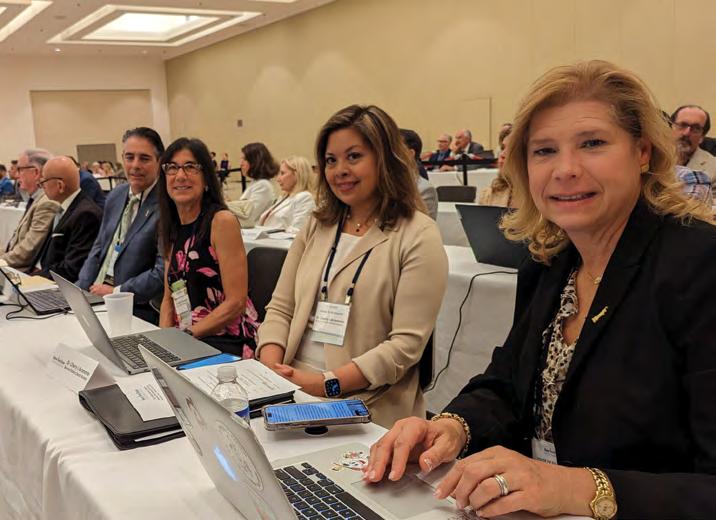
As usual, volunteering is a great way to get free CE. The Volunteer Appreciation Dinner will again be held at the Marriott Marquis. The evening of fun, food, raffles and camaraderie is the GNYDM’s way of thanking its volunteers. They (hopefully, you!) are vital in making the GNYDM what it is: the greatest dental conference in the country.
New treats at the meeting will include
the Monday afternoon free wine and beer event for all attendees. Tuesday will be “puppy day,” to introduce attendees to adorable, adoptable puppies. Actor Michael Imperioli of the TV series Sopranos and White Lotus will headline the Monday Celebrity Luncheon. Please register and volunteer, today!
Hospital Residency Visits
Brooklyn and Staten Island are home to 13 hospital residency programs. As in the past, members of the SDDS leadership visited all of them. They spent that time reminding the residents why being a member of the
SECOND DISTRICT
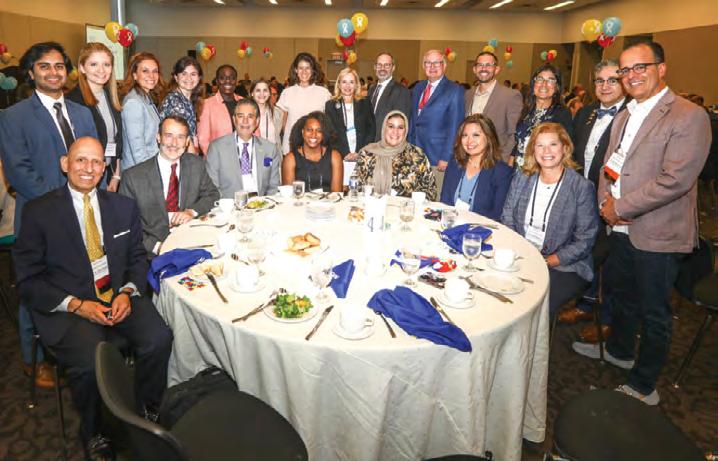 SDDS sponsored and occupied two tables at NYS Dental Foundation luncheon, held during NYSDA House meeting.
SDDS caucus members captured during proceedings of NYSDA House.
SDDS sponsored and occupied two tables at NYS Dental Foundation luncheon, held during NYSDA House meeting.
SDDS caucus members captured during proceedings of NYSDA House.
44 JUNE/JULY 2023 The New York State Dental Journal
tripartite is so very important. The longer we are members of organized dentistry, the more we come to realize how important our combined voices are for advocacy, resources, networking and more.


Traveling across the SDDS in April and May, we made sure young dentists, just starting in our profession, are also aware of the benefits of membership. Spending time reaching out to dentists at the beginning of their careers is an important part of our outreach. We believe in-person discussions with these young doctors are key to cultivating both membership and the next generation of leaders.
Special thanks to Drs. Saad Butt, John Demas, James Sconzo, Paul Albicocco, Phyllis Merlino, Steven Gounardes, Mitchell Mindlin, Stephanie Sager and Alyson Buchalter for giving their time and passion to encouraging young dentists to join our tripartite. And thank you to the hospital dental departments across the SDDS for allowing us time with their residents.


Richmond County Golf Outing
Richmond County Dental Society is the branch society of the SDDS. Each year around this time, they remind us that fun and camaraderie are important parts of membership. On June 8, RCDS held its annual Golf Outing. This year’s event was organized by society Vice President Dr. Bryan Pieroni and was held at the Richmond County Country Club.
It was a day filled with golf, raffles, prizes, food and libations. Winners included: Low gross—Ron Leader, Mike Stevens, Erik Mosholt and Jonathan LoPresti; Low net—Mike Donato, Stephen Cirullo, Ray Flagiello and Dom Melchiore; Longest drive—Chris Cavendish; Closest to pin— Erik Mosholt. Congratulations to all the winners.
Alliance Risk Group






800-579-2911
Abyde







800-594-0883 Ext. 1




Volvo
800-550-5658 ada.org/volvo
Take advantage of Quality, Discounted Services through NYSDA Endorsed Services BANKING Bank of America Practice Loans 800-932-2775 800-497-6076 US Bank Credit Card 888-327-2265 FINANCIAL SERVICES CareCredit Patient Financing 800-300-3046 (#5) Altfest Personal Wealth Management Financial Planning 888-525-8337 Best Card Credit Card Acceptance 877-739-3952 TekCollect Collections 888-292-3530 Laurel Road Student Loan Refinancing 855-245-0989 INSURANCE SERVICES MLMIC Professional Liability Insurance 800-683-7769 Bronx, Manhattan, Staten Island & Westchester 888-263-2729 Brooklyn, Queens, Nassau & Suffolk 888-744-6729 Other Counties Arthur Gallagher Other Business 888-869-3535 Insurance Long-term Care Long-term Care Insurance 844-355-2596 OTHER Henry Schein Electronic Prescribing 800-734-5561 Prosites Website Development 888-932-3644 SolmeteX Amalgam Recycling 800-216-5505 Mercedes Luxury Vehicles 866-628-7232 Lands’ End Apparel for Staff 800-490-6402 UPS Delivery Services 800-636-2377 Travel Discounts Exclusive Travel Program www.nysdental.org iCoreExchange Secure Email 888-810-7706 The Dentists Supply Company Dental Supplies 888-253-1223
Background
Screening
HIPPA Compliance
Sustainable
Vehicles
When enlarging or reducing this logo, always make sure to select Scale Strokes & E ects to maintain the integrity of the gradients in the core graphic. Main Logo on White Background Vertical Logos on White Background Vertical Logos on Charcoal Background (with drop shadow behind-right of core graphic) Reversed-out Vertical Logos on Green/Charcoal Background Main Logo on Charcoal Background (with drop shadow behind-right of core graphic) Main Logo on Carbon Fiber Background (with drop shadow behind-right of core graphic) Reversed-out Main Logo on Carbon Fiber Background 2-color Main Logo * These logos are never to be placed over any other colors, photographs, illustrations, charts or type/text.
For further information about NYSDA Endorsed Programs, call Michael Herrmann at 800.255.2100
The New York State Dental Journal ● JUNE/JULY 2023 45
Read, Learn and Earn
Readers of The New York State Dental Journal are invited to earn three (3) home study credits, approved by the New York State Dental Foundation, by properly answering the following 30 True or False questions, all of which are based on articles that appear in this issue.
When you have completed the questionnaire, return it to the New York State Dental Foundation, along with the appropriate fees: $60/dentists; $40/hygienists. Nonmember fees are: $120/ dentists; $80/hygienists. All those who achieve a passing grade of at least 70% will receive verification of completion. Credits will automatically be added to the CE Registry for NYSDA members.
For a complete listing of online lectures and home study CE courses sponsored by the New York State Dental Foundation, visit www.nysdflearning.org.
Understanding Persistent Bleeding in Children—Page 16-20
1. Persistent bleeding is a common event for dental procedures.
❑ T or ❑ F
2. A liver clot is a rare occurrence that stems from abnormal coagulation and prolonged bleeding.
❑ T or ❑ F
3. Fibrinolysis is not included in a normal hemostatic response.
❑ T or ❑ F
4. Incomplete fibrin clotting has been associated with the formation of a liver clot.
❑ T or ❑ F
5. A lack of constricting vasculature is not a risk factor in liver clot formation.
❑ T or ❑ F
6. There are abundant literature reports regarding the formation of liver clots in the pediatric and adolescent population.
❑ T or ❑ F
❑ Enclosed is a check for the full amount. Members’ fees are $60/dentists; $40/hygienists. Nonmember fees are $120/dentists; $80 hygienists. (Make checks payable to the New York State Dental Foundation.) Mail to NYSDF, 20 Corporate Woods Boulevard, Suite 602, Albany, NY 12211. Questionnaires must be received within 90 days of Journal publication.
Please charge my: ❑ VISA ❑ MasterCard ❑ American Express
Card #
Expiration Date
Name
Address
City State Zip
Telephone
E-mail
ADA #
License #
NYSDA Member? ❑ yes or ❑ no
Local/State Dental Society
continuing education
46 JUNE/JULY 2023 The New York State Dental Journal
7. Direct pressure is important in order to stop hemorrhagic or persistent bleeding.
❑ T or ❑ F
8. Inadequate hemostasis may be treated with sutures and lasers, to name a few.
❑ T or ❑ F
9. In the three clinical cases presented, a complete blood count (CBC) and coagulation studies were ordered to rule out blood dyscrasia.
❑ T or ❑ F
10. Young patients in the mixed dentition may have an added risk of forming a liver clot if dental follicles are in close proximity to the area being manipulated.
❑ T or ❑ F
Sinus Tract vs. Fistula—Page 22-25
1. The primary difference between a sinus tract and a fistula is the number of anatomic spaces or openings involved.
❑ T or ❑ F
2. A sinus is a draining tract that has an abnormal narrow opening.
❑ T or ❑ F
3. A sinus tract cannot originate from the apex of a tooth.
❑ T or ❑ F
4. A stoma is an abnormal narrow opening.
❑ T or ❑ F
5. Histologically, the majority of studies report that the sinus tract is lined with granulomatous tissue.
❑ T or ❑ F
6. A fistula is an abnormal marrow pathway or communicating channel between two anatomic spaces or openings.
❑ T or ❑ F
7. Oroantral fistulas are known to dentists.
❑ T or ❑ F
8. Histologically, fistulas are always filled with granulomatous tissue.
❑ T or ❑ F
9. Histological reports may not be accurate since the terms tract and fistula have been used interchangeably.
❑ T or ❑ F
10. A draining infection from the maxillary sinus into the oral cavity or skin should be correctly identified as a fistula or fistula tract.
❑ T or ❑ F
What is the Prevalence of Temporomandibular Joint (TMJ) Condylar Osteoarthrosis in an Asymptomatic Oral and Maxillofacial Surgery Department Population?
Page 26-29
1. The purpose of the study was to evaluate temporomandibular joint (TMJ) condylar changes in the symptomatic general population.
❑ T or ❑ F
2. Temporomandibular joint disorders (TMD) are uncommon musculoskeletal disease processes.
❑ T or ❑ F
3. Hormonal changes do not impact TMD.
❑ T or ❑ F
4. TMJ osteoarthritis may be present in up to 40% of older adults.
❑ T or ❑ F
5. The study did not grade the severity of TMJ disease, just presence or absence.
❑ T or ❑ F
6. Age is associated with TMJ flattening.
❑ T or ❑ F
7. As patients get older they are more at risk for TMD.
❑ T or ❑ F
8. Neck pain is a prevalent comorbid condition of TMD.
❑ T or ❑ F
9. Depression and anxiety are often associated with TMD.
❑ T or ❑ F
10. Changes within the TMJ in asymptomatic individuals appear to have a high prevalence and are strongly associated with age more than with gender.
❑ T or ❑ F
The New York State Dental Journal ● JUNE/JULY 2023 47
FOR SALE
FINGER LAKES REGION: Looking to buy thriving practice in wonderful town? Check out this charming 8-operatory practice in quaint village. Choose to buy outright or ease in while learning business through associate-to-owner pathway. Enjoy $1.2M annual production, great staff and wonderful reputation. Education-focused team serves local families in fast-paced, high-energy environment. Practice tucked into beautifully restored train depot and also available for sale. Village full of restaurants and entertainment, including theater, opera company and orchestra — plus strong schools, annual festivals and four-season outdoor activities. Nearby, you’ll find wineries, orchards, more entertainment and two state universities. And it’s all just an hour from Syracuse. Want to learn more about this gem? Contact advisor@ada.org.
ADIRONDACK PARK: Tupper Lake. Nice brick building for sale includes dental equipment and supplies. Running 2 operatories with room for another. Tupper Lake located in beautiful Adirondack Park. Price under $200K for all. Contact owner: tlswilso@gmail.com.
WATERTOWN: General dental practice for sale. Grossing approximately $1.1M. Located north of Syracuse in Watertown, close to Thousand Islands. Practice has 9 operatories with digital X-ray, CBCT, 3D printing and CEREC. Real estate also available. For more information, please contact Sean Hudson by phone: (585) 690-6858; or email: sean@hudsontransitions.com.
CENTRAL WESTCHESTER COUNTY: Established general practice for sale within co-op apartment of 950 square feet; both practice and real estate for sale. Ground level facing major road, with street parking. Growing city with thousands of new apartments under construction; near RR and major roads. Two ops with room for possible third. Mostly FFS with limited insurance. Gross $445K with high net. Apartment has kitchen and bathroom and zoned legal to live in. Asking 80% of net and $265K for apartment. Inquiries to mollync2022@gmail.com.
ORANGE COUNTY: Great opportunity to own your own dental practice. Dentist Owner retiring from 2-dentist flourishing general practice established in 1973. Looking for someone to take over busy practice. Supporting Associate, hygienists and front desk staff willing to remain. Associate has been with practice over 40 years and also thinking of retiring in near future. Front desk staff have been with practice nearly 20 years. Practice previously supported two full-time dentists and has excellent hygiene program. Quality PPO practice now treating 4th generation family members. Great opportunity for right individual. Easy access location, 1 mile from Route 17 and Interstate 84. Located in highgrowth area with plenty of parking at standalone office on very visible highway. Inquiries to: (845) 692-5311; or email: wecatertocowards1@frontier.com.
Online Rates for 60-day posting of 150 words or less — can include photos/images online: Members: $200. Non-Members: $300. Corporate/Business Ads: $400. Classifieds will also appear in print during months when Journal is mailed: Jan, March and July.
SUFFOLK COUNTY: Four-operatory modern general dental practice in medical office complex. Fully digital with PMS, Intraoral and Panorex. Refer most specialties. FFS and PPO. Real estate. Grosses $487K. Contact: Scott.Firestone@henryschein.com; or call: (516) 459-9258.
BRONX: Architecturally designed, beautiful dental office for sale. Well-set-up and very high potential in heavily populated area of working class community. Call (718) 379-4800; leave message.
BROOKLYN: State-of-the-art dental office for sale. Fantastic, rare opportunity. Fully equipped, wellestablished, family practice with 3 ops, private office, reception area and large waiting room. Prime, ground floor, street-access location in heart of Brooklyn (Park Slope/Kensington). Longtime building tenant with amendable property management. Contact for details: (516) 859-1463; or email: izdds@aol.com.
CAPITAL DISTRICT: Located on main road with ample onsite parking. Thoroughly modern, with Dentrix software, 3 Shape Trios scanner, digital X-rays with Scan X. Open three days/week. Great for satellite practice or to grow. Four-chair office: two hygiene and two fully equipped ops for dentist. Post-COVID headed toward $600K gross. Busy hygiene schedule. Building can be part of package deal. Contact by email: drdave329@gmail.com; or (518) 428-1492.
ASTORIA: Nice FFS dental office, plumbed for 3 chairs with 2 chairs active. One block to train and 2 stops to Manhattan. Grossing $250K on less than 18 hours per week. No Medicaid, HMOs or union locals. Big potential to grow, with huge exposure to thousands of pedestrians walking on 36th Ave to train. Front door entrance. Restorative, endodontic, prosthodontic, surgery practice available now and negotiable for quick sale. Contact Teo by email: serafindental@aol.com; or call (917) 704-3011.
BERKSHIRES: Lee, MA. Small town practice in cultural Berkshires of Western, MA. Large, 3,900-square-foot office with 6 ops. Great staff, mostly all cross-trained. 9 hygiene days/week; respectable doctor production. Owner made good living in great space surrounded by great people. Patients always treated with dignity, fairness and excellent dentistry. If this is your goal then an equitable exchange of practice price for value can be reached. Seeking the right dentist(s) to take care of my team and my patients in coming years. Practice price to be determined by how we mutually fit. If this sce-
nario meets your interests and you seek to acquire fully FFS practice in beautiful area, please contact. Email: holly@drjaywisedds.com; or call (413) 243-1222.
ALBANY AREA: Thriving periodontal practice located just 40 miles outside Albany. Five operatories and loyal patient base of 6,600 active patients. Practice has been serving community for decades with top-notch care. Despite almost no advertising efforts, practice attracts impressive 75 new patients/month. Current doctor open to all transition options and willing to continue practicing for another 3-4 years, making for seamless transition for any potential buyer. To learn more and review prospectus for this Albany periodontal practice, please contact Professional Transition Strategies: bailey@professionaltransition.com; or (719) 694-8320. Reference #NY41823.
FINGER LAKES AREA: Well-established general dental practice for sale creating excellent opportunity to own your own practice. With over two decades of service to community, practice has strong patient base of 5,000 active patients and attracts 100 new patients/ month. Seven operatories; six fully equipped and potential for expansion. Current owner open to exploring all transition options and willing to work with new owner to ensure smooth handover. Practice currently supports associate dentist, providing great opportunity for new owner to step in and hit ground running. With collections of $1.609M and EBITDA of $445K opportunity, ideal for experienced dentists looking to expand their business or groups seeking to increase their footprint. Please contact Professional Transition Strategies: bailey@professionaltransition.com or (719) 694-8320 to learn more with reference #NY5323.
BROOME COUNTY: Great opportunity to practice in small community. A “steal” at $250K for practice and $100K for building with two rental apartments and large parking lot with land to add on. Revenue $645K on 4-day workweek. Exceptional practice with committed staff, wonderful equipment, new pan, big windows in each of six 6 operatories. 2,000 loyal active patients and mix of 65% insurance and 35% FFS. Refers out all endo, implants and perio. For details contact Dental Practice Transition Consultant Donna Bambrick by email: donna.bambrick@henryschein.com; or call (315) 430-0643. #NY3137.
ALBANY COUNTY: Bethlehem. Growing community close to downtown Albany, on bus line, near major highways leading to NYC. Modern-feel office with four ops, Dentrix Ascend, Dexis, pan, Diode laser and more. Two full-time hygienists, along with valued team working 4-days/week with systems in place and excellent collection policies. No HMOs or State insurance. Excellent opportunity for any dental entrepreneur. For details contact Dental Practice Transitions Consultant Donna Bambrick by email: donna.bambrick@henryschein.com; or call: (315) 430-0643. #NY2712.
CLASSIFIED I N F O R M A T I O N
CLASSIFIEDS
48 JUNE/JULY 2023 The New York State Dental Journal
SYRACUSE SUBURBS: General practice conveniently located off main road in Liverpool. Open 2.5 days/week with 4 days of hygiene. Healthy patient base with 50% commercial insurance, 20% self-pay and 30% State insurance. Located in small medical building with 4 ops in second-floor rental space with plenty of parking. Grossing $608K with room to grow with help of longstanding staff. For details contact Henry Schein Dental Practice Transitions Consultant Donna Bambrick at (315) 430-0643; or email: donna.bambrick@henryschein.com. #NY291.
TOMPKINS COUNTY: Well-established, high-quality general practice available to transition to new owner or seller can stay as part of team. Located in Ithaca suburb, this beautiful standalone, 15-year-old building of 2,544 square feet has five ops, digital X-rays, utilizes Eaglesoft software and completely paperless. Revenue over $700K. One FT and one PT Hygienist. Real estate also for sale. Growing patient base, practice draws increasing number of new patients, with strong mixture of FFS. Great opportunity with doctor willing to stay on as part-time associate. For details contact Dental Practice Transitions Consultant Donna Bambrick by email: donna.bambrick@henryschein.com; or call (315) 430-0643. #NY3071.
ORANGE COUNTY: GP office currently staffed by full-time veteran associate. Minutes from main highway and features 5 ops, 2,000 square feet utilizing Dentrix software, intraoral camera and imaging system. Grossing $630K. 80% PPO insurances and 20% FFS. For information contact Dental Practice Transitions Consultant Mike Apalucci at (718) 213-9386; or email: michael.apalucci@henryschein.com. #NY3088.
NASSAU COUNTY: Well-established 24-yeqr-od pediatric/ortho practice. Six treatment rooms and space to add 3 more. 50% FFS and 50% PPO. Fully digital using pan, digital X-rays and iTero scanner. For details contact Dental Practice Transition Consultant Chris Regnier by email: chris.regnier@henryschein.com; or call (631) 766-4501. #NY3138.
WHEATFIELD: Niagara County general practice. Profitable, updated, digital practice with mix of 70% PPO and 30% FFS. Three great ops with plenty of room to add fourth. Set in 1,600-square-foot modern building with abundance of off-street parking. Refers out endo, implants, ortho, perio and some oral surgery, which offers great opportunity and upside for new owner. For details contact Dental Practice Transitions Consultant Brian Whalen at (716) 913-2632; or email: Brian.Whalen@henryschein.com. #NY3166.
UPSTATE: Nestled in great family village community. Make offer for well-established Central New York general family practice close to main highways. Located near one of Top 100 Ranked Golf Courses by GolfWeek. 2021 gross collections $544K. Standalone, 1,800-squarefoot building for sale with practice purchase. Great curb appeal with large parking lot. 3 treatment rooms and space to add on. Refers out specialties. Practice
utilizes DEXIS digital X-ray, digital panoramic X-ray, brand new patient chairs. High-profit margins. Healthy new patient flow. Contact Dental Practice Transition Consultant Michael Damon at (315) 430-9224; or email: mike.damon@henryschein.com. #NY3235
BROOKLYN: Highly desirable, fully digital office with 3 ops in 1,400 square feet. Features digital Sirona panographic X-ray, intraoral camera, laser and Dentrix practice management software. Real estate also for sale and includes upstairs rental property with monthly income. Seller will also consider buyerfriendly lease. 22 hours/week and features 60% FFS and 40% out-of-network providers. Seller available to stay as needed. Contact Dental Practice Transition Consultant Mike Apalucci at (718) 213-9386; or email: michael.apalucci@henryschein.com. #NY3238
ORANGE COUNTY: Served dental needs of continually expanding area and surrounding communities for past 30 years. Located in 1,500-square-foot office building with mixed tenants. 4 fully equipped ops featuring contemporary, up-to-date equipment, including intraoral camera, imaging scanner, Picasso laser unit and Dentrix & Dexis. Skilled and caring team of experienced and very personable dental professionals. Diagnostic, preventive and restorative-driven practice, with strong hygiene program. Contact Dental Practice Transition Consultant Mike Apalucci at (718) 213-9386; or email: michael.apalucci@henryschein.com. #NY3257
ROCHESTER: Family general practice in beautiful suburb with 2021 revenue of $255K+ and growth potential. Seller highly motivated. 1,400-square-foot space with affordable lease, great curb appeal and ample parking. 3 ops with potential 4th plumbed op. Single doctor practice utilizes digital pano X-ray and Denoptix phosphor plates. Contact Dental Practice Transition Consultant Michael Damon at (315) 430-9224; or email: mike.damon@henryschein.com. #NY3291.
BROOKLYN: Orthodontic practice in prime location. Four treatment rooms; 100% FFS practice with 940-square-feet in professional building. Doctor in practice 22 years. Equipped with digital sensors and pan/ceph. Tremendous room for growth for doctor willing to work more than 1 day/week. For more information contact Dental Practice Transition Consultant Chris Regnier at (631) 766-4501; or email: chris.regnier@henryschien.com. #NY3325.
KINGSTON: 3 ops with Carestream software, digital sensors, digital scanner, CEREC mill and pan/ceph with phosphor plates. Doctor refers out most endo, all implant placements and perio. Great staff, including one highly trained in Sleep Study. Building on large lot also for sale. Rental apartments in building bring in extra income. For more information contact Dental Practice Transition Consultant Chris Regnier at (631) 766-4501; or email: chris.regnier@henryschien.com. #NY3327.
ERIE COUNTY: Great practice with 3 treatment rooms. All digital with collections of $413K. For details contact Dental Practice Transition Consultant Brian Whalen at (716) 913-2632; or email: brian.whalen@henryschein.com. #NY3366.
QUEENS: Nassau County border. Terrific familyoriented practice for sale. Highly desirable neighborhood of Floral Park, Queens. Located in freestanding building with 1,250 square feet. 3 fully equipped treatment rooms with digital X-rays and utilizing Easy Dental software. Building handicap accessible and offers easy street parking. Diagnostic, preventive and restorative practice with strong hygiene program. Seller owns building and will provide buyer-friendly lease. Contact Dental Practice Transition Consultant Mike Apalucci at (718) 213-9386; or email: michael.apalucci@henryschein.com. #NY3370.
ERIE COUNTY: Located on busy road surrounded by established residential population and beautiful town. 3-operatory digital practice well-positioned for future growth with $307K gross revenue. Crown & bridge, restorative and preventative focus. Some specialties referred out. Strong patient base and mixed PPO. Real estate next to practice owned by the seller and for sale with practice. To discuss details, contact Dental Practice Transition Consultant Brian Whalen at (716) 913-2632; or email: brian.whalen@henryschein.com. #NY1648
CLASSIFIEDS Accounting Dentistry 24 Buffalo Niagara Dental Meeting 4 Choice Transitions 33 DDS Match 9 Epstein Practice Brokers 31 Henry Schein 25 MLMIC Cover IV NSS 20 & 28 NYSSOMS Cover III ADA Adapt 37 TD Bank 21 The Smilist 8 UB Continuing Ed 10 Utica Dental Lab Cover II INDEX TO ADVERTISERS
The New York State Dental Journal ● JUNE/JULY 2023 49
SUFFOLK COUNTY: Mature private general practice at desirable, suburban downtown village location. Open 26-30 hours/week. 3 operatories in 1,000 square feet. Selling dentist referring out all specialty services. For details contact Dental Practice Transition Consultant Michael Apalucci at (718) 213-9386; or email: michael.apalucci@henryschein.com. #NY280
JEFFERSON COUNTY: Great opportunity. Longestablished, profitable practice is a must-see. Located minutes from downtown Watertown. Well-equipped 4-operatory practice sits on busy road with great curbside appeal. Large private parking lot. Practice fully digital with pano X-ray and utilizes Eaglesoft. Revenue $730K with one FT Hygienist. Doctor only works 3 days per week (20 hours max). Seller refers out all endo, ortho and oral surgery. Practice positioned for growth. Primarily FFS with 2,000 active patients. 2-story building also for sale with vacant apartments upstairs. Contact Dental Practice Transition Consultant Michael Damon at (315) 430-9224; or email: mike.damon@henryschein.com. #NY3385
NASSAU COUNTY: Fee-for-service dental practice. 5 fully equipped treatment rooms and approximately 2,100 square feet. 95% FFS and 5% PPO insurances. Generates all revenue in only two days/ week. Practice equipped with Dentrix software, ADec dental chairs and digital pan and sensors. For more information contact Dental Practice Transition Consultant Chris Regnier at (631) 766-4501; or email: chris.regnier@henryschien.com. #NY3392
ONTARIO COUNTY: Long-established, highly productive practice with 2022 revenue of $1.4M. Nestled in backdrop of beautiful Finger Lakes wine-making country. Fully computerized, fully digital office with 7 well-equipped treatment rooms. Utilizes Dentrix Ascend PMS; Planmeca CBCT and digital impressioning systems added in recent years. 3,500 active patients and combination of insurance and FFS. Strong hygiene program. Well-trained team available for transition. For more contact Dental Practice Transition Consultant
Michael Damon at (315) 430-9224; or email: mike.damon@henryschein.com. #NY3395
ONONDAGA COUNTY: Great family general practice located in desirable suburb minutes from downtown Syracuse. Less than 5 miles from approved site of new major semi-conductor plant, which will bring thousands of jobs. Seller motivated to sell immediately. Located on busy 4-lane road with ample free parking. Well-equipped with 4 ops, digital, Dexis sensors, Sirona 2D pano (upgradable to 3D) and Dentrix PMS. 2022 revenue $673K with mix of FFS and PPO. Favorable lease terms for 2,400-square-foot space within professional building. Currently open 26 hours/week. Selling dentist refers out most endo/ortho services. For details contact Dental Practice Transition Consultant
Michael Damon at (315) 430-9224; or email: mike.damon@henryschein.com. #NY3414
EASTERN SUFFOLK COUNTY: Well-established general family practice in Eastern Suffolk. Located in
standalone 1,300-square-foot building with parking. Two large operatories and plumbed for 3rd room. Grossing $500K. For details contact Transition Sales Consultant Chris Regnier by email: chris.regnier@henryschein.com; or call (631) 766-4501. #NY3078
SUFFOLK COUNTY: North Shore: Two ops and 1 additional plumbed in desirable community with great visibility. Dexis digital X-rays, digital pan and Easy Dental software. Open 4.5 days/week referring out all specialty procedures, which can easily generate additional revenue. Grossing over $483K; 35% FFS and 65% PPO with strong hygiene program. Well-trained staff available for transition. Seller is open to transition options. This will not last long! Location, Location! For details contact Transition Sales Consultant Chris Regnier, chris.regnier@henryschein.com, 631-7664501. #NY3294
STEUBEN COUNTY: Beautiful, modern, established practice within standalone building with plenty of parking. Six operatories; fully digital, laser, intraoral cameras and N2O sedation driven by Practiceworks software. Active patients at 1,965, with mix of PPO and FFS. Building also available for purchase or lease. Outstanding turnkey opportunity with wonderful location for growth. To discuss details, contact Transition Sales Consultant Brian Whalen at (716) 913-2632; or email: brian.whalen@henryschein.com. #NY3436
EASTERN LONG ISLAND: Well-established PPO/ FFS dental practice chart sale. In practice for 17 years with over 779 active patients and averages 10-15 new patients monthly. For details contact Transition Sales Consultant Chris Regnier at (631) 766-4501; or email: chris.regnier@henryschein.com. #NY3437
TIOGA COUNTY: Must see. Highly profitable with $600K revenue. Modern, beautiful practice 20 minutes from downtown Binghamton. Great location with gorgeous waterfront views from 2 of 4 wellequipped treatment rooms. Seller very motivated. Standalone building with apartment to rent upstairs also available for sale with practice. Approximately 1,000-square-foot practice space. Utilizes Eaglesoft PM with digital sensors and newly acquired iTero scanner. Refers out all endo, implants, perio and some extractions. 1,100 active patients with strong new patient flow. Open 34 hours per week. FFS/PPO; in network with 2 insurances only. Contact Transition Sales Consultant Mike Damon at (315) 430-9224; or email: mike.damon@henryschein.com. #NY3444
SARATOGA COUNTY: Immaculate, well-designed, private, FFS practice collected just over $1.2M with excellent profit margins and about 1,000 active patients. Digital, paperless, three well-equipped, updated operatories and one full-time hygienist. Utilizing 1,740 square feet in modern professional building. Refers all endo, ortho, oral surgery and implants. Must see. Contact Transition Sales Consultant Mike Damon at (315) 430-9224; or email: mike.damon@henryschein.com. #NY3466
SUFFOLK COUNYY: Well-established general practice located in professional building that overlooks beautiful park and plenty of parking. Three fully equipped treatment rooms and open 4.5 days/week. Highly profitable, with collections over $570k. Collections based on 50% FFS and 50% PPO insurance. Seller open to transition options. For details contact Transition Sales Consultant Chris Regnier at (631) 766-4501; or email: chris.regnier@henryschein.com. #NY3470
WESTCHESTER: Hot opportunity. Practice sits in professional building with multiple tenants. 1,200-squarefoot office currently provides 3 treatment rooms and open 3.5 days/week. Referring out ortho, perio and implant surgery, which can easily generate additional revenue. Gross receipts over $791K stemming from 70% FFS and 30% PPO, with consistent and stable patient base. Office boasts strong hygiene program, along with well-trained staff available for transition. Seller open to transition options. For details, contact Transition Sales Consultant Mike Apalucci at (718) 213-9386; or email: michael.apalucci@henryschein.com. #NY3487
UPSTATE, NY: Long-established practice in diverse community halfway between Binghamton and Syracuse, situated just minutes from area hospital and college on busy 2-lane road with excellent street visibility. Three operatories in 3,000 square feet and room to expand. Real estate also available. Building includes a 2,000-square-foot rental apartment upstairs for great passive income. Three full-time employees, including one full-time hygienist. 75% FFS and 25% PPO. Refers out all endo, ortho and oral surgery, offering great upside for new owner. 2022 gross collections $358K. Highly motivated seller. Contact Transition Sales Consultant Mike Damon at (315) 430-9224; or email: mike.damon@henryschein.com. #NY3488
WESTCHESTER COUNTY: Beautiful, 1,750-squarefoot general dental practice in professional building that overlooks Long Island Sound. Six fully equipped treatment rooms and open 6 days/week. Collections just over $1.3M, with over 2,200 patients and strong hygiene department. 55% FFS and 45% PPO insurance. For more details contact Transition Sales Consultant Chris Regnier at (631) 766-4501; or email: chris.regnier@henryschein.com. #NY3497
FOR RENT
MANHATTAN: Murray Hill. Operatory available for rent in unique prewar building. Contact for details: (917) 742-1685.
MIDTOWN MANHATTAN: Newly decorated office with windowed operatory for rent FT/PT. Pelton Crane equipment, massage chair, front desk space available; shared private office, concierge, congenial environment. Best location on 46th Street between Madison Avenue and 5th Avenue. Please call or email: (212) 371-1999; karenjtj@aol.com.
CLASSIFIEDS
50 JUNE/JULY 2023 The New York State Dental Journal
MANHATTAN: Central Park South. Two dental operatories for lease in 4-op oral surgery practice with windows facing Central Park in exclusive medical condominium building. Front desk for two, waiting area, laboratory and bathroom. Option to transition to ownership. Work in pristine office in prime location. Tremendous growth potential. Inquiries by email: nycentralparksouth@gmail.com.
WHITE PLAINS: Modern, state-of-the-art operatories available in large office with reception. Available FT/PT. Turnkey. Rent includes digital radiology with pan, equipment, Nitrous, all disposables. Start up or phase down. Need a satellite or more space? Upgrade or downsize. Contact us at (914) 290-6545; or email: broadwayda@gmail.com.
UPPER EAST SIDE: Operatory for rent in UES office (Madison Ave & 60th). Modern, quiet, boutique private practice. Endodontic microscope, 2 digital scanners, materials, instruments available for rent. Inquiries by text or email: (646) 648-3242; or pyondds@gmail.com.
MIDTOWN MANHATTAN: Madison Avenue next to world-renowned St. Patrick’s Cathedral. Beautiful, large, renovated office with in-house full-service dental lab. Shared front desk space, shared private doctor’s office. Fully equipped with CS-9600 CBCT scanner. Large conference room with presentation dual TV/monitor. Please contact doctor directly at (646) 265-7949.
MIDTOWN MANHATTAN: 3 dental operatories for rent full time. Renovated, large, bright, modern dental operatories with windows available on Madison Avenue in Midtown Manhattan with full-service inhouse lab. Fully equipped with CS-9600 CBCT scanner and X-ray system. Shared front desk, private Doctor’s office, as well as large conference room. Please contact doctor directly at (646) 265-7949; or email: office@madisonavenuesmiles.com.
PUTNAM COUNTY: Mahopac. 3-op office space available for lease takeover with option for new equipment and existing patients if desired. Office recently renovated during pandemic and looks beautiful. Current lease $1,500/month through Oct 31, 2023, and then $1,700/month through Oct 31, 2026. Current dentist relocating out of state. Inquiries by email: asantostefanodds@gmail.com.
EQUIPMENT FOR SALE
CEREC Primescan Scanner: With design software. Under 3 years old. Great condition. Selling for remaining amount of lease. Please contact for more info. Contact: ben.elchami@gmail.com.
OPPORTUNITIES AVAILABLE
MIDTOWN MANHATTAN: If you have small practice and want to grow it stress free without any rent,
overhead or staffing issues, then send your CV so we can have a conversation. 60th Street between Madison/Park Aves. Opportunity to become part of progressive practice in beautiful relaxed office. There are NO excess patients for you; strictly chance to grow your practice using our facility, well-trained staff, organized business systems and over 35 years experience to mentor you. Two-Doctor office looking for go-getter to build up and buy into equity position. Inquiries to: to drk@nycsmilespa.com.
HUDSON: Associate dentist position available full time. Booming upper Hudson Valley river town. 6 operatories for 2 doctors and 2 hygienists. Retiring dentist will provide great opportunity for new Associate to quickly build upon already solid patient base. Abundant new patient flow and hygiene booked for months. Potential for equity position or future buyout. Applicant must have gentle, kind disposition, excellent communication skills with patients and be able to perform high-quality dentistry. Send resume to: karenron94@yahoo.com.
MANHATTAN: As we expand oral and maxillofacial services across Northwell Health, we are seeking Chief of Oral and Maxillofacial Surgery at Lenox Hill Hospital. Exciting position offers opportunity to lead and develop department at LHH, in conjunction with chair and senior vice president for Dental Medicine. Department of Oral and Maxillofacial Surgery at Northwell Health Lenox Hill Hospital provides very best in comprehensive head and neck service in New York metropolitan area. Lenox Hill Hospital, 652-bed, acute care hospital, is located on Manhattan’s Upper East Side. Staple in community for more than 150 years, hospital has earned national reputation for outstanding patient care and innovative medical and surgical treatments. All candidates will receive competitive salaries, comprehensive benefits package and eligibility for tuition reimbursement. Physicians will be employed as members of Northwell Physician Partners, fifth largest medical group in country. Academic appointment to Donald and Barbara Zucker School of Medicine at Hofstra/Northwell is commensurate with credentials and experience. For further details and to apply, please email Office of Physician Recruitment, Northwell Health, OPR@northwell.edu.
UPSTATE: Fantastic and rare opportunity to join highquality and rapidly growing dental group. Our facilities are state-of-the-art, with new equipment, digital X-rays and paperless charting. Seeking the right dentists to join team as we expand and grow. First-year and secondyear salary minimum guaranteed with opportunity for earnings well above average. Flexible terms and can be tailored to fit your individual desires if determined to be right fit. Very competitive compensation methodology. Training available for precision-guided dental implant surgery. Very strong mentorship program for new and recent graduates. Find us online at: www. sitwelldental.com. Contact John O’Brien, DDS by email: jobrien1218@gmail.com; or call (518) 703-5321.
BUFFALO: Periodontal and Implant Specialty office in Buffalo area adding full-time Periodontist. Office equipped with state-of-the-art digital equipment with dependable referral base. With strong marketing program in place,
we are looking for someone who has experience, friendly, engaging personality and good long-term fit with other doctors. Our single-doctor-owned FFS practice averages 85 new patients monthly with gross production of $2.5M. Starting 2-4 days/week. Requirements include residency and NYS license with experience recommended. Benefits: health insurance, one work location. High-producing excellent internal referral system and modern office with well-trained staff and state-of-the-art equipment, including CBCT, TRIOS Scanner, PRF, 3D printer, Schick 33 series, Chrome Guides. Offering IV conscious sedation; 300 implants placed in 2022. Contact Julie Rustowicz to arrange interview. Phone: (716) 626-4427; or email: info@thecornerstonedentist.com. Visit us online at: www.thecornerstonedentist.com.
MANHATTAN: West 57th Street. Retirement-minded dentist with long-established fee-for-service general practice. Seeking associate with practice who wants to grow their nucleus of patients. Three-chair office; good amenities. Helpful staff. Goal is compatible sale and transfer of my practice with lease and equipment. Respond to: dds.midtownwest@gmail.com.
BAY RIDGE, BROOKLYN: Seeking part-time general dentist associate with experience. Must possess excellent clinical and communication skills. Proficiency in all aspects of general dentistry. Must be team player and self-starter. State-of-the-art facility. Must be able to work Saturdays and Thursdays. Please call (347) 487-4888; or email: Studiodntl@gmail.com.
WESTCHESTER COUNTY: Pound Ridge. Seeking board-certified pediatric dentist 2 days/month. Lovely town with need for pediatric dentist. No specialist nearby. Fee-for-service practice participates in Delta and Cigna. New office with brand new pedo treatment room. Assistants supplied; great team and very upbeat practice. Lots of potential for growth compensation to be discussed. Seeking hard-working, focused team player with positive attitude and passion for your career and excited to grow the pedo practice. Comfortable in boutique practice and speaking with parents. Requires good communication skills and knowledge of newest best practices in pedo and prevention. Visit us online at: poundridgecosmeticdentistry.com. Please send CV to: cosmetic914@gmail.com; or call (617) 462-0200.
STONY BROOK: Job opportunities at Stony Brook School of Dental Medicine. The Department of Orthodontics & Pediatric Dentistry is seeking two part-time, non-tenure-track Clinical Assistant Professors. Incumbent will be involved in Department’s clinical and academic activities at both the predoctoral and postdoctoral levels and supervision of resident research projects and activities. Candidates must have DDS or DMD (from CODA-accredited institution) or equivalent foreign degree, have completed 2-3-year CODAaccredited advanced specialty education program in Orthodontics, NYS license and be ABO Board certified or eligible. More details can be found at: https://apply. interfolio.com/125341. Contact: Emmy Yan by email: emmy.yan@stonybrookmedicine.edu.
CLASSIFIEDS
The New York State Dental Journal ● JUNE/JULY 2023 51
NYSDA Presents Albert H. Stevenson Award
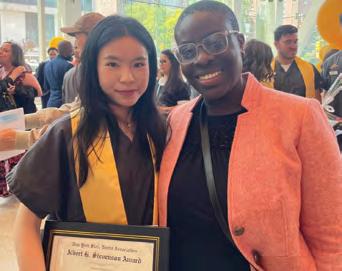
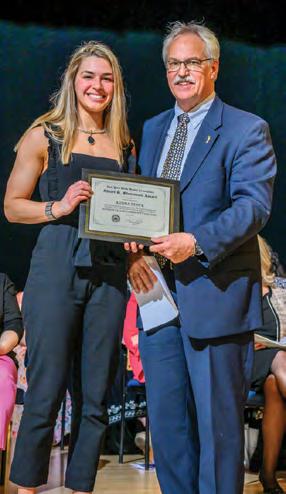
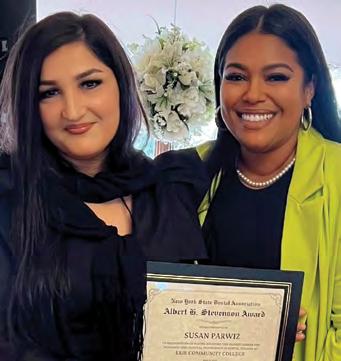
THE NEW YORK STATE DENTAL ASSOCIATION continued its tradition of recognizing an outstanding graduating student from each of the state’s dental hygiene schools with the presentation of the Albert H. Stevenson Award. This award is given to a graduating student who displays the leadership qualities and enthusiasm that Dr. Stevenson gave to the field of oral hygiene.
Dr. Stevenson proudly communicated the importance of the oral hygiene field and advocated to have dental hygiene recognized as a licensed profession. The dental hygiene profession as it stands today is due, in part, to Dr. Stevenson’s tireless dedication.

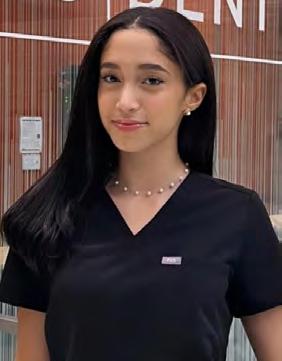
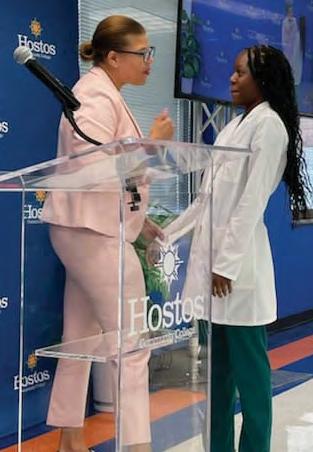
The 2023 recipients of NYSDA’s Albert H. Stevenson Award are: Khine Zar Than, New York City College of Technology; Audra Stote, Hudson Valley Community College; Shayna Fick, Broome Community College; Sierra Donnelly, Monroe Community College; Susan Parwiz, Erie Community College; Lea Picchianti, Orange County Community College; Ronesha Singleton, Hostos Community College of the City University of New York; Michelle Soussan, State University of New York at Farmingdale; Danna El Awdan, NYU College of Dentistry.
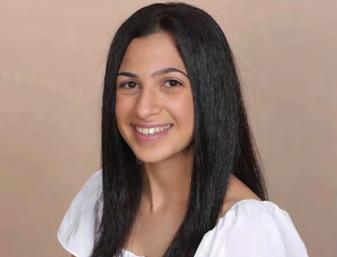
ADDENDUM
Susan Parwiz, recipient, left. Marlyce James, presenter. Erie Community College.
Danna El Awdan, NYU College of Dentistry.
Shayna Fick, Broome Community College.
Michelle Soussan, Farmingdale State College.
Khine Zar Than, recipient, left. Tricia Quartey-Sagaille, presenter.
Amarilis Jacobo, presenter, left. Ronesha Singleton, recipient. Hostos Community College.
52 JUNE/JULY 2023 The New York State Dental Journal
Audra Stote, recipient, left. Wayne Harrison, presenter. Hudson Valley Community College.
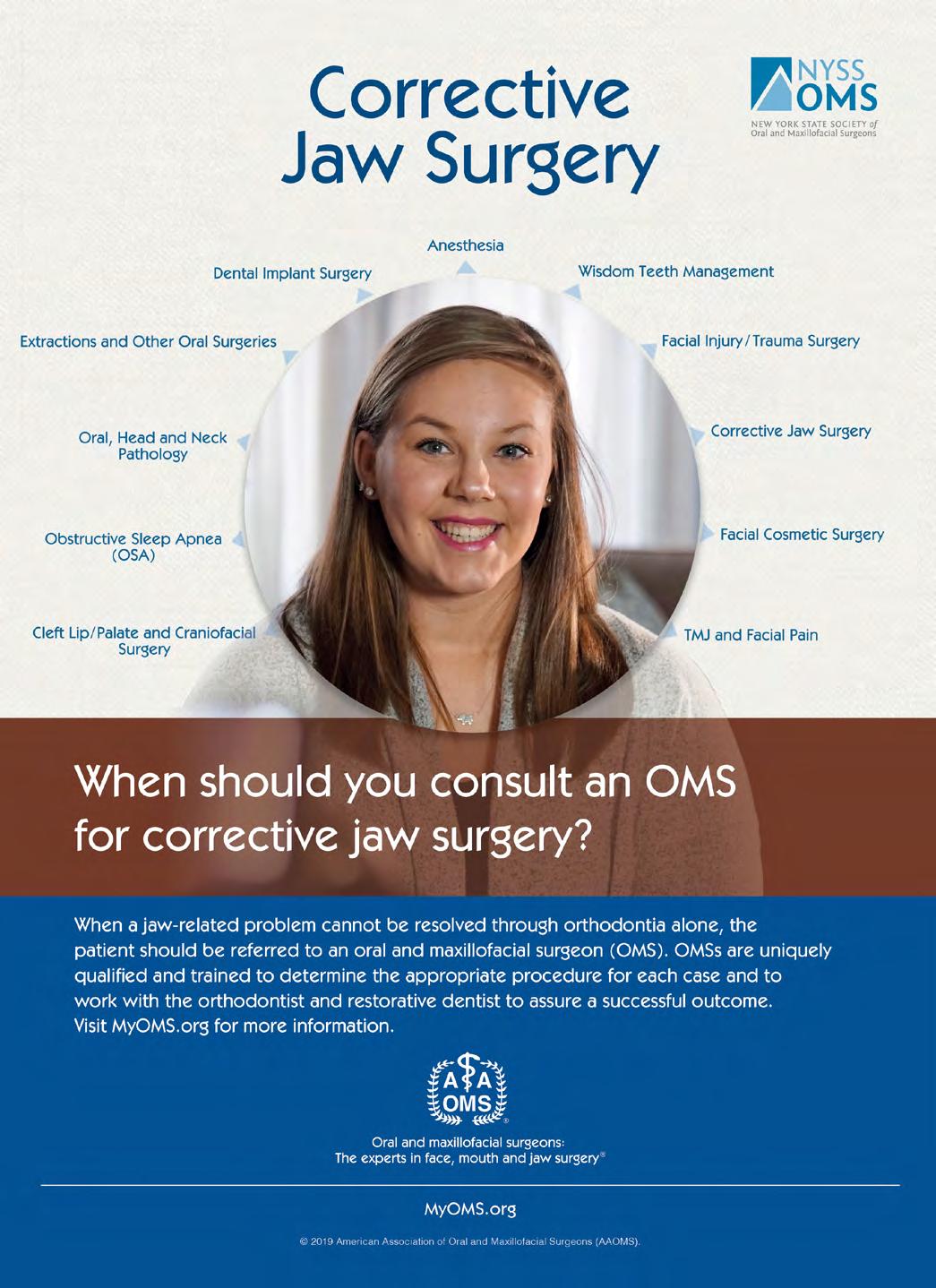
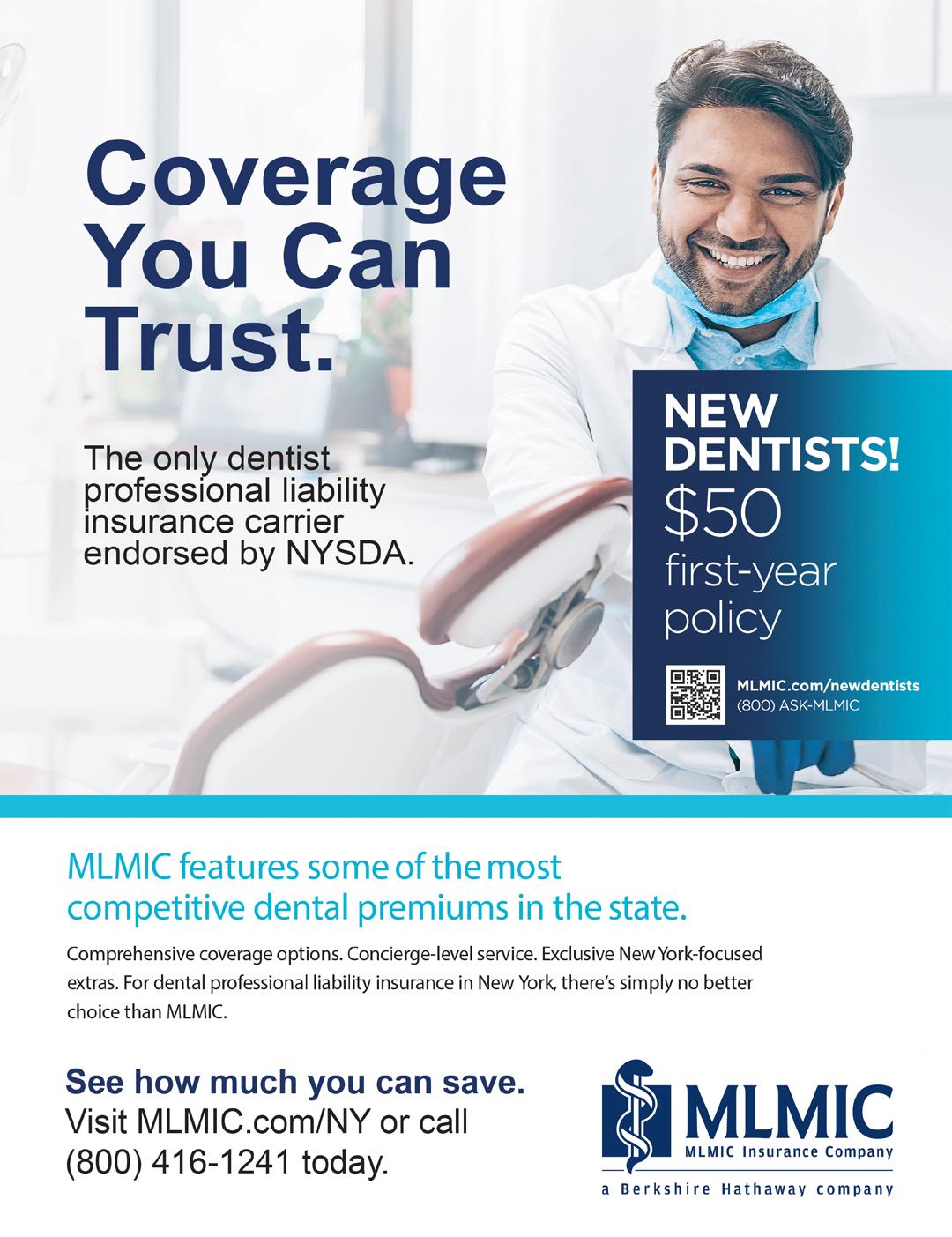





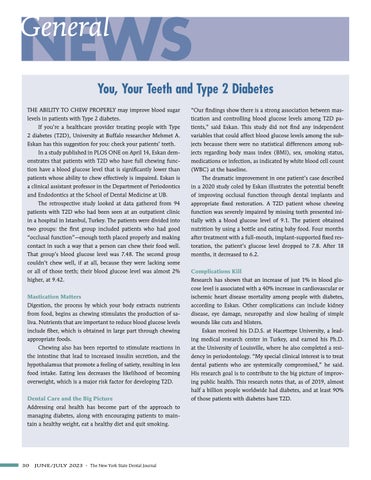




 David Miller
David Miller






 Cuomo children. From left, Anthony Jr., Nicole, Matthew, Christopher.
Anthony Cuomo and wife, Patricia. Married when he was in dental school, the couple has been together for over 50 years.
In New Orleans for meeting of ADA House, Cuomo visited famed creole restaurant Commander’s Palace with Daniel Doyle, current president of Ninth District.
Cuomo children. From left, Anthony Jr., Nicole, Matthew, Christopher.
Anthony Cuomo and wife, Patricia. Married when he was in dental school, the couple has been together for over 50 years.
In New Orleans for meeting of ADA House, Cuomo visited famed creole restaurant Commander’s Palace with Daniel Doyle, current president of Ninth District.



 lary left permanent first molar region (Figure 2A).
Figure 1: (A) Bleeding localized to lower right quadrant, from distal segment (black arrow) of gingival sulcus of lower right permanent first molar, post-removal of currant jelly-like clot. (B) Imaging revealed intact restorations and no radiolucencies or pathology. Close proximity of distal margin of preformed metal crown on lower right permanent first molar to dental follicle of lower right permanent second molar was noted (white arrow). (C) Area surrounding lower right permanent first molar with hemostasis achieved using local hemostatic measures.
lary left permanent first molar region (Figure 2A).
Figure 1: (A) Bleeding localized to lower right quadrant, from distal segment (black arrow) of gingival sulcus of lower right permanent first molar, post-removal of currant jelly-like clot. (B) Imaging revealed intact restorations and no radiolucencies or pathology. Close proximity of distal margin of preformed metal crown on lower right permanent first molar to dental follicle of lower right permanent second molar was noted (white arrow). (C) Area surrounding lower right permanent first molar with hemostasis achieved using local hemostatic measures.





























 Figure 3. Prevalence of TMJ disorders by gender. Incidence of breakdown (A) osteophyte (B) sclerosis (C) flattening (D) and cysts (E) did not significantly differ between
Figure 1. CBCT scans of patients with TMJ disorders. (A) Normal (41/F, coronal view). (B) Possible subchondral cyst (84/F, coronal view). (C) Breakdown (40/M, coronal view). (D) Flattening (58/F, coronal view). (E) Normal (41/F, sagittal view). (F) Sclerosis (68/F, sagittal view). (G) Osteophyte (69/F, sagittal view).
Figure 3. Prevalence of TMJ disorders by gender. Incidence of breakdown (A) osteophyte (B) sclerosis (C) flattening (D) and cysts (E) did not significantly differ between
Figure 1. CBCT scans of patients with TMJ disorders. (A) Normal (41/F, coronal view). (B) Possible subchondral cyst (84/F, coronal view). (C) Breakdown (40/M, coronal view). (D) Flattening (58/F, coronal view). (E) Normal (41/F, sagittal view). (F) Sclerosis (68/F, sagittal view). (G) Osteophyte (69/F, sagittal view).











 President Stephen Akseizer, right, presents certificate of appreciation to Dr. Howard Golan, presenter of lecture on lasers at General Membership Meeting.
President-Elect Doug Schildhaus with young patients he encountered on medical/dental mission to Peru.
Dr. Schildhaus with his team of medical/dental volunteers on mission to Andes Mountains of Peru.
President Stephen Akseizer, right, presents certificate of appreciation to Dr. Howard Golan, presenter of lecture on lasers at General Membership Meeting.
President-Elect Doug Schildhaus with young patients he encountered on medical/dental mission to Peru.
Dr. Schildhaus with his team of medical/dental volunteers on mission to Andes Mountains of Peru.









 Vera W.L. Tang, D.D.S.
Vera W.L. Tang, D.D.S.
 Rosemeire Santos-Teachout.
Special Smiles volunteers at New York Metro Games Special Olympics May 20.
Columbia College of Dental Medicine Class of 2023 gather at NYCDS to celebrate their success.
Rosemeire Santos-Teachout.
Special Smiles volunteers at New York Metro Games Special Olympics May 20.
Columbia College of Dental Medicine Class of 2023 gather at NYCDS to celebrate their success.












 SDDS sponsored and occupied two tables at NYS Dental Foundation luncheon, held during NYSDA House meeting.
SDDS caucus members captured during proceedings of NYSDA House.
SDDS sponsored and occupied two tables at NYS Dental Foundation luncheon, held during NYSDA House meeting.
SDDS caucus members captured during proceedings of NYSDA House.


























